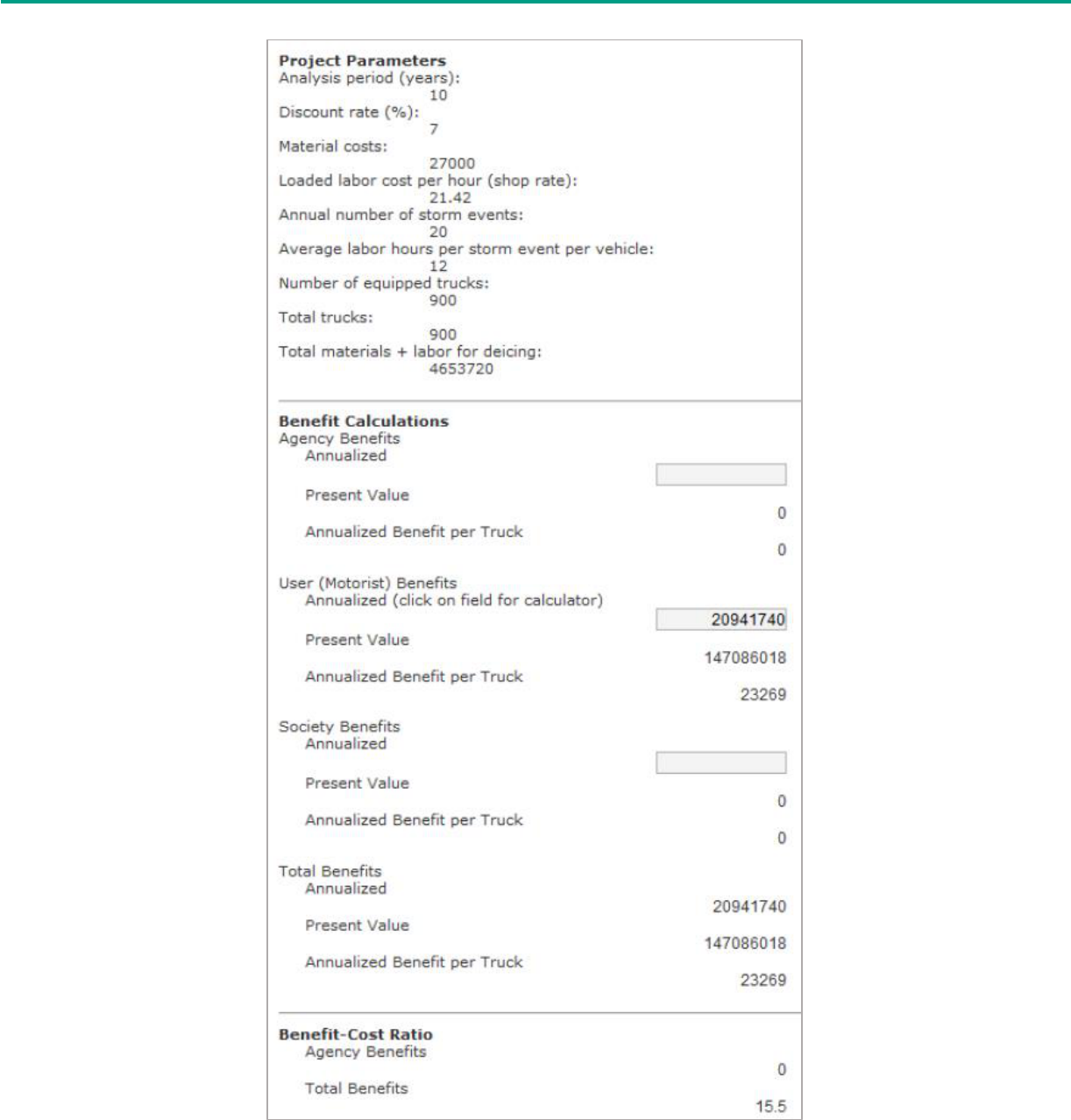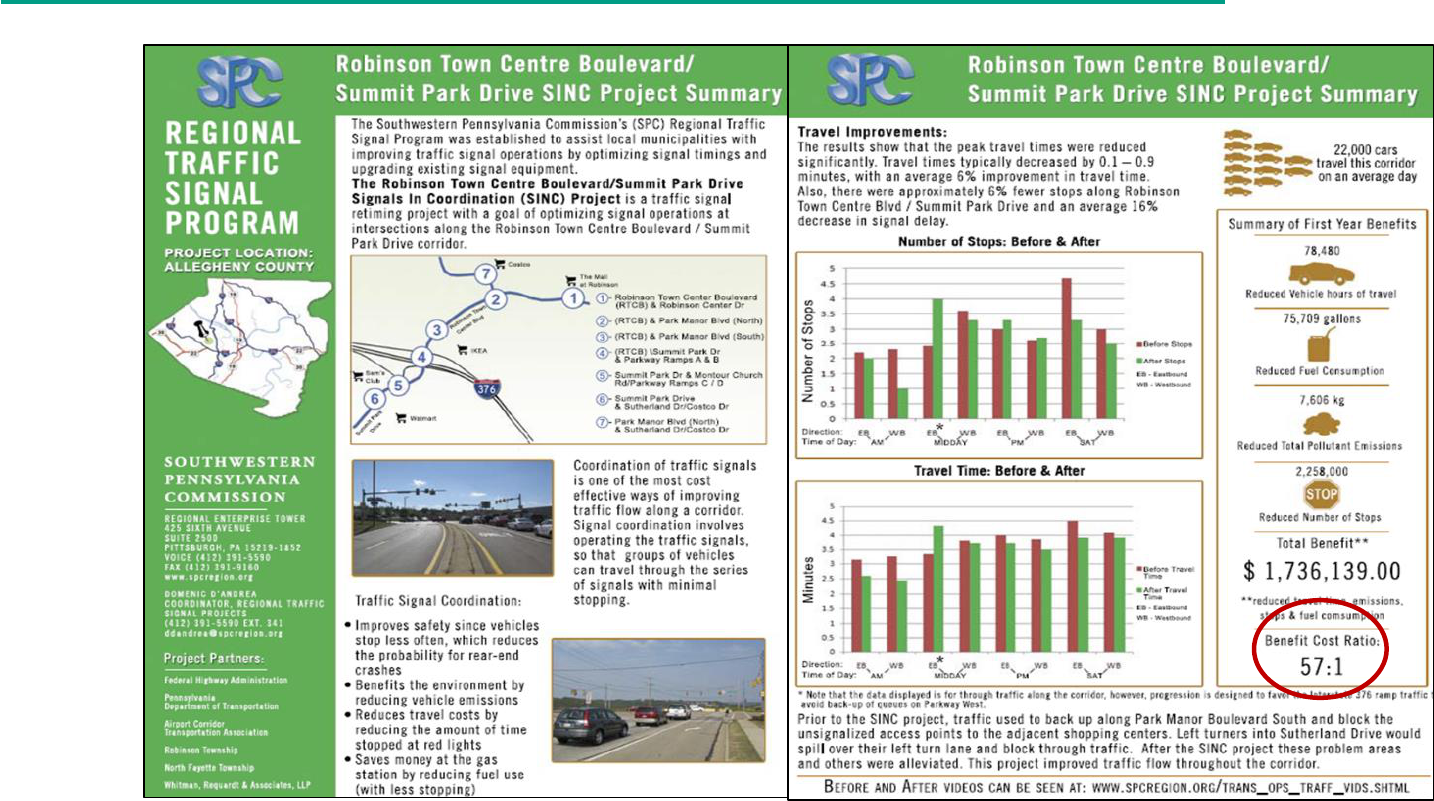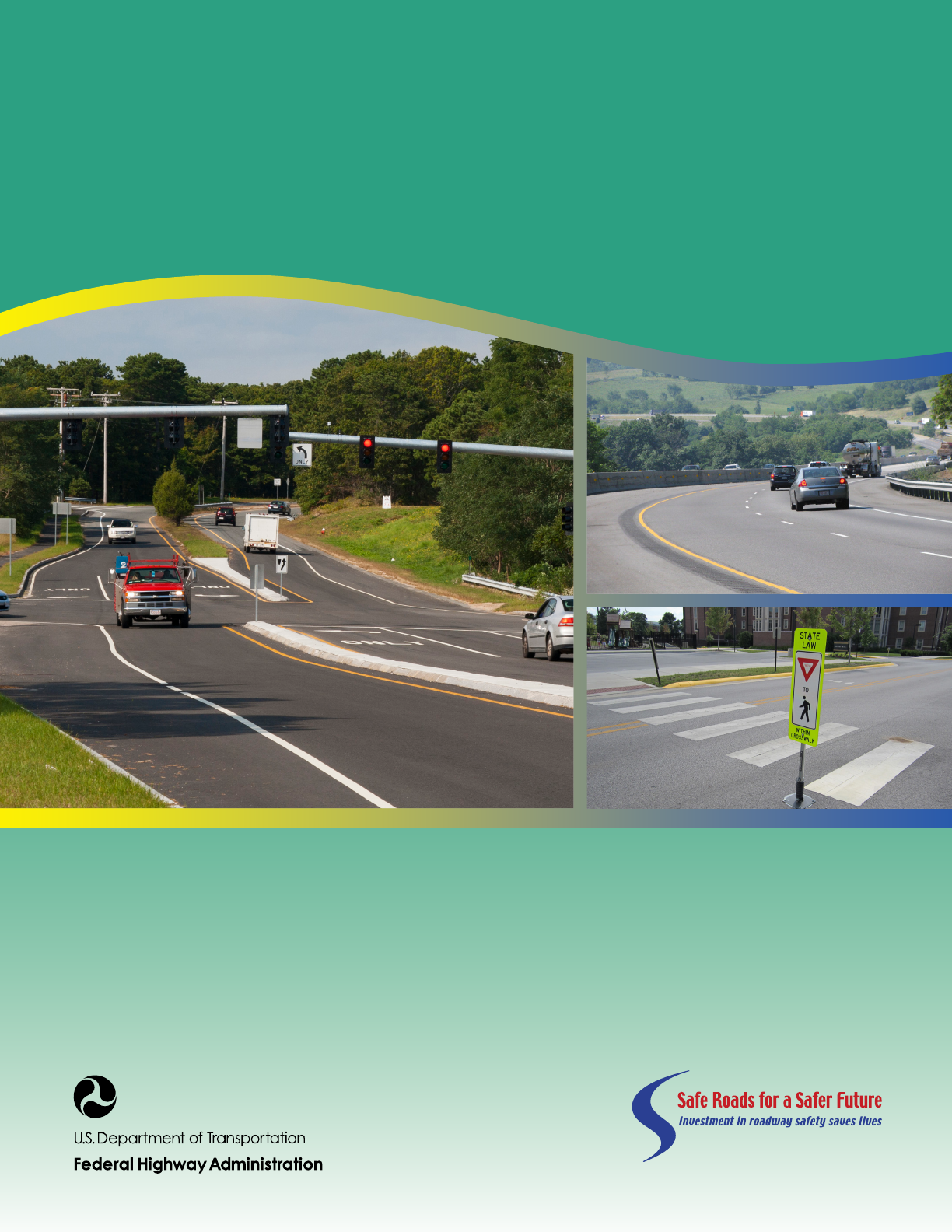
Highway Safety Benefit–Cost
Analysis Guide
http://safety.fhwa.dot.gov
FHWA Safety Program

HIGHWAY SAFETY BENEFIT COST ANALYSIS GUIDE
FOREWORD
The purpose of the Highway Safety Benefit-Cost Analysis Guide (this Guide) is to assist
transportation agencies in making consistent and theoretically sound decisions for economically
evaluating and ranking safety countermeasures. Transportation professionals can use the
methods described to analyze both site-specific and systemic safety approaches with single or
multiple countermeasures. This Guide is intended as a user-friendly technical reference which
transportation professionals can use with no prior experience with economic evaluation
techniques. This Guide provides example calculations throughout the document to assist
transportation professionals in understanding benefit-cost analysis (BCA) concepts and applying
them for safety applications.
NOTICE
This document is disseminated under the sponsorship of the U.S. Department of
Transportation in the interest of information exchange. The U.S. Government assumes no
liability for the use of the information contained in this document.
The U.S. Government does not endorse products or manufacturers. Trademarks or
manufacturers’ names appear in this report only because they are considered essential to the
objective of the document.
QUALITY ASSURANCE STATEMENT
The Federal Highway Administration (FHWA) provides high-quality information to serve
Government, industry, and the public in a manner that promotes public understanding.
Standards and policies are used to ensure and maximize the quality, objectivity, utility, and
integrity of its information. FHWA periodically reviews quality issues and adjusts its programs
and processes to ensure continuous quality improvement.

HIGHWAY SAFETY BENEFIT COST ANALYSIS GUIDE
TECHNICAL DOCUMENTATION PAGE
1. Report No.
FHWA-SA-18-001
2. Government Accession
No.
3. Recipient's Catalog No.
4. Title and Subtitle
Highway Safety Benefit-Cost Analysis Guide
5. Report Date
February 2018
6. Performing Organization Code
7.Author(s)
Michael Lawrence, Alan Hachey, Geni Bahar, and Frank Gross
8. Performing Organization Report No.
9. Performing Organization Name and Address
VHB
Venture I
940 Main Campus Drive, Suite 500
Raleigh, NC 27606
10. Work Unit No.
11. Contract or Grant No.
DTFH61-16-D-00005 (VHB)
12. Sponsoring Agency Name and Address
Federal Highway Administration Office of Safety
1200 New Jersey Ave., SE
Washington, DC 20590
13. Type of Report and Period
Final Draft Report, August 2016-
February 2018
14. Sponsoring Agency Code
FHWA
15. Supplementary Notes
The contract manager for this report was Karen Scurry, FHWA. The task was led by Jack Faucett Associates.
16. Abstract
The purpose of the Highway Safety Benefit-Cost Analysis (BCA) Guide is to assist transportation agencies in making
consistent and sound investment decisions. The target audience includes transportation professionals such as traffic
engineers, highway safety engineers, and planners conducting highway safety BCA for projects and programs. This Guide
will help these users to quantify the costs, and direct and indirect safety-related benefits of project alternatives. Direct
safety benefits include the expected change in crash frequency and severity. Indirect benefits include the operational and
environmental benefits that result from a reduction in crashes (e.g., reduced delay, fuel use, and emissions). Readers will
understand the methods, data requirements, and considerations associated with BCA. Examples demonstrate the application
of the methods in various scenarios, including both site-specific and systemic projects with single or multiple
countermeasures. Conducting consistent and reliable BCA will support decision making, optimize the return on
investments, and increase the effectiveness of projects and programs.
17. Key Words:
safety, economic analysis, lifecycle analysis,
benefit-cost analysis, crash cost
18. Distribution Statement
No restrictions.
19. Security Classif. (of this report)
Unclassified
20. Security Classif. (of this
page) Unclassified
21. No. of Pages
160
22. Price
Form DOT F 1700.7 (8-72) Reproduction of completed pages authorized

HIGHWAY SAFETY BENEFIT COST ANALYSIS GUIDE
ii
ACKNOWLEDGEMENTS
The authors would like to thank the Technical Advisory Committee (TAC) of the Highway
Safety Manual Implementation Transportation Pooled-Fund Study for providing input and
recommendations on the organization and content of this Guide. The TAC has been invaluable
in identifying areas of the greatest need for guidance as well as reviewing the guidance materials
and application of the techniques presented. The TAC is comprised of individuals representing
State transportation agencies throughout the United States.

HIGHWAY SAFETY BENEFIT COST ANALYSIS GUIDE
iii

HIGHWAY SAFETY BENEFIT COST ANALYSIS GUIDE
iv
TABLE OF CONTENTS
1. Overview of Guide ................................................................................................... 1
1.1 Introduction and Purpose .................................................................................................................1
1.2 Target Audience ..................................................................................................................................2
1.3 Structure of the Guide .......................................................................................................................2
2. Overview of BCA for Safety .................................................................................... 3
2.1 What is Benefit-Cost Analysis? ........................................................................................................3
2.2 What is Safety Management? ............................................................................................................4
2.3 Economic Measures for BCA ...........................................................................................................7
2.4 Use of Highway Safety BCA in Safety Management and Project Development ................. 10
2.5 Highway Safety BCA Resources ................................................................................................... 14
2.6 Chapter Summary ............................................................................................................................ 17
3. Introduction to Project Costs ................................................................................ 19
3.1 Initial Costs ........................................................................................................................................ 20
3.2 Continuing Costs ............................................................................................................................. 20
3.3 Rehabilitation and End-of-Life Costs ........................................................................................... 21
3.4 Data Sources for Project Costs .................................................................................................... 22
3.5 Chapter Summary ............................................................................................................................ 22
4. Introduction to Project Benefits and Externalities .............................................. 23
4.1 Safety ................................................................................................................................................ 24
4.2 Travel Time ....................................................................................................................................... 30
4.3 Travel Time Reliability .................................................................................................................... 34
4.4 Vehicle Operating Costs ................................................................................................................ 38
4.5 Externalities ....................................................................................................................................... 40
4.6 Chapter Summary ............................................................................................................................ 44
5. Preparing for a BCA............................................................................................... 47
5.1 Developing the Project Base Condition...................................................................................... 47
5.2 Setting an Analysis Period .............................................................................................................. 50
5.3 Evaluating Uncertainty..................................................................................................................... 51
5.4 Discounting ........................................................................................................................................ 53
5.5 Challenges and Opportunities ....................................................................................................... 56
5.6 Chapter Summary ............................................................................................................................ 59

HIGHWAY SAFETY BENEFIT COST ANALYSIS GUIDE
v
6. Conducting BCA for Safety ................................................................................... 61
6.1 Estimating Safety Benefits ............................................................................................................... 61
6.2 Estimating Travel Time Benefits.................................................................................................... 71
6.3 Estimating Travel Time Reliability Benefits ................................................................................. 73
6.4 Estimating Vehicle Operating Cost Benefits .............................................................................. 75
6.5 Estimating Emissions Benefits ........................................................................................................ 77
6.6 Chapter Summary ............................................................................................................................ 78
7. Project Applications ............................................................................................... 79
7.1 Single Countermeasure Example .................................................................................................. 79
7.2 Multiple Countermeasure Example #1 ....................................................................................... 94
7.3 Multiple Countermeasure Example #2 ..................................................................................... 103
7.4 Multiple Sites (Systemic) Example .............................................................................................. 112
8. Communicating BCA Results .............................................................................. 129
8.1 Considerations for Presenting BCA Results ............................................................................ 129
8.2 Example Summaries of BCA Results ......................................................................................... 130
8.3 Chapter Summary .......................................................................................................................... 137
9. Summary .............................................................................................................. 139
References .................................................................................................................. 143
Appendix A: Glossary of Terms ................................................................................ 147

HIGHWAY SAFETY BENEFIT COST ANALYSIS GUIDE
vi
LIST OF TABLES
Table 1. Cost and benefit categories. ........................................................................................................... 4
Table 2. Comparison of economic appraisal measures. ........................................................................... 7
Table 3. Economic information for example project locations. .......................................................... 11
Table 4. BCR ranking of example project locations for Alternative 1. ............................................. 11
Table 5. NPV ranking of example project locations for Alternative 2. ............................................. 12
Table 6. Alternative 1 and Alternative 2 economic comparison. ....................................................... 12
Table 7. AIS injury codes.
(21)
........................................................................................................................ 27
Table 8. Frequently asked questions and answers for applying crash costs. .................................... 28
Table 9. Comprehensive crash costs (2017 U.S. $). .............................................................................. 30
Table 10. NHTSA recommended values of travel time (2017 U.S. $)
(11)
.......................................... 32
Table 11. TIGER recommended values of travel time by type (2017 U.S. $).
(23)
............................. 33
Table 12. TIGER recommended values of driver time (2017 U.S. $).
(23)
........................................... 33
Table 13. Reliability performance measures.
(27)
....................................................................................... 36
Table 14. Estimated value of net emissions per fatal crash (2017 dollars).
(11)
.................................. 42
Table 15. Estimated value of net emissions per injury crash (2017 dollars).
(11)
............................... 43
Table 16. Estimated value of net emissions per PDO crash (2017 dollars).
(11)
................................ 43
Table 17. Overview of methods to estimate safety performance of base condition. .................... 50
Table 18. Frequently asked questions and answers for applying crash costs. .................................. 56
Table 19. Example application of CMFs by severity. .............................................................................. 64
Table 20. Example application of crash costs by severity. .................................................................... 65
Table 21. Example of local severity distribution for total crashes...................................................... 66
Table 22. Example of combining CMFs. .................................................................................................... 70
Table 23. Example application of CMFs for multiple countermeasures. ........................................... 71
Table 24. Vehicle delay hours by crash severity and roadway type (per crash).
(11)
........................ 72
Table 25. Example monetization of travel time for a project on a rural principal arterial
(NHTSA methodology). ............................................................................................................................... 72
Table 26. Net increase in and cost of fuel consumption per fatal crash.
(11)
...................................... 75
Table 27. Net increase in and cost of fuel consumption per injury crash.
(11)
................................... 76
Table 28. Net increase in and cost of fuel consumption per PDO crash.
(11)
.................................... 76
Table 29. Example monetization of fuel-related vehicle operating cost for a project on a rural
principal arterial (NHTSA methodology). ................................................................................................ 77

HIGHWAY SAFETY BENEFIT COST ANALYSIS GUIDE
vii
Table 30. Example monetization of emissions for a project on a rural principal arterial (NHTSA
methodology).................................................................................................................................................. 78
Table 31. Project costs for single countermeasure example, 2017 present value $. ..................... 81
Table 32. Amortization table for maintenance costs. ............................................................................ 82
Table 33. Estimated change in crashes by severity for alternative 1 (traffic signal). ....................... 83
Table 34. Estimated change in crashes by severity for alternative 2 (roundabout). ....................... 84
Table 35. Monetary safety benefit for alternative 1 (traffic signal). .................................................... 85
Table 36. Monetary safety benefit for alternative 2 (roundabout). .................................................... 85
Table 37. Monetary travel time benefit for alternative 1 (traffic signal). ........................................... 86
Table 38. Monetary travel time benefit for alternative 2 (roundabout). ........................................... 86
Table 39. Travel time reliability inputs for single countermeasure example. ................................... 87
Table 40. Monetary fuel-related benefit for alternative 1 (traffic signal)........................................... 88
Table 41. Monetary fuel-related benefit for alternative 2 (roundabout)........................................... 89
Table 42. Monetary emissions benefit for alternative 1 (traffic signal). ............................................. 90
Table 43. Monetary emissions benefit for alternative 2 (roundabout). ............................................. 90
Table 44. BCA results for single countermeasure example. ................................................................ 91
Table 45. Amortization table of project benefits for alternative 1 (traffic signal). .......................... 92
Table 46. Amortization table of project benefits for alternative 2 (roundabout). .......................... 93
Table 47. Project costs for multiple countermeasure example #1, 2017 present value $. .......... 94
Table 48. Estimated change in crashes by severity for multiple countermeasure example #1
(shoulder widening and shoulder rumble strips). ................................................................................... 96
Table 49. Monetary safety benefit for multiple countermeasure example #1 (shoulder widening
and shoulder rumble strips). ....................................................................................................................... 97
Table 50. Monetary travel time benefit for multiple countermeasure example #1 (shoulder
widening and shoulder rumble strips). ...................................................................................................... 98
Table 51. Travel time reliability inputs for multiple countermeasure example #1 (shoulder
widening and shoulder rumble strips). ...................................................................................................... 99
Table 52. Monetary fuel-related benefit for multiple countermeasure example #1 (shoulder
widening and shoulder rumble strips). .................................................................................................... 100
Table 53. Monetary emissions benefit for multiple countermeasure example #1 (shoulder
widening and shoulder rumble strips). .................................................................................................... 101
Table 54. BCA results for multiple countermeasure example #1. ................................................... 102
Table 55. Amortization table of project benefits for multiple countermeasure example #1
(shoulder widening and shoulder rumble strips). ................................................................................. 102

HIGHWAY SAFETY BENEFIT COST ANALYSIS GUIDE
viii
Table 56. Project costs for multiple countermeasure example #2 (shoulder widening and safety
edge), 2017 present value $. ..................................................................................................................... 103
Table 57. Estimated combined CMF by severity for multiple countermeasure example #2
(shoulder widening and safety edge). ...................................................................................................... 104
Table 58. Estimated change in crashes by severity for multiple countermeasure example #2
(shoulder widening and safety edge). ...................................................................................................... 106
Table 59. Monetary safety benefit for multiple countermeasure example #2 (shoulder widening
and safety edge). ........................................................................................................................................... 107
Table 60. Monetary travel time benefit for multiple countermeasure example #2 (shoulder
widening and safety edge). ......................................................................................................................... 108
Table 61. Monetary fuel-related benefit for multiple countermeasure example #2 (shoulder
widening and safety edge). ......................................................................................................................... 109
Table 62. Monetary emissions benefit for multiple countermeasure example #2 (shoulder
widening and safety edge). ......................................................................................................................... 110
Table 63. BCA results for multiple countermeasure example #2. ................................................... 111
Table 64. Amortization table of project benefits for multiple countermeasure example #2
(shoulder widening and safety edge). ...................................................................................................... 111
Table 65. Summary of curves for multiple sites example. .................................................................. 112
Table 66. Project cost for multiple sites example, 2017 present value $. ...................................... 113
Table 67. Estimated long-term average crashes for multiple sites example. .................................. 114
Table 68. Estimated crashes by severity for multiple sites example. ............................................... 115
Table 69. Estimated change in crashes by severity for multiple sites example. ............................. 116
Table 70. Monetary safety benefit for multiple sites example. .......................................................... 118
Table 71. Monetary travel time benefit for multiple sites example. ................................................. 120
Table 72. Monetary fuel-related benefit for multiple sites example................................................. 122
Table 73. Monetary emissions benefit for multiple sites example. ................................................... 124
Table 74. Summary of annual monetary benefits for multiple sites example. ................................ 126
Table 75. BCA results for multiple sites example. ............................................................................... 127
Table 76. Amortization table of project benefits for multiple sites example. ................................ 127
Table 77. BCA results for multiple sites example. ............................................................................... 137

HIGHWAY SAFETY BENEFIT COST ANALYSIS GUIDE
ix
LIST OF FIGURES
Figure 1. Chart. Roadway safety management process. ........................................................................... 6
Figure 2. Equation. Cost-effectiveness index. ............................................................................................. 8
Figure 3. Equation. Benefit-cost ratio. .......................................................................................................... 8
Figure 4. Equation. Net present value. ......................................................................................................... 9
Figure 5. Chart. Recurring travel time measurement versus actual traveler experience.
(26)
........ 35
Figure 6. Chart. Relationship of travel time measures and reliability.
(28)
........................................... 37
Figure 7. Equation. Example SPF. ................................................................................................................ 48
Figure 8. Chart. Time series of costs and benefits (in constant dollars).
(8)
....................................... 53
Figure 9. Equation. Standard formula for discounting. .......................................................................... 54
Figure 10. Equation. Discount factor. ........................................................................................................ 54
Figure 11. Equation. Summation of discounted values. ......................................................................... 55
Figure 12. Equation. Estimating crashes for a single countermeasure. .............................................. 63
Figure 13. Equation. Additive method for estimating the combined benefit of multiple
countermeasures. .......................................................................................................................................... 67
Figure 14. Equation. Dominant common residuals method for estimating the combined benefit
of multiple countermeasures. ..................................................................................................................... 68
Figure 15. Equation. Multiplicative method for estimating the combined benefit of multiple
countermeasures. .......................................................................................................................................... 68
Figure 16. Equation. Example conversion of annual cost to present value cost for year 21
(Alternative 1). ............................................................................................................................................... 81
Figure 17. Equation. Example conversion of annual safety benefit to present value benefit for
year 21 (alternative 1)................................................................................................................................... 91
Figure 18. Equation. Example conversion of annual safety benefit to present value benefit for
year 8 (multiple countermeasure example #1). .................................................................................... 101
Figure 19. Equation. Dominant common residuals method for estimating the combined effect of
shoulder widening and safety edge on KABC crashes. ....................................................................... 105
Figure 20. Equation. Dominant common residuals method for estimating the combined effect of
shoulder widening and safety edge on PDO crashes........................................................................... 105
Figure 21. Equation. Example conversion of annual safety benefit to present value benefit for
year 7 (multiple countermeasure example #2). .................................................................................... 110
Figure 22. Equation. SPF for rural, two-lane base segments. ............................................................. 113
Figure 23. Equation. CMF for horizontal curve on rural, two-lane road. ....................................... 114
Figure 24. Equation. Example conversion of annual safety benefit to present value benefit for
curve 1 in year 5 (multiple sites example). ............................................................................................ 126

HIGHWAY SAFETY BENEFIT COST ANALYSIS GUIDE
x
Figure 25. Chart. Tabular and graphical BCA results from Highway Safety BCA Tool. .............. 131
Figure 26. Chart. Tabular BCA results from TOPS-BC tool.
(37)
........................................................ 132
Figure 27. Chart. Tabular BCA results from Clear Roads cost-benefit tool.
(38)
............................ 133
Figure 28. Chart. Graphical BCA results from Kansas City SCOUT.
(39)
......................................... 134
Figure 29. Chart. Newsletter display of BCA results from Southwestern Pennsylvania Regional
Signal Program.
(9)
.......................................................................................................................................... 135
Figure 30. Chart. Multidimensional graphical BCA results from the Metropolitan Transportation
Commission.
(9)
.............................................................................................................................................. 136

HIGHWAY SAFETY BENEFIT COST ANALYSIS GUIDE
xi
ACRONYMS
AADT Annual Average Daily Traffic
AIS Abbreviated Injury Scale
BCA Benefit-Cost Analysis
BCR Benefit-Cost Ratio
CFR Code of Federal Regulations
CMAQ Congestion Mitigation and Air Quality
CMF Crash Modification Factor
EA Environmental Assessment
EIS Environmental Impact Statement
EPA Environmental Protection Agency
FHWA Federal Highway Administration
HSIP Highway Safety Improvement Program
KABCO National Safety Council Injury Scale
LCCA Life-Cycle Cost Analysis
MMUCC Model Minimum Uniform Crash Criteria
MPO Metropolitan Planning Organization
NCHRP National Cooperative Highway Research Program
NEPA National Environmental Policy Act
NHTSA National Highway Traffic Safety Administration
NPV Net Present Value
OMB Office of Management and Budget
PDO Property Damage Only
PHT Person Hours of Travel
SHRP2 Second Strategic Highway Research Program
SPF Safety Performance Function
TAC Technical Advisory Committee
TRB Transportation Research Board
USDOT United States Department of Transportation
VMT Vehicle Miles Traveled
VOC Volatile Organic Compound
VSL Value of a Statistical Life

HIGHWAY SAFETY BENEFIT COST ANALYSIS GUIDE
xii
EXECUTIVE SUMMARY
Transportation agencies must continuously justify the economic effectiveness of their programs
and expenditures. Economically effective and efficient projects are particularly important for
safety programs that establish aggressive targets and require greater fiscal responsibility and
stewardship to achieve these goals. Further, transportation professionals routinely assess and
prioritize projects based on costs and benefits related to pavement preservation, operational
performance, and environmental impacts. While guidance and tools are available to analyze the
direct safety-related benefits and costs of projects, there is a need to consider the complete
lifecycle cost and benefits of all projects, including the indirect safety-related benefits.
There are many reasons to perform a benefit-cost analysis (BCA) for transportation projects.
Some funding programs require BCA (e.g., TIGER and INFRA grants), while other agencies
establish a policy or procedure to perform BCA. In either case, the following are specific
benefits to employing BCA in the roadway safety management and project development
processes:
• Best Return on Investment: Economic analysis can help in planning, programming,
and implementing transportation programs with the best rate of return for any given
budget. It can also help to determine an optimal program budget.
• Cost-Effective Design and Construction: Economic analysis can inform agencies as
to which of several project designs to implement at the lowest lifecycle cost to the
agency, lowest delay cost to the traveler, highest safety benefit to users, and the best
affordable balance between these costs.
• Understanding Complex Projects: In a time of growing public scrutiny of new and
costly road projects, transportation agencies and other decision makers need to
understand the comprehensive costs and benefits of these projects. A rigorous BCA can
help to quantify and compare the impacts of project alternatives on safety, mobility, the
environment, and regional economies.
• Documentation of Decision Process: The discipline of quantifying and valuing the
benefits and costs of highway projects also provides documentation to justify and
explain the decision process to legislatures and the public.
The Highway Safety Benefit-Cost Analysis Guide provides agencies with the knowledge, tools,
and insights to perform reliable highway safety BCA and communicate the results. For those
new to BCA, this Guide introduces the BCA process and describes fundamental concepts and
factors to consider when preparing for BCA. For those familiar with BCA, this Guide can help
to enhance current practices through a discussion of common challenges and opportunities to
overcome those challenges. This Guide also defines typical project costs and benefits included
in BCA and provides default values to monetize these benefits. This Guide provides instruction

HIGHWAY SAFETY BENEFIT COST ANALYSIS GUIDE
xiii
and examples of how to estimate and monetize safety-related project benefits, including the
expected change in crashes and the resulting operational and environmental benefits. Finally,
this Guide provides considerations and examples related to the communication of BCA results.
In summary, BCA is critical to understanding the potential return on investment from potential
projects and programs. While BCA is a policy or procedural decision, this Guide can help
agencies to understand the value of performing BCA, consider the data requirements and
resources to perform BCA, and determine the specific format and parameters of the analysis.
This Guide can also help transportation professionals perform reliable BCA and use the results
to inform decisions and improve investments.

HIGHWAY SAFETY BENEFIT COST ANALYSIS GUIDE CHAPTER 1
1
1. OVERVIEW OF GUIDE
1.1 INTRODUCTION AND PURPOSE
This Guide focuses on the safety benefits of competing engineering projects (i.e., expected
difference in crash frequency and severity) and the benefits derived from differences in safety
performance (e.g., reduced delay, travel time, and emissions because of fewer crashes). While
safety is a key factor in transportation decision-making, agencies may consider many factors in
project selection and programming. The following is a list of other potential factors an agency
may consider during project selection and programming:
• Other planned projects at the location (for safety improvement or otherwise).
• Right-of-way needs and acquisition.
• Operational efficiency.
• Environmental impacts and mitigation.
• Economic impacts.
• Social equity (distribution of investments across select population groups).
• Project readiness.
• Familiarity with the treatment’s design, construction, and potential impacts.
• Public requests for improvement projects.
• Public acceptance and perception.
This Guide explains how to quantify the monetary benefits associated with expected differences
in safety among project alternatives, and the indirect operational and environmental benefits
(i.e., operational and environmental impacts that result from a change in safety performance). It
focuses on project-level analysis of single or multiple improvements at a given location. It also
covers network-level analysis for projects that include multiple locations (e.g., systemic
improvements). This Guide focuses on economic analysis and only briefly discusses project
prioritization within a program. It does not address behavioral measures or the direct benefits
related to operations and the environment (i.e., those benefits not derived from a change in
safety performance). Agencies may use other methods and tools to quantify the benefits of
behavioral measures and non-safety factors (e.g., microsimulation to estimate operational
impacts; noise and emissions models to estimate environmental impacts). Some of these non-
safety factors (e.g., public acceptance) may be difficult to quantify and will require subjective
weights to prioritize projects.
While this Guide provides methods and default values to monetize the direct and indirect
safety benefits of alternatives, a benefit-cost analysis (BCA) is a policy or procedural decision

HIGHWAY SAFETY BENEFIT COST ANALYSIS GUIDE CHAPTER 1
2
where an agency defines the parameters. Agencies should develop a prioritization process that
meets their specific needs, integrating quantitative safety and non-safety factors as needed.
A BCA is a policy or procedural decision where an
agency defines the parameters.
1.2 TARGET AUDIENCE
This Guide is intended to meet the needs of transportation professionals conducting highway
safety BCA for projects and programs. Transportation professionals, such as traffic and safety
engineers or planners, are the target audience for this Guide. This Guide assumes these
professionals are not economists and may not have formal training in economic evaluation
techniques. Thus, this Guide describes basic concepts and terminology relating to BCA to
support the needs of transportation professionals who may be new to BCA.
1.3 STRUCTURE OF THE GUIDE
This Guide is organized into nine chapters and an appendix. Chapter 2 introduces fundamental
concepts of BCA and safety management, defines economic measures for BCA, provides an
overview of BCA in the safety management and project development process, and identifies
several related resources. Chapter 3 introduces project costs, including the costs to design,
construct, operate, maintain, and rehabilitate the project. Chapter 4 introduces project
benefits, identifying types of benefits included in highway safety BCA and default values to
monetize benefits. Chapter 5 identifies factors to consider when preparing for BCA such as the
base condition, analysis period, potential for uncertainty in the underlying data and analysis
results, and discount rate. Chapter 6 describes how to estimate and monetize safety-related
project benefits, including the expected change in crashes and the resulting change in
operational and environmental measures. Chapter 7 presents hypothetical examples of BCA for
projects with single countermeasures, multiple countermeasures, and multiple locations.
Chapter 8 presents considerations and options for communicating BCA results to decision-
makers. Chapter 9 presents a summary of this Guide with key takeaways. Appendix A provides
a glossary of terms.
Complementary to this Guide, a spreadsheet-based BCA tool was developed to complete a
BCA in accordance with the methods, assumptions, and data sources described in this Guide.
The purpose of the Tool is to assist transportation professionals in generating results for
presentation to colleagues, management, and the public. The Tool provides the framework for
an efficient and repeatable process that facilitates communication of the results to diverse
audiences.

HIGHWAY SAFETY BENEFIT COST ANALYSIS GUIDE CHAPTER 2
3
2. OVERVIEW OF BCA FOR SAFETY
A BCA is a key component of a comprehensive project or program development process that
considers quantitative and qualitative impacts of highway investments. Transportation agencies
use these economic evaluation techniques to identify, quantify, and assign value to the economic
benefits and costs of highway projects and programs over multiyear timeframes. This chapter
introduces fundamental concepts of BCA and the safety management process, defines economic
measures for BCA, provides an overview of BCA in the safety management process and project
development process, and identifies several related resources.
Chapter 2 At-A-Glance
Chapter 2 is divided into six sections:
• Section 2.1 defines BCA.
• Section 2.2 defines safety management, including the crash-based approach, the systemic
approach, and how these two complementary approaches provide a comprehensive
approach to safety management.
• Section 2.3 introduces economic measures used to compare and rank alternatives,
including present value cost (PVC), present value benefit (PVB), benefit-cost ratio
(BCR), net present value (NPV), cost-effectiveness index (CEI), and payback period.
• Section 2.4 describes the use of BCA in safety management, including the use of BCA to
achieve the most efficient or effective project.
• Section 2.5 provides a brief description of several highway safety BCA resources.
• Section 2.6 provides a summary of the chapter.
2.1 WHAT IS BENEFIT-COST ANALYSIS?
A BCA is a systematic process for calculating and comparing the benefits and costs of project
alternatives.
(1)
A BCA attempts to capture all benefits to society from a project or course of
action, and the cost to achieve those benefits, regardless of which party realizes the benefits
and costs, or the form of these benefits and costs. Using BCA, transportation professionals can
compare present value costs and benefits among alternatives for a given analysis period. Used
properly, BCA reveals the most economically-efficient investment alternative (i.e., the one that
maximizes the net benefits to society relative to the allocation of resources).
A BCA is systematic process for calculating and
comparing benefits and costs of a project.
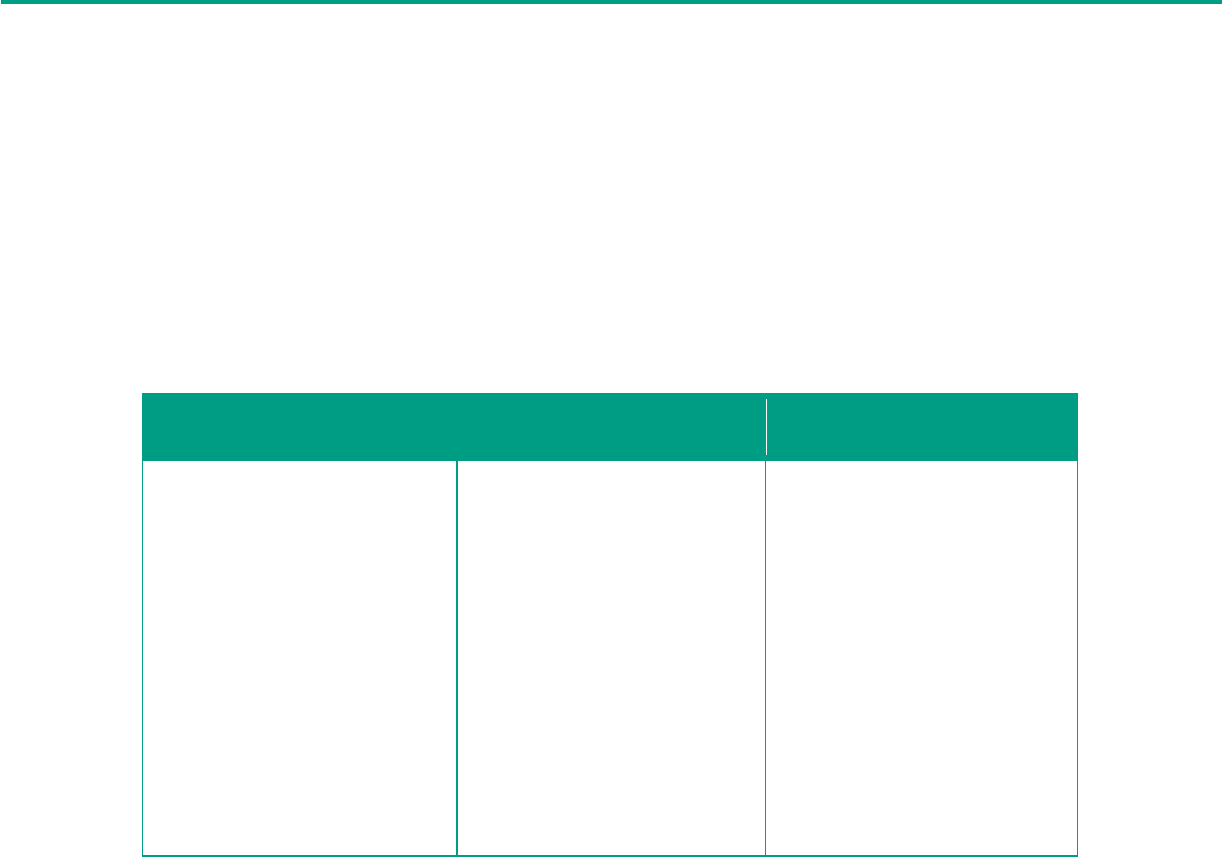
HIGHWAY SAFETY BENEFIT COST ANALYSIS GUIDE CHAPTER 2
4
A BCA differentiates costs and benefits by project costs (or agency costs), project benefits (or
user benefits), and externalities (or non-user benefits). Project benefits and externalities include
costs avoided, but also include negative benefits (disbenefits) such as increased crashes or air
emissions. Analysts monetize project benefits by assigning dollar values to the different effects.
For example, if there is an expected change in crash frequency associated with a project
alternative, compared to the base condition (e.g., the do-nothing alternative), then the analyst
multiplies the expected change in crashes by the average cost of a crash. If there are negative
impacts, then these appear as negative benefits. Table 1 summarizes common project costs,
project benefits, and externalities.
Table 1. Cost and benefit categories.
Project Costs
(Agency Costs)
Project Benefits
(User Benefits)
Externalities
(Non-User Benefits)
• Design and engineering.
• Land acquisition.
• Construction.
• Reconstruction/
Rehabilitation.
• Preservation.
• Routine maintenance.
• Mitigation (e.g., noise
barriers).
• Utility relocation.
• Energy.
• Reduced travel time and
delay.
• Improved travel time
reliability.
• Reduced crash frequency
and/or severity.
• Reduced vehicle
operating cost.
• Reduced air emissions.
• Reduced noise.
• Reduced impacts to
natural habitat and
wetlands.
2.2 WHAT IS SAFETY MANAGEMENT?
Safety management typically comprises three components: planning, implementation, and
evaluation. More specifically, this includes the identification of opportunities for safety
improvement, the implementation of projects to target the identified safety opportunities, and
the evaluation of implemented projects to understand the effectiveness of investments.
Safety management includes planning,
implementation, and evaluation.
There are two general approaches to safety management: 1) selecting and treating sites based
on site-specific crashes (also referred to as the crash-based approach in this Guide), and 2)
selecting and treating sites based on site-specific geometric and operational attributes
associated with increased crash potential (referred to as the systemic approach in this Guide).

HIGHWAY SAFETY BENEFIT COST ANALYSIS GUIDE CHAPTER 2
5
The crash-based and systemic approaches are complementary and support a comprehensive
approach to safety management. To be the most effective, both approaches should focus on
sites with the greatest potential for safety improvement (i.e., preventing future crashes and
reducing fatalities and injuries). For both approaches, it is important to use repeatable and
reliable, data-driven methods such as BCA to inform decisions.
2.2.1 Crash-Based Approach
The crash-based approach involves the identification and evaluation of individual locations with
high potential for safety performance improvement. Transportation agencies use data analysis
techniques to identify locations where a safety improvement opportunity exists and to select
appropriate countermeasures that target site-specific crash-contributing factors.
In the crash-based approach, analysts identify sites based on crash-based performance
measures. The more rigorous crash-based measures use the empirical Bayes (EB) method to
incorporate crash predictions from safety performance functions (SPFs) and site-specific crash
history. Once an agency identifies a list of sites, a multidisciplinary analysis team performs a
detailed review of site-specific crash history and characteristics (e.g., road users, adjacent land
use, geometry, and traffic operations) to identify target crash types and crash-contributing
factors. This provides the foundation for the identification and selection of appropriate
countermeasures to mitigate the specific safety issues (e.g., crash patterns and contributing
factors) at each site.
(2,3,4)
2.2.2 Systemic Approach
The FHWA defines a systemic roadway safety improvement as a proven safety countermeasure
that is widely implemented based on high-risk roadway features that are correlated with
particular severe crash types (23 CFR 924.3).
(5)
FHWA describes systemic projects as having
the following characteristics:
(6)
• Safety opportunities identified through system-wide data, such as rural lane departure
crashes, urban pedestrian crashes, or rural unsignalized intersection crashes. Often,
these opportunities spread across a roadway network.
• Similar projects across a network to address high priority crash types and risk factors.
• Target specific roadway characteristics such as geometry, volume, or location frequently
present in severe crashes.
• Improvements with proven countermeasures on sites identified by the presence of
roadway factors correlated with specific crash types rather than site-specific crashes.
• Generally low-cost improvements (e.g., enhanced signing or striping, rumble strips, or
signal heads upgrades). Higher-cost improvements are candidates for the systemic
approach, but the improvement should be highly effective to justify the increased cost.

HIGHWAY SAFETY BENEFIT COST ANALYSIS GUIDE CHAPTER 2
6
The following section describes the roadway safety management process that is generally
applicable to both the crash-based and systemic approach.
2.2.3 Roadway Safety Management Process
The roadway safety management process is a six-step process as shown in Figure 1 and outlined in
the Highway Safety Manual.
(7)
Figure 1. Chart. Roadway safety management process.
The objectives of this process are as follows.
(4)
1. Network Screening: Identify locations that could benefit from treatments to improve
safety performance (i.e., reduce crash frequency and severity).
2. Diagnosis: Understand collision patterns and crash contributing factors.
3. Countermeasure Selection: Identify, assess, and select appropriate countermeasures to
target crash contributing factors and reduce crash frequency and severity at locations with
potential for improvement.
4. Economic Appraisal: Estimate the economic cost and benefit associated with a particular
countermeasure or set of countermeasures. This Guide focuses on the use of BCA in
economic appraisal to consider the relative costs and benefits among alternatives.
Step 1
Network Screening
Step 2
Diagnosis
Step 3
Countermeasure
Selection
Step 4
Economic Appraisal
Step 5
Project Prioritzation
Step 6
Safety Effectiveness
Evaluation

HIGHWAY SAFETY BENEFIT COST ANALYSIS GUIDE CHAPTER 2
7
5. Project Prioritization: Develop a prioritized list of projects to improve the safety
performance (i.e., reduce crash frequency and severity) of the road network,
considering available resources. Project prioritization involves policy-level decisions such
as overall agency goals and may include multiple (and sometimes competing) factors
such as safety, operational efficiency, environmental impacts, and equity. This Guide
does not cover project prioritization.
6. Safety Effectiveness Evaluation: Evaluate how a project (or group of projects) has
affected the safety performance of the treated location(s) and the system. The evidence-
based safety effectiveness estimates developed in step 6 (safety effectiveness evaluation)
support future decisions.
The roadway safety management process is an integral part of the project development
process. While the roadway safety management process focuses on safety performance, the
results of countermeasure selection, economic appraisal, and project prioritization feed into the
project development process (i.e., system planning, project planning, project design and
construction, and system operations and maintenance).
2.3 ECONOMIC MEASURES FOR BCA
Agencies can use various measures, indices, and factors to compare and select among project
alternatives. Table 2 lists common economic measures for BCA. Three of these measures
(indicated in bold) directly compare monetary benefits and costs, which is needed to accurately
assess the cost-effectiveness of project alternatives. Following the table is a detailed description
of each measure.
Table 2. Comparison of economic appraisal measures.
Economic Measure
Considers
Costs
Considers
Benefits
Considers Monetary
Costs and Benefits
Present value cost (PVC)
Yes
No
No
Present value benefit (PVB)
No
Yes
No
Cost-effectiveness index (CEI)
Yes
Yes
No
Benefit-cost ratio (BCR)
Yes
Yes
Yes
Net present value (NPV)
Yes
Yes
Yes
Payback period
Yes
Yes
Yes

HIGHWAY SAFETY BENEFIT COST ANALYSIS GUIDE CHAPTER 2
8
2.3.1 Present Value Costs (PVC)
The PVC is the present value of all costs incurred from implementing a project over the service
life (e.g., engineering, right-of-way, construction, maintenance, change in road user costs). A
positive value of PVC represents funds expended; a negative value represents a savings or influx
of funds.
2.3.2 Present Value Benefits (PVB)
The PVB is the monetized present value of the expected change in crashes from implementing a
project (i.e., expected change in crashes multiplied by average crash costs). Benefits may include
all crashes, although some agencies only consider the changes to fatal and serious injury crashes
(or other crash type and/or severity combinations). A positive PVB represents a crash
reduction; a negative value represents an increase in crashes.
2.3.3 Cost-Effectiveness Index (CEI)
The CEI is the average cost of a project to reduce one crash. The CEI is calculated by dividing
the PVC by the expected number of crashes reduced over the service life of the project as
shown in Figure 2. In general, a low CEI is desirable. The CEI is typically based on total crashes,
but can be expressed in terms of a specific crash type or severity level (e.g., cost to reduce one
fatal and serious injury crash). The CEI does not account for the monetary benefits. As such, it
is not an appropriate measure to justify projects economically. It can, however, serve as a
measure when it is difficult to monetize benefits (e.g., when an agency has not adopted crash
cost values).
Figure 2. Equation. Cost-effectiveness index.
2.3.4 Benefit-Cost Ratio (BCR)
The BCR is the ratio of present value benefits (including negative benefits) to present value
costs (initial and continuing costs over the project lifecycle), as shown in Figure 3. In this
context, the BCR is the same as the rate of return and return on investment. A BCR greater
than 1.0 indicates that benefits exceed costs, and the project is economically justified. In
general, a higher BCR is desirable. The BCR is most appropriate for prioritizing alternatives
when funding restrictions apply (e.g., prioritizing countermeasures or locations within a project
with a fixed budget).
Figure 3. Equation. Benefit-cost ratio.

HIGHWAY SAFETY BENEFIT COST ANALYSIS GUIDE CHAPTER 2
9
2.3.5 Net Present Value (NPV)
The NPV is the difference between present value benefits and present value costs, as shown in
Figure 4. NPV is also sometimes called net benefits or net present worth. If the NPV is greater
than 0.0, then the benefits exceed the costs, and the project is economically justified. In general,
a higher NPV is desirable. An agency can use NPV to determine the alternative with the highest
benefits for a given project.
Figure 4. Equation. Net present value.
2.3.6 Payback Period
The payback period is the length of time, in years, to reach the breakeven point on the
investment, measured from the end of construction to when the PVB equals the PVC.
2.3.7 Summary of Economic Measures
The BCR and NPV are generally the most appropriate measures to assess and prioritize project
alternatives in highway safety BCA. The BCR is insensitive to the magnitude of net benefits;
therefore, it may prioritize projects with relatively lower costs and benefits over those with
higher net benefits. The use of NPV can help to identify projects with the higher net benefits.
The payback period does not consider the full extent of benefits (i.e., only up to the value of
costs).
The United States Department of Transportation (USDOT) recommends the use of BCR or
NPV for most economic evaluations.
(8)
Analysts may consider a combination of measures (e.g.,
BCR and NPV) or other available BCA measures (e.g., equivalent uniform annual value
approach or internal rate of return) depending on the policy or preference of the agency. Refer
to resources such as the Transportation Systems Management and Operations Benefit-Cost
Analysis Compendium for definitions of the equivalent uniform annual value approach and
internal rate of return.
(9)
Chapter 7 illustrates the use of the BCR and NPV to assess
alternatives through practical applications of BCA in various scenarios.
The BCR and NPV are often the most appropriate
economic measures to assess alternatives.

HIGHWAY SAFETY BENEFIT COST ANALYSIS GUIDE CHAPTER 2
10
2.4 USE OF HIGHWAY SAFETY BCA IN SAFETY MANAGEMENT AND
PROJECT DEVELOPMENT
The safety management process and project development process often include the comparison
of multiple project alternatives. This may include alternative designs for a specific location or
alternative locations as part of a systemic improvement project. Highway safety BCA helps to
compare the cost-effectiveness of alternative designs, and enables decision-makers, planners,
highway designers, and traffic engineers to consider safety-motivated projects in conjunction
with resurfacing, rehabilitation, reconstruction, and expansion projects.
Decision-makers use BCA to compare the cost-
effectiveness of alternatives or projects.
Highway safety BCA can indicate which alternative provides the most efficient or effective
safety benefit to highway users. The most efficient (i.e., most cost-effective) alternative
provides the largest benefit per dollar spent (i.e., highest BCR). The most effective alternative
provides the largest net benefit to the public (i.e., highest NPV).
In general, this Guide focuses on the use of BCA in economic appraisal to quantify, assess, and
compare the costs and benefits of alternatives for a specific location. Specifically, this Guide will
help users to quantify project benefits and costs to determine the most efficient and effective
alternative. While BCA is essential to conducting economic appraisal, the results are also useful
in project prioritization (i.e., the comparison of alternative projects as part of a program). This
Guide covers project prioritization in the context of prioritizing alternatives within a project.
This includes projects with multiple alternatives where some of the alternatives are subsets of a
more comprehensive alternative. Further, this applies to the selection of a subset of multiple
potential locations in a systemic improvement project. The following sections compare the use
of BCR and NPV measures in prioritizing alternatives within a project to achieve the most
efficient or effective project.
2.4.1 Prioritizing Locations to Achieve the Most Efficient Project
The efficiency of a project is assessed by the return on investment (i.e., the value achieved per
dollar spent), and the BCR is an appropriate measure to achieve the most efficient project. To
illustrate the use of BCR for achieving the most efficient safety improvement project, consider a
group of 10 potential project locations. Table 3 shows the monetary benefits, costs, NPV, and
BCR for each potential project location. Improvements are economically-justified at all potential
locations (i.e., BCR greater than 1.0 and a positive NPV). Suppose the budget for this
hypothetical systemic safety project is $80,000. Ranking the locations by BCR and NPV will
illustrate the effectiveness of each measure in developing Alternative 1 and Alternative 2,
respectively.

HIGHWAY SAFETY BENEFIT COST ANALYSIS GUIDE CHAPTER 2
11
Table 3. Economic information for example project locations.
Location #
Benefits
Costs
NPV
BCR
1
$90,000
$30,000
$60,000
3.00
2
$50,000
$25,000
$25,000
2.00
3
$67,500
$20,000
$47,500
3.38
4
$100,000
$40,000
$60,000
2.50
5
$15,000
$7,500
$7,500
2.00
6
$60,000
$10,000
$50,000
6.00
7
$40,000
$10,000
$30,000
4.00
8
$25,000
$10,000
$15,000
2.50
9
$25,000
$5,000
$20,000
5.00
10
$15,000
$5,000
$10,000
3.00
Table 4 lists the priority ranking of locations by BCR. Locations for Alternative 1 are selected
from the top of the list until the budget is filled. Rows shaded gray indicate locations that do
not fit within the budget.
Table 4. BCR ranking of example project locations for Alternative 1.
Location #
Benefits
Costs
NPV
BCR
6
$60,000
$10,000
$50,000
6.00
9
$25,000
$5,000
$20,000
5.00
7
$40,000
$10,000
$30,000
4.00
3
$67,500
$20,000
$47,500
3.38
1
$90,000
$30,000
$60,000
3.00
10
$15,000
$5,000
$10,000
3.00
4
$100,000
$40,000
$60,000
2.50
8
$25,000
$10,000
$15,000
2.50
2
$50,000
$25,000
$25,000
2.00
5
$15,000
$7,500
$7,500
2.00
Table 5 lists the priority ranking of locations by NPV. Locations for Alternative 2 are selected
from the top of the list until the budget is filled. Rows shaded gray indicate projects that do not
fit within the budget.

HIGHWAY SAFETY BENEFIT COST ANALYSIS GUIDE CHAPTER 2
12
Table 5. NPV ranking of example project locations for Alternative 2.
Location #
Benefits
Costs
NPV
BCR
1
$90,000
$30,000
$60,000
3
4
$100,000
$40,000
$60,000
2.5
6
$60,000
$10,000
$50,000
6
3
$67,500
$20,000
$47,500
3.375
7
$40,000
$10,000
$30,000
4
2
$50,000
$25,000
$25,000
2
9
$25,000
$5,000
$20,000
5
8
$25,000
$10,000
$15,000
2.5
10
$15,000
$5,000
$10,000
3
5
$15,000
$7,500
$7,500
2
Table 6 provides a comparison of the economic measures for selected locations in Table 4 and
Table 5, representing Alternative 1 and Alternative 2, respectively. Bold numbers indicate the
preferred alternative. Alternative 1, developed using the BCR, is clearly the preferred set of
locations as it provides the highest benefits, NPV, and BCR. Alternative 1 provides the most
efficient project because it results in the greatest benefits within a fixed cost.
Table 6. Alternative 1 and Alternative 2 economic comparison.
Economic Measure
Alternative 1
Alternative 2
Total Benefits
$297,500
$250,000
Total Costs
$80,000
$80,000
NPV
$217,500
$170,000
BCR
3.72
3.13
2.4.2 Prioritizing Locations to Determine the Most Effective Project
The effectiveness of a project is assessed by the overall benefits (i.e., the total value achieved),
which is indicated by the highest NPV. When the budget of a project is fixed, and assuming that
funds are expended up to the budget limit, the most efficient project is also the most effective.
Again, the BCR is an appropriate measure to achieve the most efficient and effective project
given a fixed budget. This section describes how to achieve the most effective project without
consideration of budget.

HIGHWAY SAFETY BENEFIT COST ANALYSIS GUIDE CHAPTER 2
13
While prioritizing potential locations using BCR yields the most efficient (cost-effective) project,
in some cases agencies and the public may desire an economically-justified project with the
highest possible benefits, regardless of the cost-efficiency of the investment. For example,
stakeholders may call for additional spending to provide the greatest possible crash reduction at
a high-profile site with an extraordinary crash history. The most cost-effective alternative may
provide only a marginal reduction in crashes. Additionally, given the BCR ranking can favor a
larger number of smaller-scale improvements at multiple locations, some agencies may decide
to pursue fewer, more effective improvements to reduce the burden of project management.
Prioritization by NPV yields a ranking of maximum benefits in each alternative. However, as
illustrated in the previous section, ranking by NPV can reduce the cost-effectiveness of the
overall project and can guide funds towards less efficient investments. When selecting the most
effective alternative with NPV, agencies may be ignoring the most cost-effective alternatives
(i.e., the funds could have been spent on more efficient projects). If there were no budgetary
limitations, NPV is the preferred prioritization measure.
2.4.3 Prioritizing Project Locations Without Monetized Benefits
In some scenarios, the monetary value of benefits cannot be determined or is not used in
analysis. For example, if the severity distribution of the expected crash reduction is not well
known, an agency may not be comfortable applying average crash costs to estimate the
monetary benefits. In this case, the CEI is a suitable measure for prioritizing project locations.
This measure incorporates the monetary costs with non-monetary benefits (i.e., change in the
number of crashes). The CEI does not allow for direct consideration of non-safety benefits.
2.4.4 Optimizing Project Locations within a Program
Optimization is the process of organizing prioritized projects within program budget limitations
and other constraints to maximize program effectiveness over time. Optimization methods use
mathematical models to maximize the benefits of projects, both monetary and non-monetary,
without exceeding the available budget. Optimization occurs after the initial economic analysis
and includes only those projects that are economically-justified. As such, it does not affect the
procedures described in the previous sections.
There are several optimization methods with various capabilities and constraints, including
linear programming, integer programming, and dynamic programming. These methods are
consistent with maximizing the BCR of a safety program. Integer programming is the most
applicable to project optimization, where each project is either implemented or not. Refer to
the Highway Safety Manual for further discussion of optimization methods.
(7)

HIGHWAY SAFETY BENEFIT COST ANALYSIS GUIDE CHAPTER 2
14
2.5 HIGHWAY SAFETY BCA RESOURCES
In addition to this Guide, the FHWA and State transportation agencies have produced
numerous technical references relating to BCA. This section provides an overview of selected
resources.
2.5.1 Highway Safety Manual
The Highway Safety Manual presents a science-based technical approach to conduct safety
analysis for transportation facilities, including methods to predict the change in crashes resulting
from the implementation of safety countermeasures.
(7)
The Highway Safety Manual provides
methods for developing an effective roadway safety management program and evaluating its
effects. The Highway Safety Manual provides tools to conduct quantitative safety analyses,
allowing quantitative evaluation of safety alongside other transportation performance measures
such as traffic operations, environmental impacts, and construction costs. The target audience
of the Highway Safety Manual is a wide audience of transportation professionals at the State,
county, metropolitan planning organization (MPO), or local level.
The Highway Safety Manual includes an overview of BCA in Chapter 7, Economic Appraisal. In
addition, the Highway Safety Manual provides predictive methods to estimate crash frequency
and severity. The user can employ these methods to estimate predicted or expected crashes
for use in BCA.
2.5.2 Crash Costs for Highway Safety Analysis
The Crash Costs for Highway Safety Analysis guide describes the various sources of crash
costs, current practices and crash costs used by States, critical considerations when modifying
and applying crash unit costs, and an exploration of the feasibility of establishing national crash
unit cost values.
(10)
The guide proposes a new set of national crash unit costs and procedures to
1) update the crash unit costs over time, and 2) adjust the crash unit costs to States based on
State-specific cost of living, injury-to-crash ratios, and vehicle-to-crash ratio. This BCA guide
and the related tool incorporate the suggested national crash unit costs as default values.
2.5.3 The Economic and Societal Impact of Motor Vehicle Crashes
The National Highway Traffic Safety Administration (NHTSA) published this study in 2014, later
revised in 2015, representing the most recent research on the fiscal impact of motor vehicle
crashes. The Economic and Societal Impact of Motor Vehicle Crashes presents the results of
this research, quantifying the economic and societal costs resulting from motor vehicle crashes
recorded in 2010.
(11)
The costs include aggregate increases in air emissions, vehicle operating
costs, and travel time that result from crashes. This report provides perspective on the
economic losses and societal harm that result from crashes, and supports government and
private sector officials in structuring programs to reduce or prevent these losses. This BCA
Guide uses results from the NHTSA report to monetize project benefits and externalities.

HIGHWAY SAFETY BENEFIT COST ANALYSIS GUIDE CHAPTER 2
15
2.5.4 Economic Analysis Primer
USDOT developed the Economic Analysis Primer to provide a foundation for understanding
the role of economic analysis in highway decision-making.
(8)
The Primer is oriented toward State
and local officials who have responsibility for assuring that limited resources get targeted to
their best uses and who account publicly for their decisions. It presents economic analysis as an
integral component of a comprehensive infrastructure management approach that takes a long-
term view of infrastructure performance and cost. The primer is nontechnical in its descriptions
of economic methods, but it encompasses a full range of economic issues that are of potential
interest to transportation officials. This BCA Guide briefly describes the use of the discount
rate and risk analysis in highway safety BCA. Refer to the Primer for further details on these
and other fundamental economic analysis concepts.
2.5.5 Operations Benefit/Cost Analysis Desk Reference
The Operations Benefit/Cost Analysis Desk Reference provides background information on
BCA, including basic terminology and concepts.
(1)
The reference supports the needs of
practitioners, new to BCA, who may be unfamiliar with the general process. The reference
describes some of the more complex analytical concepts and latest research to support
transportation professionals in conducting more advanced analyses. This BCA Guide focuses on
the safety impacts of projects. If a safety project is also likely to impact operations, refer to the
Operations Benefit/Cost Analysis Desk Reference to consider additional benefits. Some of the
more advanced topics include capturing the impacts of travel time reliability, assessing the
synergistic effects of combining different strategies, and capturing the benefits and costs of
operations-supporting infrastructure such as traffic surveillance and communications.
2.5.6 Life-Cycle Cost Analysis Primer
This BCA Guide focuses on the comparison of both project benefits and costs in selecting and
prioritizing alternatives. Lifecycle cost analysis (LCCA) is an approach used to compare the
costs of project alternatives, assuming the agency has decided to implement a project at a given
location. Analysts should only use LCCA to compare project alternatives that would yield the
same benefits. For example, LCCA would be an appropriate tool to compare two alternative
bridge replacement designs that would result in the same level of service. Refer to the Life-
Cycle Cost Analysis Primer for further details on the use of LCCA in the evaluation of
alternative infrastructure investments.
(12)
The Primer demonstrates the value of such analysis in
making economically-sound decisions.
2.5.7 Benefit-Cost Analysis Guidance for TIGER and INFRA Applications
The Benefit-Cost Analysis Guidance for TIGER and INFRA Applications combines and expands
previous guidance provided for TIGER and FASTLane grant applications.
(13)
There are several

HIGHWAY SAFETY BENEFIT COST ANALYSIS GUIDE CHAPTER 2
16
inputs to BCA and this BCA Guide provides default values where appropriate; however, funding
programs often require specific values for parameters such as the discount rate, value of
statistical life, and value of time. The guidance provides technical information that grant
applicants need for monetizing benefits and costs for their (required) project BCA, as well as
guidance on BCA approach.
The appendices provide recommended monetary values and sample calculations.
(13)
One
appendix provides supplemental information, standard monetized values (where available), and
updates for preparing a BCA. The second appendix provides computational examples and
guidance on conducting an analysis. This guidance also refers to the Office of Management and
Budget (OMB) Circulars A-4 and A-94 in preparing analyses compliant with federal law.
2.5.8 Highway Safety Improvement Program Manual
The Highway Safety Improvement Program (HSIP) Manual describes the overall program
established by FHWA and the methods for developing a roadway safety management program
that focuses on results by emphasizing a data-driven, strategic approach to improving highway
safety through infrastructure-related improvements.
(14)
The HSIP Manual describes laws and
regulations, new and emerging technologies, and noteworthy practices for each of the HSIP’s
four basic steps: analyze data, identify potential countermeasures, prioritize and select projects,
and determine effectiveness. This reference is intended for State and local transportation safety
practitioners working on HSIPs and safety projects. The manual is useful in describing how BCA
fits into a transportation agency’s overall (federally-mandated) HSIP and the need for BCA in
the project prioritization process (Chapter 4 of the HSIP Manual).
2.5.9 Crash Modification Factor Clearinghouse
The BCA Guide and Tool incorporate the use of crash modification factors (CMFs) to estimate
safety benefits. The CMF Clearinghouse is a comprehensive and searchable database of
published CMFs for hundreds of different types of safety countermeasures.
(15)
Analysts use
CMFs to estimate expected changes in crash frequency and severity from implementing one or
more countermeasures. The Clearinghouse contains all CMFs published in the first edition of
the Highway Safety Manual as well as many CMFs published or documented in other sources.
The Clearinghouse provides information on available CMFs such as the CMF value, general
applicability, citation, and quality rating. The Clearinghouse provides links to additional
resources to assist CMF Clearinghouse users who are interested in obtaining guidance on other
topics related to CMFs such as how to select an appropriate CMF, how to apply CMFs, and
how to develop CMFs.

HIGHWAY SAFETY BENEFIT COST ANALYSIS GUIDE CHAPTER 2
17
2.6 CHAPTER SUMMARY
Chapter 2 describes fundamental concepts in BCA and safety management. It begins with an
overview of BCA and the types of costs (design, construction, operations, and maintenance)
and benefits (user benefits and externalities) included in BCA. It describes the safety
management process, including two complementary approaches to safety management: crash-
based and systemic. Next, the chapter defines several economic measures for use in project
decision-making. This is followed by a discussion of the role of BCA in safety management. The
chapter concludes with a description of several technical references for conducting highway
safety BCA.
Key Takeaways from Chapter 2:
• BCA is a systematic process for calculating and comparing benefits and costs of a
project.
• A BCA analyzes project costs (agency costs), project benefits (user benefits), and
externalities (non-user benefits) to compare alternatives.
• Project costs include the costs to design, construct, operate, maintain, and rehabilitate
the project.
• Project benefits include all benefits to users or society such as reduced crash frequency
and severity, reduced travel time and delay, improved travel time reliability, and reduced
vehicle operating costs. These can include negative benefits (disbenefits).
• Externalities include reduced air emissions, reduced noise, and reduced impacts to
natural habitat and wetlands.
• Safety management includes the identification of opportunities for safety improvement,
the implementation of projects to target the identified safety opportunities, and the
evaluation of implemented projects to understand the effectiveness of investments.
• A BCA supports decision-making in the safety management and project development
process, providing an opportunity to quantify and compare the safety performance and
related impacts of alternatives.
• Decision-makers can use BCA to compare the cost-effectiveness of alternatives and
identify the most economically-efficient or effective project alternative.
• The BCR and NPV are two common economic measures that incorporate both
monetized costs and benefits. The BCR is appropriate to identify the most efficient
project alternative. When the budget is fixed (e.g., a set amount of funds is available for
systemic improvements), and assuming that funds are expended up to the budget limit,
the most efficient project is also the most effective project.
• A BCA is a policy or procedural decision where an agency defines the parameters.

HIGHWAY SAFETY BENEFIT COST ANALYSIS GUIDE CHAPTER 2
18
THIS PAGE IS INTENTIONALLY LEFT BLANK

HIGHWAY SAFETY BENEFIT COST ANALYSIS GUIDE CHAPTER 3
19
3. INTRODUCTION TO PROJECT COSTS
FHWA defines project costs as the lifecycle costs of implementing and operating project
alternatives.
(12)
These lifecycle costs represent:
• Initial capital costs of implementing the project, including planning, design,
construction/installation, and equipment costs.
• Continuing operations and maintenance costs necessary to keep the project operational,
including items such as power, communications, labor, and routine maintenance
(excludes replacement costs).
• Replacement cost of equipment that reaches the end of its useful life.
• “End of Project” costs necessary to close temporary projects or any residual or salvage
value of equipment at the end of the time horizon of the analysis.
A common error in BCA is underestimating project costs. Analysts should develop a complete,
itemized list of initial, continuing, and planned rehabilitation and end-of-life costs. These costs
should include all public-sector and private-sector costs as well as contingencies and
administrative expenses (e.g., internal staff and overhead costs) as appropriate. If the analyst
does not include all major costs in the analysis, then the results may become unreliable and
incorrectly favor less efficient alternatives. For example, if the analyst does not consider right-
of-way acquisition for the construction of a left-turn lane or the maintenance of a cable median
barrier, then these projects may appear much more cost-effective than the agency will realize.
Project costs do not include expenses associated with project financing, such as depreciation
and interest payments. The BCA captures the equivalent value of such expenses through the
application of the discount rate (Section 5.4) to the project cost. Including depreciation or
interest expenses to project costs, in most cases, would double-count costs.
As projects advance through the project development process (e.g., planning to preliminary
design to final design), transportation agencies usually refine cost estimates. Agencies can repeat
and refine the BCA as better cost estimates become available, given there is value in the results
of the BCA. After project implementation, the agency can determine the actual costs and
observe the actual benefits. At this point, the agency may complete a final reevaluation of the
BCA. This reevaluation may also occur as part of larger program management efforts or when
an agency has completed a National Environmental Policy Act (NEPA) analysis (i.e., quantified
project externalities). This final evaluation provides insight to more accurately estimate costs
and benefits of future projects.

HIGHWAY SAFETY BENEFIT COST ANALYSIS GUIDE CHAPTER 3
20
Chapter 3 At-A-Glance
Chapter 3 is divided into five sections:
• Section 3.1 describes initial capital costs.
• Section 3.2 describes continuing operations and maintenance costs.
• Section 3.3 describes rehabilitation and end-of-life costs.
• Section 3.4 identifies data sources for project costs.
• Section 3.5 provides a summary of the chapter.
3.1 INITIAL COSTS
A project's initial costs are those incurred during project development and construction. These
costs may include any of the following:
• Planning, preliminary engineering, and assessment.
• Environmental impact reporting.
• Final engineering.
• Right-of-way acquisition.
• Utility impacts (e.g., relocation of power transmission lines).
• Construction of alternative.
• Construction engineering costs.
• Equipment and vehicle purchases.
• Decommissioning costs for existing facilities no longer needed because of the project
(e.g., decommissioning of a roadway bridge being replaced by a new bridge facility).
Engineers estimate these costs based on experience, bid prices, design specifications, material
costs, and other information. Equipment cost should be assigned to initial costs if the agency
does not possess the necessary equipment, but it is required for implementation or
maintenance of the project.
Initial costs are costs incurred during project
development and construction.
3.2 CONTINUING COSTS
The analyst should obtain, compile, and itemize continuing costs as part of project costs in BCA
calculations. Continuing costs include those for preventive activities (e.g., those performed to
maintain the project above some predetermined condition or performance level) and day-to-

HIGHWAY SAFETY BENEFIT COST ANALYSIS GUIDE CHAPTER 3
21
day routine maintenance intended to address safety and operational concerns. The following
are typical elements and examples of these costs:
• Labor, materials, and equipment for operations and maintenance activities.
• Equipment for operation (e.g., wireless transponders for electronic toll collection).
• Utility costs.
• Rent and lease payments.
• Emergency repairs (e.g., replacing damaged guardrail or sign supports).
Continuing costs include the costs for routine
operations and maintenance
3.3 REHABILITATION AND END-OF-LIFE COSTS
The analyst should compile and itemize rehabilitation and end-of-life costs to include as a
project cost. A project's rehabilitation costs include the future cost of repairs beyond routine
maintenance. For example, when a sign reaches the end of its useful life (i.e., retroreflectivity is
below the acceptable minimum threshold), then there is a need to replace the sign. This would
be considered a rehabilitation cost. Similarly, if the pavement deteriorates along a section of
road, there may be a need to rehabilitate the pavement along that section, beyond typical
maintenance activities.
Rehabilitation costs include repairs
beyond routine maintenance.
End-of-life costs are those costs incurred at the end of a project, or period of analysis. The
following are examples of end-of-life costs:
• Residual value (represented as a negative cost): The estimated value of project
assets at the end of the period of analysis, representing their expected value in
continuing use.
• Salvage value (represented as a negative cost): The estimated value of an asset in
cases where there exists a market for selling the asset.
• Close-out costs: Costs incurred at the end of the project's service life or operational
period, such as deconstruction costs, assuming the analysis period coincides with the
project's operation period.
End-of-life costs include residual and
savage values, and close-out costs.

HIGHWAY SAFETY BENEFIT COST ANALYSIS GUIDE CHAPTER 3
22
3.4 DATA SOURCES FOR PROJECT COSTS
The analyst can obtain data on project costs from multiple sources within their agency (or from
other agencies). Internal sources could be historical records, current bids, agency documents,
and engineering judgment (particularly when new materials and techniques are employed). For
example, the National Cooperative Highway Research Program (NCHRP) report, Determining
Highway Maintenance Costs, presents a process for determining highway maintenance costs.
(16)
Other resources include the Synthesis of Countermeasure Costs and Service Life and Crash
Cost User Guide, which are available on the CMF Clearinghouse.
(17,18)
The Wisconsin DOT also
developed a report, Estimating Cost Per Lane Mile for Routine Highway Operations and
Maintenance, to better understand the annual maintenance costs for a wide range of typical
highway maintenance activities.
(19)
Further, many vendors provide cost and service life
information for specific products on their website or they will provide quotes upon request.
3.5 CHAPTER SUMMARY
Chapter 3 describes various types of project costs, including the costs to design, construct,
operate, maintain, and rehabilitate a project.
Key Takeaways from Chapter 3:
• Initial costs are those incurred during project development and construction (e.g.,
planning, design, construction/installation, and equipment costs).
• Continuing costs include the costs for routine operations and maintenance (e.g., power,
communications, labor, and routine maintenance).
• Rehabilitation costs include the future cost of repairs beyond routine maintenance.
• End-of-life costs are costs incurred at the end of a project, or period of analysis.
• The BCA does not include expenses associated with a project’s financing; these values
are captured by applying the discount rate to the project cost.
• A common error in BCA is underestimating project costs. An agency can repeat the
BCA as better estimates of costs become available.

HIGHWAY SAFETY BENEFIT COST ANALYSIS GUIDE CHAPTER 4
23
4. INTRODUCTION TO PROJECT BENEFITS AND EXTERNALITIES
A BCA attempts to capture all benefits to society from a project or course of action. Project
benefits (or user benefits) include reductions in crash frequency and severity, travel time and
delay, and vehicle operating costs. Externalities (or non-user benefits) include reductions in air
emissions, noise, and impacts to natural habitat and wetlands. These benefits and externalities
may be a direct benefit from the project or a residual benefit from a reduction in crashes. For
example, a signal coordination project may help to improve operations, reducing recurring
delay and improving travel time reliability. If this same project reduces crash frequency, then
there may be additional operational and environmental benefits from fewer crashes.
Potential benefits include reductions in crash
frequency and severity, travel time and delay, vehicle
operating costs, and environmental impacts.
It is important to consider all quantitative and qualitative impacts of highway investments. This
will help to improve the consistency and reliability of decisions when evaluating and ranking
project and program alternatives. This chapter describes the types of project benefits included
in a highway safety BCA. The benefits in this Guide focus on the direct and indirect safety
impacts, but do not include the direct operational and environmental impacts such as
reductions in recurring delay. Direct safety benefits include the expected reduction in crash
frequency and severity. Indirect benefits include reductions in travel time, vehicle operating
costs, and emissions resulting from fewer crashes. Each section relating to benefits and
externalities provides default values to monetize project benefits. Refer to Chapter 7 for
practical examples of BCA for safety.
This Guide focus on direct and indirect safety
impacts (i.e., expected reduction in crashes and
reductions in travel time, vehicle operating costs,
and emissions resulting from fewer crashes); it does
not include direct operational and environmental
impacts such as reductions in recurring delay.

HIGHWAY SAFETY BENEFIT COST ANALYSIS GUIDE CHAPTER 4
24
Chapter 4 At-A-Glance
Chapter 4 is divided into six sections:
• Section 4.1 describes direct safety benefits and the associated monetary values, including
the value of reducing crash frequency and severity.
• Section 4.2 describes indirect travel time benefits and the associated monetary values
resulting from a change in safety performance.
• Section 4.3 describes indirect reliability benefits and the associated monetary values
resulting from a change in safety performance
• Section 4.4 describes indirect benefits related to vehicle operating costs and the
associated monetary values resulting from a change in safety performance
• Section 4.5 describes indirect emissions benefits and the associated monetary values
resulting from a change in safety performance
• Section 4.6 provides a summary of the chapter.
4.1 SAFETY
Safety performance is defined by the estimated long-term average crash frequency and severity.
Safety benefits are derived from a change in safety performance (i.e., reduction in the frequency
and/or severity of crashes). To monetize safety benefits for a BCA, an analyst multiplies the
estimated change in long-term average crashes by the average crash cost.
Safety benefits are derived from an expected change
in crash frequency and/or severity.
Section 5.1, Developing the Project Base Condition, describes various methods for estimating the
safety performance under the base condition (e.g., the do-nothing alternative). Section 6.1,
Estimating Safety Benefits, describes methods for estimating the expected change in crash
frequency by severity. This section describes the use of crash costs in monetizing safety benefits
(or disbenefits) and provides default values for use in highway safety BCA.
The FHWA guide, Crash Costs for Highway Safety Analysis, describes methods to estimate
crash costs, identifies considerations for applying crash costs in safety analysis, and provides
national crash costs to serve as default values for this Guide and the spreadsheet tool.
(10)
While
this Guide provides national default values, it also presents considerations to help determine
when it is appropriate to use national or State-specific crash costs as well as information on
how to improve the accuracy and consistency of highway safety BCA. The remainder of this
section defines key concepts related to crash costs, describes general considerations for
applying crash costs, and finally presents default crash cost values. Refer to the FHWA guide,
Crash Costs for Highway Safety Analysis, for further details.
(10)

HIGHWAY SAFETY BENEFIT COST ANALYSIS GUIDE CHAPTER 4
25
Crash costs may represent economic costs or comprehensive costs. Economic costs (or human
capital costs) are the monetary impacts of crashes, including costs related to crash response,
property damage, and medical treatment. Economic costs include the following components:
• Emergency services provided by police, emergency medical services (EMS), fire services,
and incident management services at the scene of the crash.
• Medical services provided in the emergency rooms, in hospitals as inpatients and
outpatients, out of hospital costs (e.g., physical therapy, rehabilitation, prescriptions,
prosthetic devices, home modifications), and coroner services in the event of fatal
injuries. Some studies include EMS costs within medical costs.
• Household productivity loss due to the lost ability to perform one’s normal household
responsibilities (i.e., related to the injured or killed victims and other family members
caring for the crash victim), equivalent to the present value of hiring a person to
accomplish the same tasks.
• Market productivity loss due to lost wages and fringe benefits over the victim’s
remaining life span, expressed in present value.
• Insurance administration to process insurance claims (e.g., medical expenses, liability,
disability, worker’s compensation, welfare payments, sick leave, property damage, life
insurance) resulting from crashes, and the cost of defense attorneys.
• Workplace costs due to an employee’s absence (e.g., new employee retraining, overtime
to accomplish work of the injured employee, administration of processing personnel
changes).
• Legal costs due to fees and operating courts during civil litigation resulting from the
crashes.
• Congestion impacts due to travel delay to those not involved in the crashes, added fuel
consumption, and increased pollution.
• Property damage to vehicles, cargo, roadways, and roadside furniture.
Comprehensive crash costs (or societal crash costs) capture all impacts resulting from crashes
and are generally most appropriate for monetizing the value of crashes. Comprehensive crash
costs are the combination of economic costs and the monetized value of intangible impacts (i.e.,
the valuation of loss of life for a fatal injury or loss in quality-of-life for a non-fatal injury). The
value of a statistical life (VSL) represents the cost corresponding to the prevention of one
fatality. The intangible consequences due to a non-fatal injury are referred to as the lost quality-
of-life, monetized as quality-adjusted life years (QALY). QALY costs are determined by the
duration and severity of the health problem.

HIGHWAY SAFETY BENEFIT COST ANALYSIS GUIDE CHAPTER 4
26
Comprehensive crash costs are generally most
appropriate for monetizing the value of crashes.
Crash costs are commonly developed and presented by severity for a specific injury scale (e.g.,
KABCO or Abbreviated Injury Scale (AIS)). KABCO is defined in the Model Minimum Uniform
Crash Criteria (MMUCC), a standardized set of data elements and attributes for crash
reporting. MMUCC 5
th
Edition provides the following definitions:
(20)
Fatal Injury (K): A fatal injury is any injury that results in death within 30 days after
the motor vehicle crash in which the injury occurred. If the person did not die at the
scene but died within 30 days of the motor vehicle crash in which the injury occurred,
the injury classification should be changed from the attribute previously assigned to the
attribute “Fatal Injury.”
Suspected Serious Injury (A): A suspected serious injury is any injury other than
fatal which results in one or more of the following:
• Severe laceration resulting in exposure of underlying tissues/muscle/organs or
resulting in significant loss of blood.
• Broken or distorted extremity (arm or leg).
• Crush injuries.
• Suspected skull, chest or abdominal injury other than bruises or minor
lacerations.
• Significant burns (second and third degree burns over 10% or more of the body).
• Unconsciousness when taken from the crash scene.
• Paralysis.
Suspected Minor Injury (B): A minor injury is any injury that is evident at the scene
of the crash, other than fatal or serious injuries. Examples include lump on the head,
abrasions, bruises, minor lacerations (cuts on the skin surface with minimal bleeding and
no exposure of deeper tissue/muscle).
Possible Injury (C): A possible injury is any injury reported or claimed which is not a
fatal, suspected serious, or suspected minor injury. Examples include momentary loss of
consciousness, claim of injury, limping, or complaint of pain or nausea. Possible injuries
are those which are reported by the person or are indicated by his/her behavior, but no
wounds or injuries are readily evident.
No Apparent Injury (O): No apparent injury is a situation where there is no reason
to believe that the person received any bodily harm from the motor vehicle crash.

HIGHWAY SAFETY BENEFIT COST ANALYSIS GUIDE CHAPTER 4
27
There is no physical evidence of injury and the person does not report any change in
normal function.
The “O” code is also often called property damage only (PDO), indicating property damage was
the highest severity impact of the crash. Some States include a “U” code, which may indicate
either an injury of unknown severity or it is unknown if there was an injury in the crash,
depending on the State and definition.
AIS is an integer scale developed by the Association for the Advancement of Automotive
Medicine to rate the severity of individual injuries. AIS includes current medical terminology,
providing an internationally-accepted and anatomically-based tool for ranking injury severity.
(21)
Table 7 presents the six-point AIS scale to classify individual injuries, where 1 indicates very
minor injury and 6 indicates currently untreatable injuries. A value of 0 indicates no injury, while
a value of 9 indicates the injury level is unknown or not classifiable.
Table 7. AIS injury codes.
(21)
AIS Code
Injury
Example
Probability of
Death (%)
0
None
No injury
0
1
Minor
Superficial laceration
0
2
Moderate
Fractured sternum
1 – 2
3
Serious
Open humerus fracture
8 – 10
4
Severe
Perforated trachea
5 – 50
5
Critical
Ruptured liver with tissue loss
5 – 50
6
Maximum
Total severance of aorta
100
9
Not further specified
N/A
N/A
It is important to understand the differences between injury scales because crash costs reflect
one scale or the other and may represent either crash-level costs or person-level costs. Police
typically use the KABCO scale to report the injury severity for each person involved in a crash
(i.e., person-level injury). The crash-level severity is defined by the most severe person-level
injury associated with the crash. Hospitals and motor vehicle crash investigators (e.g., NHTSA,
Insurance Institute for Highway Safety) use the AIS scale. The AIS scale represents person-level
injuries, and the Modified Abbreviated Injury Scale (MAIS) is the score of the most severe injury
suffered by an injured person in a crash. Translator tables allow analysts to convert between
the KABCO and AIS scales as well as convert between crash-level and person-level costs.
Table 8 presents a list of frequently asked questions and answers for applying crash costs.

HIGHWAY SAFETY BENEFIT COST ANALYSIS GUIDE CHAPTER 4
28
Table 8. Frequently asked questions and answers for applying crash costs.
QUESTION
ANSWER
Is it more appropriate to use
economic or comprehensive
crash costs?
It is typically more appropriate to use comprehensive crash
costs in highway safety BCA to account for both the
economic costs and intangible costs (e.g., pain and suffering).
Is it necessary to convert
between KABCO and MAIS
injury scales?
It is necessary to convert between KABCO and MAIS injury
scales when developing crash costs or when the crash data
and crash costs reflect different injury scales. Translator
tables are available to convert between the KABCO and
MAIS injury scales if needed. For highway safety BCA, the
crash data typically reflect the crash-level KABCO scale,
which is the same level as the average crash costs in Table 9.
In this case, there is no need to convert between KABCO
and MAIS. Refer to the FHWA guide, Crash Costs for
Highway Safety Analysis, for details on how to convert
between the two scales.
(10)
Is it necessary to convert
between crash-level and
person-level injury costs?
Crash-level costs should be applied to the number of crashes
and person-level costs should be applied to the number of
involved-persons in crashes. It is necessary to convert
between crash-level and person-level injury costs when the
available crash costs do not reflect the desired level of
analysis.
Is it appropriate to apply
crash costs by crash type
and severity?
Applying crash costs by both crash type and severity provides
arguably the most accurate estimates for BCA; however,
there are practical limitations. First, it is necessary to estimate
the expected change in crashes by type and severity, which
may not be possible given the current state-of-the-knowledge.
Second, crash costs are typically developed by crash severity
(and not by type). In the absence of reliable estimates by
crash type and severity, it is appropriate to apply crash costs
by severity. This helps to account for situations when a
countermeasure contributes to different effects by crash
severity. For example, replacing a two-way stop-controlled
intersection with a traffic signal may increase PDO and minor
injury crashes while reducing fatal and serious injury crashes.
When estimating the change in crashes by severity, the
analyst can then apply crash costs by severity to reflect the
difference in cost by severity. The analyst can then aggregate
the crash costs among the severity levels to monetize the
safety benefit of the alternative in question.

HIGHWAY SAFETY BENEFIT COST ANALYSIS GUIDE CHAPTER 4
29
QUESTION
ANSWER
Is it appropriate to use
weighted crash costs?
Unweighted crash costs by injury severity place a high cost on
fatal and serious injury crashes and related injuries, which can
skew the results of highway safety BCA, particularly when
analysts use the observed crash history to estimate the long-
term average safety performance. Analysts should strive to
estimate the long-term safety performance using predicted or
expected crash frequency rather than observed crash
frequency. Analysts can then apply unweighted crash costs to
these estimates.
Weighted costs (e.g., combining K/A or A/B/C costs) help to
offset the impact of higher severity crashes in BCA, but also
increase the impact of lower severity crashes in BCA. While
not the preferred practice, if an analyst uses observed crash
frequency in highway safety BCA, weighted crash costs can
help to overcome some limitations. To develop weighted
crash costs, it is suggested to use the severity distribution
from the jurisdiction to which the weighted costs will be
applied. Refer to the FHWA guide, Crash Costs for Highway
Safety Analysis, for details on how to develop weighted crash
costs.
(10)
Is it necessary to adjust
national crash costs to
reflect State-specific costs
and injury levels?
It is appropriate to adjust national crash cost estimates to
State-specific estimates when possible. The primary difference
in crash costs among States is based on differences in cost of
living, income, and medical costs. Analysts can use per capita
income (PCI) to adjust crash-level costs and person-level
costs. Specifically, the analyst would multiply the crash cost by
the ratio of the State’s PCI to the national PCI.
Given person-level crash costs, it is appropriate to adjust for
differences in severity distributions among States as this
affects aggregated crash-level costs developed from person-
level costs. Specifically, it is necessary to account for a State’s
person-to-crash ratio and severity distribution when
converting person-level costs from national sources or from
one State to another State. Refer to the FHWA guide, Crash
Costs for Highway Safety Analysis, for details on how to
account for State-specific ratios and severity distributions.
(10)
Analysts should estimate safety performance using predicted
or expected rather than observed crash frequency.

HIGHWAY SAFETY BENEFIT COST ANALYSIS GUIDE CHAPTER 4
30
4.1.1 Value of Crashes
Table 9 provides national default comprehensive crash cost values in 2017 dollars. Again, refer
to the FHWA guide, Crash Costs for Highway Safety Analysis, for further background and
procedures to adjust these national default costs to reflect current year and State-specific
costs.
(10)
Table 9. Comprehensive crash costs (2017 U.S. $).
Severity
Comprehensive Crash-Level Cost
K
$11,637,947
A
$674,353
B
$204,143
C
$129,001
O
$12,108
4.1.2 Data Sources for Safety
Crash data and traffic volume data are typically required for a rigorous BCA. As will be
discussed in chapter 5 and chapter 6, these data support the estimation of the safety
performance for the base condition (e.g., the do-nothing alternative) and the estimation of the
change in safety performance with a given alternative. Analysts can generally obtain crash and
traffic volume data from the State or local transportation agency for which the BCA is being
conducted. In some cases, it may be necessary to request crash data from the State department
of motor vehicles.
4.2 TRAVEL TIME
User travel time represents the sum of all person hours of travel (PHT). To incorporate travel
time benefits in BCA, it is necessary to estimate the net change in travel time resulting from
implementation of a project within the defined geographic scope of the analysis. The BCA may
differentiate recurring delay and nonrecurring delay, and it may estimate PHT separately for
different modes and vehicle types. Generally, the calculation differentiates truck travel time
from auto and transit travel time due to the higher costs associated with truck travel time.
While BCA commonly incorporates user travel time related to recurring delay as a benefit, it is
also important to consider the indirect safety benefits of projects (i.e., impacts of reductions in
crashes on nonrecurring delay). Specifically, reductions in crash frequency and severity help to
reduce user travel time by reducing nonrecurring delay. If a project reduces nonrecurring delay,
particularly for crashes, then only considering the benefit of recurring delay will result in an
understatement of benefits. Some projects have no impact on travel time and recurring delay

HIGHWAY SAFETY BENEFIT COST ANALYSIS GUIDE CHAPTER 4
31
(e.g., installing chevrons along a horizontal curve), while other projects make traffic flow more
uniform and thereby enhance mobility by decreasing travel times (e.g., signal coordination).
Some projects may also increase travel time and delay while improving safety. For example,
consider the impacts of implementing protected left-turn phasing at a signalized intersection.
Protected left-turn phasing may reduce the frequency and severity of crashes, improving
reliability by reducing nonrecurring delay; however, this can increase the recurring delay.
This Guide focuses on travel time and delay reductions that result
from crash reductions. Analysts should seek other data and tools
to estimate direct travel time and delay benefits.
The method for estimating the net change in user travel time can range from simple
estimations, to complex analyses involving models to calculate the expected changes in
transportation system demand and performance. The method and tools analysts use to
estimate travel time savings should be scaled to the level of detail needed for the analysis. At
the simplest level, the BCA can estimate changes in user travel time by applying a factor
representing the anticipated impact of the strategy to the base condition (forecast future travel
times with and without construction of the alternatives). Section 6.2, Estimating Travel Time
Benefits, describes a more advanced method for estimating the travel time benefits based on the
expected change in crash frequency. The remainder of this section presents values to convert
travel time savings to monetary benefits.
4.2.1 Value of Time
The NHTSA report, The Economic and Societal Impact of Motor Vehicle Crashes, provides
monetized values of time by roadway facility type.
(11)
Table 10 presents the NHTSA value of
time, which is used in the examples throughout this Guide, for five facility types, converted to
2017 dollars using the Consumer Price Index (CPI). The average values of time in the second
column of the table are based on the separate values of time for passenger travel and truck
travel as well as the assumed percent cars and percent trucks shown in the last four columns.
These values are based on a study by the Federal Motor Carrier Safety Administration, which is
referenced in the NHTSA report.
(22)
The BCA Tool that complements this Guide provides
options for the user to update the values of time and percentage of cars and trucks to reflect
local conditions.

HIGHWAY SAFETY BENEFIT COST ANALYSIS GUIDE CHAPTER 4
32
Table 10. NHTSA recommended values of travel time (2017 U.S. $)
(11)
ROAD TYPE
AVERAGE
VALUE OF TIME
(PER PERSON-
HOUR)
VALUE OF
TIME FOR
PASSENGER
VEHICLES
VALUE OF
TIME FOR
TRUCKS
PERCENT
CARS
PERCENT
TRUCKS
Urban Interstate /
Expressway
$27.01
$26.01
$38.61
92%
8%
Urban Arterial
$26.60
$26.06
$36.90
95%
5%
Urban Other
$26.58
$26.20
$35.83
96%
4%
Rural Interstate /
Principal Arterial
$28.98
$26.25
$39.90
80%
20%
Rural Other
$27.57
$26.58
$37.49
91%
9%
Depending on the benefit valuation scheme, and the rigor of the BCA, the analyst may segment
the net change in PHT by trip purpose. The following are typical options for segmenting by trip
purpose:
• On-the-clock travel: Represents people traveling for business purposes during work
hours (e.g., a plumber traveling to the next work site).
• Commuter travel: Represents individuals traveling between home and job location.
• Nonwork travel: Represents individuals traveling for shopping, school, recreation, or
other purposes.
The reason for differentiating trip purposes is to apply different values of travel time based on
the nature of the trip. A BCA may include a higher value for travel time incurred during on-the-
clock travel than for non-work travel, due to the greater direct costs incurred in any delay in
on-the-clock travel.
Table 11 presents the value of time monetization factors by type of travel from the TIGER
Resource guide.
(23)
These factors apply to surface modes except high-speed rail. While this
Guide uses the NHTSA-recommended values in Table 10, the analyst may decide to use the
values in Table 11 when considering the impacts by type of travel. These are more applicable to
analyses of recurring delay that include breakdowns of travel time by type of travel.

HIGHWAY SAFETY BENEFIT COST ANALYSIS GUIDE CHAPTER 4
33
Table 11. TIGER recommended values of travel time by type (2017 U.S. $).
(23)
Type of Travel
Value of Time for Local Travel
(per person-hour)
Value of Time for Intercity
Travel (per person-hour)
Personal*
$13.18
$18.45
Business
$25.73
$25.73
All Purposes**
$13.71
$20.04
* Applies to all combinations of in-vehicle and other transit time. Walk access, waiting, and transfer time in
personal travel should be valued at $24.97 per hour for personal travel when actions affect only those elements of
travel time.
** These are weighted averages, using distributions of travel by trip purpose on various modes. Distribution for
local travel by surface modes: 95.4% personal, 4.6% business. Distribution for intercity travel by conventional
surface modes: 78.6% personal, 21.4% business. Figures derived using annual person-miles of travel (PMT) data
from the 2001 National Household Travel Survey. http://nhts.ornl.gov/.
Note: Monetary values indexed from 2013 to 2017 dollars using the Bureau of Labor Statistics CPI Inflation
Calculator Tool.
Table 12 presents the value of time monetization factors for specific types of drivers from the
TIGER Resource guide.
(23)
Again, while this Guide uses the NHTSA-recommended values in
Table 10, the analyst may decide to use the values in Table 12 when considering the impacts by
type of driver. These are more applicable to analyses of recurring delay that include
breakdowns of travel time by mode, which correlates to type of driver.
Table 12. TIGER recommended values of driver time (2017 U.S. $).
(23)
Type of Driver
Value of Time (per person-hour)
Truck Drivers
$27.21
Bus Drivers
$28.16
Transit Rail Operators
$48.83
Locomotive Engineers
$40.81
Airline Pilots and Engineers
$88.79
Note: Monetary values indexed from 2013 to 2017 dollars using the Bureau of Labor Statistics CPI Inflation
Calculator Tool.
The NHTSA- and TIGER-recommended value of time estimates are based on different
methods, hence the differences in values. The NHTSA values are based on guidance issued by
the USDOT regarding the valuation of travel time and are provided by facility type.
(24)
The
TIGER guidance monetizes the value of time under various surface modes for both business and
personal travel, valuing business travel by wage rates and personal travel by a variable
percentage of wage rates, depending on mode and whether travel is local or intercity.

HIGHWAY SAFETY BENEFIT COST ANALYSIS GUIDE CHAPTER 4
34
The value of time selected should match the data source for time savings. If the data reflect
time savings by facility type, then the values from Table 10 are appropriate. If the data reflect
time savings by type of travel or type of driver, then values from Table 11 or Table 12 are
appropriate. These estimates also change over time, so analysts should use the most recent
values.
The value of time should match the
data source for time savings.
This Guide uses the NHTSA monetized values of time, converted to 2017 dollars (Table 10).
The NHTSA value of time estimates are intended specifically for monetizing the travel time
benefits related to crash reductions. Further, the NHTSA values provide detail by facility type
and crash severity. The values from the TIGER and INFRA guidance are intended for a much
broader set of project types across all modes. Again, the NHTSA method only considers the
direct and indirect benefits related to crash reductions. Projects may provide other direct
benefits such as capacity expansion, access, and goods movement. As such, the analyst should
seek other data and tools to estimate these additional direct benefits as needed.
NHTSA monetized values of time are used in
this Guide and Tool to monetize travel time
benefits related to crash reductions.
4.2.2 Data Sources for Travel Time
The value of time is often estimated through stated preference or revealed preference surveys.
Stated preference (sometimes referred to as contingent valuation) is a survey-based technique
for establishing valuations for a subject of interest such as time saved. The traveler is asked how
much they value time, that is, what would they be willing to pay to avoid the loss of time caused
by congestion. Surveys identify preferences for time savings by studying the actual decisions
people make, such as the willingness to pay a toll to decrease travel time. These revealed
behaviors may be very different from stated preferences.
(25)
The value of time may vary based
on region or circumstances of the traveler (e.g., mode and purpose of travel). As such, agencies
may choose to conduct surveys to estimate a local value of time instead of using national values.
4.3 TRAVEL TIME RELIABILITY
Transportation officials have increasingly recognized the importance of travel time reliability
when evaluating transportation projects. Historically, average travel time was the primary
measure used for BCA of transportation projects. However, use of this average measure only
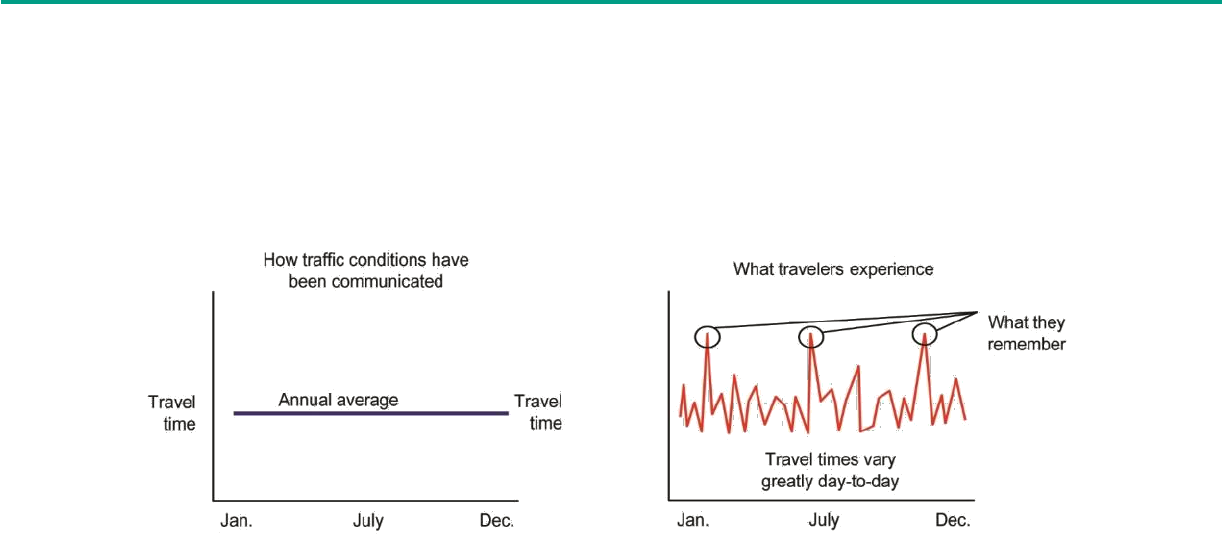
HIGHWAY SAFETY BENEFIT COST ANALYSIS GUIDE CHAPTER 4
35
captures the change in recurring travel time. As shown in Figure 5, the use of average travel
time may not realistically represent actual travelers’ experiences.
Average travel time may not realistically represent
actual travelers’ experiences.
Figure 5. Chart. Recurring travel time measurement versus actual traveler
experience.
(26)
Significant research and analyses have been performed on the effects of nonrecurring travel
time delay caused by factors such as crashes, special events, weather, and construction work
zones. Research completed as part of the Transportation Research Board’s (TRB) Second
Strategic Highway Research Program (SHRP2) and other Federal and State efforts have shown
the amount of delay caused by nonrecurring congestion is substantial. Omitting this measure
from transportation BCA may severely understate potential project benefits. This section
describes several methods for evaluating travel time reliability.
Travel time reliability measurement seeks to quantify the variability in travel times caused by
nonrecurring and recurring congestion sources to better estimate the full distribution of travel
times experienced by the system users. Transportation researchers have developed several
performance measures and indices to help quantify reliability impacts.
Table 13 briefly defines each reliability measure and Figure 6 provides an example graphic to
illustrate these measures empirically. Many of these measures are based on an analysis of the
distribution of travel times for a segment or facility. For some measures, there are multiple
definitions based on SHRP2 reliability research.
(27)
For example, the Planning Time Index and
Buffer Index are best estimated using the median travel time; however, median travel time may
not be readily available. In such cases, the analyst may need to substitute average travel time for
median travel time. The Failure/On-Time metrics may be based on either travel time or speed
brackets. Either may be appropriate, depending on the data available.

HIGHWAY SAFETY BENEFIT COST ANALYSIS GUIDE CHAPTER 4
36
This Guide uses buffer time to estimate the impact of crash reductions (or increases) on
reliability. Buffer time is the amount of extra time that most travelers add to their average
travel time to ensure a certain level of on-time arrival. Figure 6 shows buffer time as the
difference between the mean travel time (TT
m
) and the travel time at 95 percent on-time arrival
assurance (TT
95
). Whether expressed as a percentage or in minutes, it represents the extra
time a traveler should allow to arrive on-time for 95 percent of all trips. A simple analogy is
that a traveler who uses a 95 percent reliability indicator would be late only one weekday per
month. The standard deviation of travel time approximates the mean buffer time travelers
would need to meet their individual on-time requirements given their experience with the
network performance. As such, the change in the standard deviation of travel time
approximates the change in the mean buffer time.
Table 13. Reliability performance measures.
(27)
Performance Metric
Definition
Units
Planning-Time Index
• 95
th
percentile Travel Time Index (95
th
percentile
travel-time divided by the free-flow travel time),
normalized by the average travel time.
• The difference between the 95
th
percentile travel
time and the median travel time, normalized by
the median travel time.
None
Buffer Index (BI)
• The difference between the 95
th
percentile travel
time and the average travel time, normalized by
the average travel time, often shown for 80%,
85%, or 90% as well.
• The difference between the 95
th
percentile travel
time and the median travel time, normalized by
the median travel time, often shown for 80%,
85%, or 90% as well.
Percent
Failure/On-Time
Measures
• Percent of trips with travel times less than 1.1 *
Median Travel Time or 1.25 * Median Travel
Time.
• Percent of trips with space mean speed less than
50 mph, 45 mph, or 30 mph.
Percent
80
th
Percentile Travel-
Time Index
• 80
th
percentile travel time divided by the free-
flow travel time.
None
Skew Statistic
• The ratio of (90
th
percentile travel time minus
the median) divided by (the median minus the
10
th
percentile).
None
Misery Index (Modified)
• The average of the highest five percent of travel
times divided by the free-flow travel time.
None
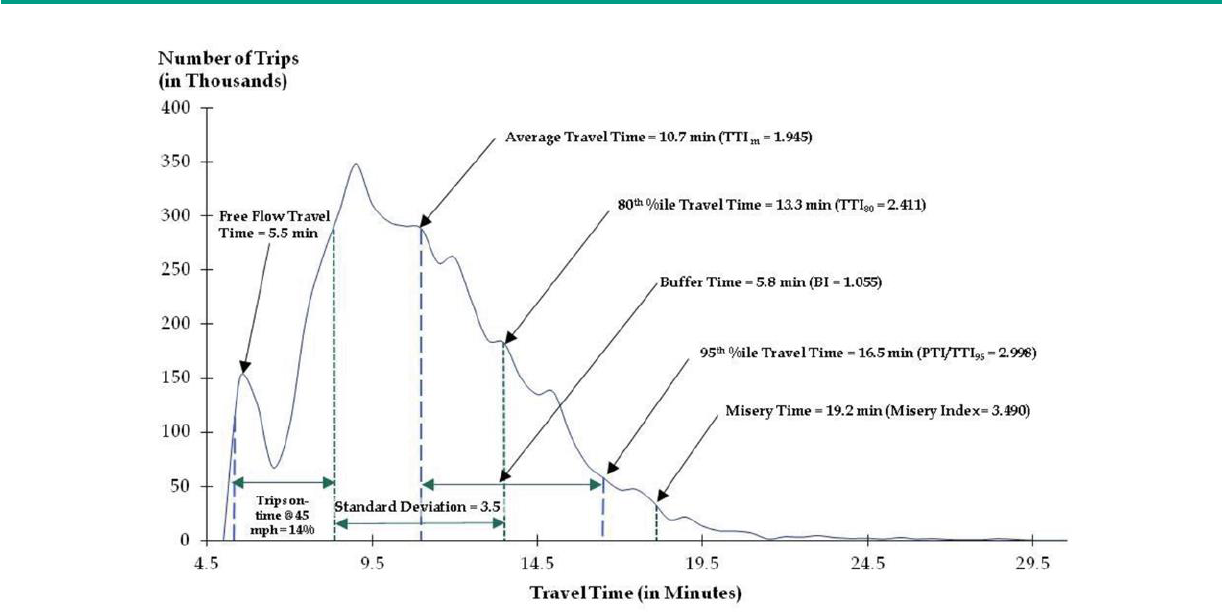
HIGHWAY SAFETY BENEFIT COST ANALYSIS GUIDE CHAPTER 4
37
Figure 6. Chart. Relationship of travel time measures and reliability.
(28)
This Guide and Tool use buffer time to estimate the
impact of crash reductions (or increases) on reliability.
4.3.1 Value of Travel Time Reliability
Projects that improve safety also improve reliability by reducing the number and severity of
crashes. To the extent that crash reductions improve network performance, travelers can
reduce the buffer time, realizing benefits related to time savings. To monetize estimates of
travel time reliability, a value of time measure is applied to the travel time reliability savings
measure. The analyst can monetize the time savings using the preferred value of time (either
local value of time or national values such as those in Table 10).
This type of analysis applies to the evaluation of travel time reliability for existing transportation
facilities. This method is not as useful as a predictive tool. Further, sufficient data are required
to support the estimation of the travel time distributions. In addition, transportation projects
may have a direct benefit on travel time reliability, beyond the indirect benefit of crash
reductions. As such, the analyst should seek to estimate and include these additional direct
benefits in the BCA as needed.

HIGHWAY SAFETY BENEFIT COST ANALYSIS GUIDE CHAPTER 4
38
Transportation projects may have a direct benefit on travel
time reliability, beyond the indirect benefit of crash
reductions or increases.
4.3.2 Data Sources for Travel Time Reliability
Travel time distributions are obtained from modern real-time vehicle to infrastructure (V2I)
travel data collection, long-term data archive systems, multiple manual data collection and
monitoring activities, or modeling efforts using multiple scenarios representing expected traffic
conditions. The analyst then multiplies the net change in the standard deviation in minutes of
travel time by the number of facility users. This calculation provides a temporal measure of
travel time reliability savings which can be monetized in a BCA.
The analyst should ensure that the dataset used to estimate the distribution of travel times is
sufficiently robust to capture travel times during a representative sampling of conditions. This
may require six months, for relatively simple cases, to multiple years’ worth of continuous data,
where an elevated level of confidence in analysis results is required. For a BCA, the analyst
should consider the overall project budget and level of effort desired before undertaking a
travel time reliability study that involves months or years of effort.
4.4 VEHICLE OPERATING COSTS
Change in net vehicle operating cost is a common measure used for transportation projects. A
BCA typically breaks out vehicle operating cost into fuel use and nonfuel use categories;
although, they may be combined as a single measure. Nonfuel use costs typically include vehicle
maintenance, insurance, and depreciation, but do not include vehicle registration and taxes
because economists consider these transfers. Benefits attributable to lower vehicle operating
cost are usually not a major component of a project's overall benefit.
Estimation of vehicle operating cost is often based on simple valuations applied directly to
vehicle miles traveled (VMT). Any net change in total VMT or roadway speed attributable to a
project alternative will affect fuel use. For simple analysis, the BCA applies a static rate of
average fuel use (gallons per VMT) to any net change in VMT to estimate the net change in fuel
use. The BCA then applies a benefit value (cost per gallon of fuel exclusive of fuel taxes) to the
change in the number of gallons of fuel consumed. The federal government anticipates future
year vehicle fleets to have greatly improved fuel use rates. Since estimated fuel use rates can
differ substantially based upon the year of analysis, practitioners are encouraged to use fuel
rates appropriate to that year.
(29)

HIGHWAY SAFETY BENEFIT COST ANALYSIS GUIDE CHAPTER 4
39
For nonfuel operating costs (e.g., maintenance, tires, tolls, lease, and financing), the BCA can
estimate the benefit values through VMT and change in VMT. Like fuel use rates, this benefit
value may be sensitive to the forecast year of analysis; however, nonfuel vehicle operating costs
are usually not sensitive to differences in operating conditions (e.g., travel speeds).
For highway safety BCA, it is necessary to relate the change in safety performance to a change
in fuel use as the project may or may not impact VMT. The NHTSA report, The Economic and
Societal Impact of Motor Vehicle Crashes, provides values of increased fuel use per crash by crash
severity and roadway facility type.
(11)
Chapter 6 provides further details on applying this method.
This Guide focuses on reductions in fuel use
that result from crash reductions.
4.4.1 Value of Vehicle Operating Costs
To monetize fuel-related benefits, apply the cost per gallon of fuel, exclusive of fuel taxes, to
the change in fuel use. Analysts can obtain estimates of fuel costs from websites such as the US
Energy Information Administration.
(30)
To monetize nonfuel vehicle-use benefits, apply the average vehicle operating cost per mile to
the change in VMT. This Guide does not include nonfuel vehicle-use benefits in the highway
safety BCA because most safety projects do not impact the VMT. Specifically, there is limited or
no induced demand so the expected change in VMT would be the same for the base and
alternative conditions.
The vehicle operating cost per mile varies by type and age of vehicle. Even within light duty
vehicles, there are substantial variations in vehicle operating cost per mile due to differences in
vehicle weight, design, fuel type, and other factors. The Benefit-Cost Analysis Guidance for
TIGER and INFRA Applications recommends a 2016 value of $0.40 per mile for light duty
vehicles and $0.96 per mile for heavy duty vehicles. The light duty vehicle operating cost is
based on an average sedan and costs such as gasoline, maintenance, tires, and depreciation,
assuming an average of 15,000 miles driven per year. The value omits other ownership costs
that are mostly fixed or transfers (insurance, license, registration, taxes, and financing charges).
The heavy-duty vehicle operating cost includes fuel costs, truck/trailer lease or purchase
payments, repair and maintenance, truck insurance premiums, permits and licenses, and tires.
The value omits tolls (transfers) and driver wages and benefits, which are included in the value
of travel time savings.

HIGHWAY SAFETY BENEFIT COST ANALYSIS GUIDE CHAPTER 4
40
4.4.2 Data Sources for Vehicle Operating Costs
The Benefit-Cost Analysis Guidance for TIGER and INFRA Applications is updated periodically
providing the latest USDOT-approved values for vehicle operating cost. The 2017 version
provides 2016 values based on data from the following sources:
• American Automobile Association, Your Driving Costs – 2016 Edition (2016),
http://exchange.aaa.com/automotive/driving-costs/#.WVZdF02oupp.
(31)
• American Transportation Research Institute, An Analysis of the Operational Costs of
Trucking: 2016 Update (2016), http://atri-online.org/wp-content/uploads/2016/10/ATRI-
Operational-Costs-of-Trucking-2016-09-2016.pdf.
(32)
These values are updated annually, which is typically more frequent than the USDOT BCA
guidance. The analyst can use the source information or use the CPI to update the DOT values
between publication years.
(33)
For example, to update 2016 values to 2017, multiply by 1.6154
(i.e., 2.1 percent average annual CPI in 2017 divided by 1.3 percent average annual CPI in 2016).
4.5 EXTERNALITIES
One of the more challenging areas of BCA is the treatment and valuation of externalities (non-
user costs) related to transportation projects. Economists define an externality as the
uncompensated impact of one person's actions on the well-being of a bystander. In the case of
transportation investments, "bystanders" are the non-users of the project.
Externalities include uncompensated impacts on bystanders.
Examples of externalities include the following:
• Changes in air emissions (e.g., criteria pollutants regulated by the Clean Air Act).
• Noise impact (i.e., increases or decreases in noise levels).
• Construction impacts (e.g., degradation in roadway level of service on surrounding
neighborhoods).
• Impacts to natural habitats, wetlands, and streams.
• Permanent property value impacts.
When the impact benefits the non-user, economists refer to it as a positive externality. When
the impact is adverse, economists refer to it as a negative externality. Often, the BCA focuses
on negative externalities. Negative externalities include the undesirable effects of a project on
air and water quality, noise and construction disruptions, and other community or aesthetic

HIGHWAY SAFETY BENEFIT COST ANALYSIS GUIDE CHAPTER 4
41
impacts as described. Positive externalities, however, also exist. For example, a project may
serve to reduce air or noise pollution from previously existing or projected levels.
Transportation agencies generally analyze a project’s environmental impact (including
externalities) through environmental studies required by the NEPA as well as other State and
local environmental compliance laws. This is particularly the case for larger projects where the
agency must prepare an Environmental Impact Statement (EIS) or Environmental Assessment
(EA). The EIS or EA generally quantifies the project’s impact to air quality, noise levels, and the
natural environment such as loss of wetlands or habitat for threatened and endangered species.
Analysts can use NEPA studies to quantify the impact of externalities for use in a BCA.
Transportation agencies should closely coordinate NEPA studies and BCA to the extent
possible. Where possible, the analyst should utilize the analysis completed through the NEPA
process to evaluate the cost to mitigate natural environmental impacts (e.g., wetland or habitat
loss). Analysts may also use environmental impacts described in the NEPA study to qualitatively
evaluate and compare alternatives. The BCA can utilize broader impact estimates to more
accurately estimate project costs and benefits (e.g., estimates of air quality impacts from a larger
program of safety improvements implemented on a statewide level).
Analysts can use the results of NEPA studies to
quantify the impact of externalities for use in a BCA.
Emissions are a common externality monetized for transportation projects. The inclusion of
emissions estimates in BCA is particularly important when transportation agencies prioritize
projects in competition for several types of funding (e.g., Safety, Operations, or Congestion
Mitigation, and Air Quality (CMAQ) funds), or the project is considered in an air quality
nonattainment area.
The Clean Air Act requires the Environmental Protection Agency (EPA) to set National
Ambient Air Quality Standards (40 CFR part 50) for pollutants considered harmful to public
health and the environment. The Clean Air Act identifies two types of national ambient air
quality standards: primary and secondary. Primary standards provide public health protection,
including protecting the health of "sensitive" populations such as asthmatics, children, and the
elderly. Secondary standards provide public welfare protection, including protection against
decreased visibility and damage to animals, crops, vegetation, and buildings.
The EPA has set National Ambient Air Quality Standards for six principal pollutants, which are
called "criteria" air pollutants. Periodically, the standards are reviewed and revised. The current
standards are listed below. A BCA often includes one or more of these pollutants depending on
the concerns of the local region. Units of measure for the standards are parts per million (ppm)
by volume, parts per billion (ppb) by volume, and micrograms per cubic meter of air (µg/m
3
).

HIGHWAY SAFETY BENEFIT COST ANALYSIS GUIDE CHAPTER 4
42
• Hydrocarbons (HC)/Reactive Organic Gases (ROG).
• Nitrous Oxide (NOx).
• Carbon Monoxide (CO).
• Carbon Dioxide (CO2).
• Particulate Matter (PM10) or Fine Particulate Matter (PM2.5).
• Sulfur Dioxide (SO2).
4.5.1 Value of Emissions
The NHTSA report, The Economic and Societal Impact of Motor Vehicle Crashes, provides
monetized values for select emissions per crash by crash severity and roadway facility type.
(11)
These emissions include volatile organic compounds (VOCs), but do not include PM10 or CO.
PM10 is not included because virtually all the adverse health impacts from PM arise from fine
particulates, defined as the fraction that is less than 2.5 microns in diameter (hence the notation
PM2.5). CO is not included because at current exposure levels, there is no evidence that CO
causes any adverse health impacts. Table 14 through Table 16 present the NHTSA-developed
emissions values for five facility types, converted to 2017 dollars using the CPI.
This Guide focuses on emissions reductions that result from
crash reductions. Analysts should seek other data and tools
to estimate direct emissions benefits.
Table 14. Estimated value of net emissions per fatal crash (2017 dollars).
(11)
Facility Type
CO
2
NO
X
PM
2.5
SO
2
VOC
Total
Emissions
Urban Interstate /
Expressway
$827.90
$197.59
$895.53
$70.79
$23.61
$2,015.41
Urban Arterial
$213.66
$50.27
$133.83
$18.09
$3.99
$419.84
Urban Other
$16.37
$3.95
$8.92
$1.41
$0.27
$30.92
Rural Interstate / Principal
Arterials
$124.60
$59.72
$178.65
$10.38
$2.44
$375.79
Rural Other
$15.47
$6.28
$17.54
$1.28
$0.28
$40.84
Average for All Road Types
$159.48
$44.36
$159.17
$13.53
$3.82
$380.36

HIGHWAY SAFETY BENEFIT COST ANALYSIS GUIDE CHAPTER 4
43
Table 15. Estimated value of net emissions per injury crash (2017 dollars).
(11)
Facility Type
CO
2
NO
X
PM
2.5
SO
2
VOC
Total
Emissions
Urban Interstate /
Expressway
$174.91
$41.74
$189.15
$14.98
$4.99
$425.77
Urban Arterial
$47.38
$11.14
$29.16
$4.02
$0.88
$92.57
Urban Other
$7.18
$1.72
$3.76
$0.62
$0.12
$13.41
Rural Interstate / Principal
Arterials
$22.98
$11.02
$33.05
$1.94
$0.45
$69.43
Rural Other
$3.93
$1.59
$4.38
$0.32
$0.07
$10.29
Average for All Road Types
$34.29
$9.40
$33.45
$2.92
$0.81
$80.87
Table 16. Estimated value of net emissions per PDO crash (2017 dollars).
(11)
Facility Type
CO
2
NO
X
PM
2.5
SO
2
VOC
Total
Emissions
Urban Interstate /
Expressway
$148.76
$35.51
$160.61
$12.67
$4.24
$361.79
Urban Arterial
$28.71
$6.75
$18.34
$2.41
$0.53
$56.75
Urban Other
$4.33
$1.05
$2.25
$0.36
$0.08
$8.06
Rural Interstate / Principal
Arterials
$23.38
$11.21
$33.38
$1.91
$0.46
$70.34
Rural Other
$3.28
$1.34
$3.59
$0.28
$0.06
$8.55
Average for All Road Types
$27.16
$7.70
$27.85
$2.29
$0.66
$65.67
When an agency cannot quantify the dollar value of an externality, they may choose to deal
with it on an as-needed qualitative basis. If the measurable net benefits of a project are highly
positive, decision makers may tolerate minor unquantified externalities from an economic
standpoint, even if the agency perceives the externalities to be negative. On the other hand, if
the net benefits are very low, then the existence of significant unquantified negative
externalities may tip the economic balance against the project. An example of this could include
negative impacts to low-income and minority populations that live near the project location.
The project could impact these populations through increases in air pollution, noise, or traffic.

HIGHWAY SAFETY BENEFIT COST ANALYSIS GUIDE CHAPTER 4
44
Analysts may deal with externalities on a qualitative
basis if they cannot quantify the dollar value.
It may not be easy to monetize quality of life measures or other potentially controversial
measures. The BCA can include such items through qualitative presentations. These types of
externalities become important if the monetized present value of benefits do not exceed or
only barely exceed the monetized present value of costs.
4.5.2 Data Sources for Emissions
Emissions may represent one of the most complex measures to estimate in BCA. This is due to
the many variables that determine the appropriate emission rates. Most emissions estimations
are based on an application of an emissions rate on a per VMT basis. Depending on the
emissions category, the appropriate emissions rate to apply may be sensitive to numerous
factors, including the following:
• Year of the analysis (i.e., the EPA anticipates future year vehicle fleets to produce fewer
emissions in many categories).
• The mix of gasoline and diesel vehicles in the regional fleet.
• Vehicle speeds.
• The number of cold starts.
• The mix of vehicles in the regional vehicle mix (e.g., autos, light trucks, medium-duty
trucks, heavy-duty trucks, etc.).
• Regional weather patterns/climate and other considerations.
Given these many variables impacting emissions rates, analysts should obtain rates using existing
emissions analysis tools, calibrated to the individual region or derived from previously
conducted regional analysis. Therefore, analysts should use caution when applying emissions
rates derived from other regions or based on averages among different regions. This Guide
does not provide detailed estimates of emissions rates by region, but does provide a method
for quantifying and monetizing emissions based on the expected change in crashes (refer to
Chapter 6).
4.6 CHAPTER SUMMARY
Chapter 4 describes various types of project benefits included in a highway safety BCA. The
safety benefits result in direct and indirect impacts. Direct safety benefits are the expected
reduction in crash frequency and severity. Indirect benefits include reductions in travel time,

HIGHWAY SAFETY BENEFIT COST ANALYSIS GUIDE CHAPTER 4
45
vehicle operating costs, and emissions resulting from fewer crashes. Each section provides
default values to monetize project benefits.
Key Takeaways from Chapter 4:
• Safety benefits are derived from a change in safety performance (i.e., change in the
frequency and/or severity of crashes), which may result in direct and indirect benefits.
• Direct safety benefits include the reduction in crash frequency and/or severity.
• To monetize direct safety benefits for a BCA, multiply the estimated change in long-
term average crashes by the average comprehensive crash cost.
• Comprehensive crash costs (or societal crash costs) are generally most appropriate for
monetizing the value of crashes as they capture all impacts resulting from crashes.
• Indirect safety benefits include reductions in travel time, vehicle operating costs, and
emissions resulting from fewer crashes.
• This Guide does not consider direct operational and environmental impacts such as
reductions in recurring delay.
• The NHTSA report, The Economic and Societal Impact of Motor Vehicle Crashes, provides a
method to estimate and monetize the indirect safety benefits.
(11)

HIGHWAY SAFETY BENEFIT COST ANALYSIS GUIDE CHAPTER 4
46
THIS PAGE IS INTENTIONALLY LEFT BLANK

HIGHWAY SAFETY BENEFIT COST ANALYSIS GUIDE CHAPTER 5
47
5. PREPARING FOR A BCA
The BCA process begins with the development of a base condition. This serves as a basis for
comparing other project alternatives. In preparing for a BCA, it is also important to establish
the analysis period, consider the need to evaluate uncertainty, and select a discount rate. This
chapter describes these components of preparing for a BCA. The chapter also describes
potential challenges and opportunities to overcome these challenges in BCA.
Chapter 5 At-A-Glance
Chapter 5 is divided into six sections:
• Section 5.1 describes the purpose and importance of establishing the base condition.
• Section 5.2 discusses the purpose of setting an analysis period for the BCA.
• Section 5.3 defines uncertainty and describes the purpose of evaluating uncertainty in
BCA.
• Section 5.4 introduces the concept of discounting and appropriate discount rates.
• Section 5.5 identifies challenges and opportunities to overcome challenges in BCA.
• Section 5.6 provides a summary of the chapter.
5.1 DEVELOPING THE PROJECT BASE CONDITION
Critical to a successful BCA is development of the project base condition. The base condition is
the project alternative against which the analyst evaluates other project alternatives (i.e., does
the project alternative provide net benefits compared with the base condition). This is often the
existing condition (or “no-build” or “do nothing” alternative), representing the continued
operation of the existing transportation facility under good management practices with minor
or no capital investments.
Accurately defining the base condition is critical to
the success of a BCA.
The definition of the base condition can have significant impacts on the BCA; therefore, it is
important to carefully define values such as existing and future traffic volumes. Further, the
estimated safety performance of the base condition is the basis for highway safety BCA and
related decision-making. As such, it is imperative that analysts use a reliable method to estimate
the safety performance of the base condition. The following are several factors to consider in
selecting an appropriate method to estimate the safety performance of the base condition:
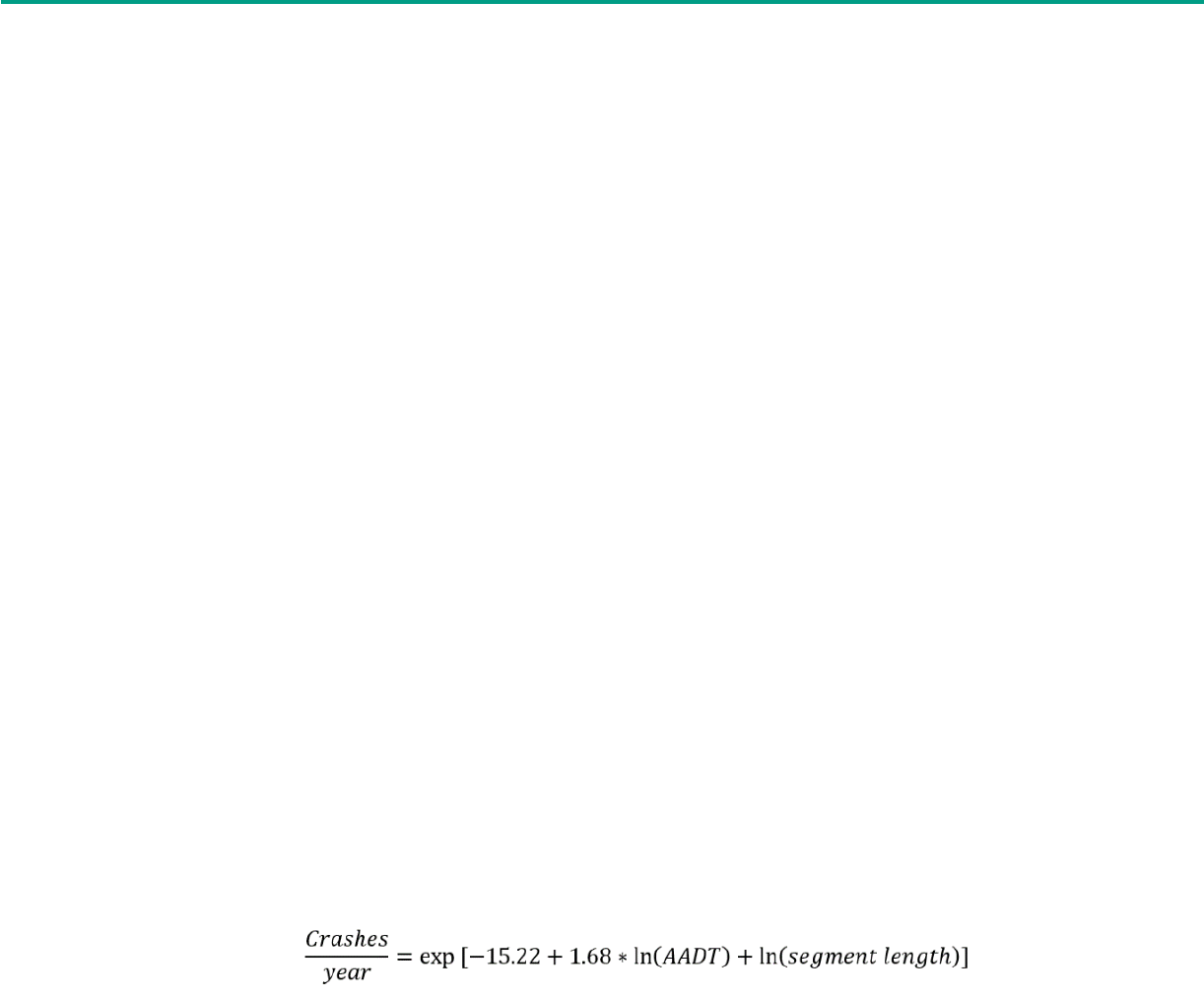
HIGHWAY SAFETY BENEFIT COST ANALYSIS GUIDE CHAPTER 5
48
• Data availability (years of crash, roadway, and traffic data).
• Annual fluctuation in observed crashes.
• Changes in geometric or traffic control characteristics.
• SPF availability and reliability.
• Potential for changes in traffic volume.
In addition to the factors listed above, analysts should consider the trade-off between the
reliability of the method and the resources needed to conduct the analysis.
The Highway Safety Manual provides three methods to estimate the safety performance of a
base condition: observed, predicted, and expected crashes.
(7)
Observed crashes are the historical crashes reported for an existing site. For
example, if there were 15 reported crashes at an existing intersection over the last five
years, then the observed number of crashes is 15 (or 3.0 crashes per year on average).
Using the observed crash frequency assumes the observed crashes before the project
represent the long-term future safety performance in the absence of projects or other
changes to the site. This assumption does not account for year-to-year changes in
conditions at the location of interest (e.g., changes in traffic, weather, crash reporting,
road conditions, land use, vehicle fleet, and driver behavior).
Predicted crashes are based on SPFs, which are mathematical models used to predict
mean crash frequency based on exposure for a given facility type. For example, if the
SPF for a given facility type is represented by Figure 7, and the location of interest is 2.5
miles with 7,500 vehicles per day, then the predicted number of crashes is 1.99 per year
[exp(-15.22 + 1.68*ln(7500) + ln(2.5)]. If the traffic volume is expected to change during
the analysis period, consider using the average value to represent the traffic volume.
Figure 7. Equation. Example SPF.
Using the predicted crash frequency assumes the SPF prediction is representative of
future safety performance. This method accounts for changes in traffic volume and can
incorporate adjustment and calibration factors to account for changes in geometrics and
general time trends; however, it requires jurisdiction-specific SPFs or SPFs calibrated to
local conditions. Further, the SPF should be developed using data for similar sites at
which the countermeasure of interest has not been implemented. This method does not

HIGHWAY SAFETY BENEFIT COST ANALYSIS GUIDE CHAPTER 5
49
consider historical crash data for any specific location of interest in estimating future
safety performance.
Expected crashes are based on the weighted average of observed and predicted
crashes using the Empirical Bayes method. The weight placed on the predicted crashes is
based on the statistical reliability of the SPF as well as the magnitude of the predicted
crash frequency. Using the expected crash frequency assumes the combined observed
and predicted crash frequency is representative of future safety performance. This
method accounts for changes in traffic volume, regression-to-the-mean, and can
incorporate adjustment and calibration factors to account for changes in geometrics and
general time trends. This method requires jurisdiction-specific SPFs or SPFs calibrated to
local conditions. Further, the SPF should be developed using data for similar sites at
which the countermeasure of interest has not been implemented. If the traffic volume is
expected to change during the analysis period, consider using the average value to
represent the traffic volume when using SPFs to estimate predicted crashes.
Table 17 provides an overview of the characteristics associated with the three methods for
estimating the safety performance of the base condition. This table can help determine when
each method is (or is not) appropriate for estimating the safety performance of the base
condition. The following are additional insights to help select an appropriate method:
• Research has shown the observed crashes may overestimate the crashes for the base
condition, particularly when there is a high degree of annual fluctuation in the observed
crashes.
(4)
• If a calibrated SPF is available, the predicted or expected crashes can help to normalize
annual fluctuations in observed crashes and account for changes in traffic volume.
• The observed crashes may provide a reasonable estimate when there are several years
of historical crash data and limited fluctuation in crashes from year to year.
• Expected crashes are typically more reliable than predicted crashes, assuming the
observed crashes for the base condition are applicable to future conditions.
• Predicted crashes are most appropriate when the observed crashes are not a good
approximation of future conditions.
• Observed crashes are not a good approximation of future conditions when there are
major changes to the land use, traffic operations, or facility type. For example, if a
project includes road widening from two to four lanes, then the observed crash
frequency under existing conditions (i.e., two-lane facility) would not represent the
future safety performance under future conditions (i.e., four-lane facility).
Refer to the Highway Safety Manual for further discussion of methods to estimate the safety
performance of base conditions.
(7)

HIGHWAY SAFETY BENEFIT COST ANALYSIS GUIDE CHAPTER 5
50
Table 17. Overview of methods to estimate safety performance of base condition.
Characteristics
Observed
Crashes
Predicted
Crashes
Expected
Crashes
Method limited by large degree of annual
crash fluctuation
●
--
--
Reasonable when there are several years of
historical crash data with limited fluctuation
●
--
●
Appropriate to normalize annual crash
fluctuations
--
●
●
Applicable when facility type changes due
to countermeasure
--
●
--
Requires calibrated SPF
--
●
●
Accounts for traffic volume changes
--
●
●
Note: -- indicates not applicable.
5.2 SETTING AN ANALYSIS PERIOD
BCA attempts to capture the comprehensive costs and benefits that result from a project over
the lifecycle and within a defined analysis period (e.g., 10- or 20-year time horizon). In setting an
analysis period, it is necessary to define an appropriate timeframe to allow for a meaningful
analysis and a fair comparison of alternatives. FHWA recommends that the analysis period
include the initial construction and at least one subsequent rehabilitation action for each
alternative.
(8)
Using BCA, the analyst calculates the lifecycle costs and benefits of each alternative over the
same analysis period. When the service life is different among project alternatives, the analyst
should standardize the service life comparisons. One method to standardize the service life
comparisons is to use the least common multiple of the service lives. For example, if alternative
1 has a service life of four years and alternative 2 has a service life of eight years, then the least
common multiple is an analysis period of eight years. In this case, the analyst would estimate the
initial cost to implement each alternative and assume one replacement of alternative 1 at the
end of the fourth year.
The analyst should standardize the analysis period to
ensure a fair comparison of alternatives.
Within the analysis period, alternatives may have different maintenance or rehabilitation
requirements at various times. For example, the cost components for a given project may
include safety-related hardware, software, and operations and maintenance costs. For

HIGHWAY SAFETY BENEFIT COST ANALYSIS GUIDE CHAPTER 5
51
alternative 1, the hardware has an estimated 10-year service life and the software requires
updating every five years. For alternative 2, the hardware has an estimated 15-year service life
and the software requires updates every five years. An appropriate analysis period should
account for the difference in service life for the hardware. Using the least common multiple of
the service lives, a potential analysis period is 30 years. For alternative 1, this would include the
initial cost and two replacements (i.e., replacement in years 10 and 20). For the second
alternative, this would include the initial cost and one replacement (i.e., replacement in year
15). Both alternatives would include the initial software cost and five replacements (i.e.,
replacements in years 5, 10, 15, 20, and 25). In this example, the 30-year analysis period
provides a fair comparison between alternatives with different hardware lifespans.
As another example, consider the cost of installing a traffic signal or constructing a roundabout
at an existing two-way stop-controlled intersection. If the expected service life of the traffic
signal is 10 years and the expected service life of the roundabout is 25 years, then a common
multiple is a 50-year analysis period.
5.3 EVALUATING UNCERTAINTY
Transportation agencies evaluate and manage uncertainty associated with transportation
investments by attempting to measure uncertainty. Analysts can measure many uncertainties by
quantifying the probability of occurrence and impact of an event. Analysts identify and evaluate
uncertainty by answering three questions:
• What can happen? Uncertainties affect the BCA results. These uncertainties include
changes in initial construction estimates or future rehabilitation cost overruns,
inaccurate facility service life costs, or variations in traffic volumes that differ significantly
from forecasts.
• How likely is it to happen? Some uncertainties are more likely to occur than others.
For instance, it may be that the transportation agency has an excellent understanding of
project costs and unlikely to have construction cost overruns.
• What are the consequences of it happening? In some cases, an input variable may
be subject to significant variability, but any given occurrence (within a realistic range)
would not substantially affect the economic justification for the project. For instance,
the price of a paving material may be subject to large swings, but the benefits of an
alternative using that material may be sufficiently large to maintain the alternative as the
preferred alternative even if the paving material price doubles. In other cases, there may
be little likelihood that an event will occur (such as an earthquake), but its occurrence
would have major consequences unless the transportation agency takes certain
precautions in the project’s design.

HIGHWAY SAFETY BENEFIT COST ANALYSIS GUIDE CHAPTER 5
52
Assessing uncertainty helps analysts to answer these questions and determine if efforts to
mitigate uncertainty is cost-effective. The traditional means by which analysts have evaluated
uncertainty is through sensitivity and probabilistic analyses. The following sections describe
methods to evaluate uncertainty.
5.3.1 Sensitivity Analysis
The traditional means by which analysts have evaluated uncertainty is through sensitivity
analysis. A sensitivity analysis provides a method to alleviate concerns related to the quality or
credibility of data or specific inputs. In a typical sensitivity analysis, the value of an input variable
identified as a significant potential source of uncertainty is changed (either within some
percentage of the initial value or over a range of reasonable values) while all other input values
are held constant, and the amount of change in analysis results is noted. This sensitivity process
is repeated for other input variables for which uncertainty has been identified. The input
variables may then be ranked per the effect of their variability on BCA results.
In highway safety analysis, analysts can consider the certainty (or uncertainty) of the estimated
change in crashes by computing a confidence interval. The analyst would have more certainty in
the estimated change in crashes, and resulting benefits, as the width of the confidence interval
decreases. For example, if the CMF is 0.75 with a 95 percent confidence interval of 0.41 to
1.09, then there is a 95 percent chance that the true CMF value is between 0.41 and 1.09. If the
confidence interval includes 1.0, as in this example, then the countermeasure may result in a
reduction, no change, or an increase in crashes. To incorporate this measure of uncertainty in
highway safety BCA, the analyst could use the end points of the confidence interval (e.g., 0.41
and 1.09) in addition to the point estimate of the CMF when estimating the change in crashes
and resulting benefits. Refer to FHWA’s guide, Quantifying Safety in the Roadway Safety
Management Process, for further discussion on estimating the confidence interval.
(34)
5.3.2 Probabilistic Analysis
Continued advances in computing power permit the practice of probabilistic-based uncertainty
analysis, most often through a method known as Monte Carlo simulation. In Monte Carlo
simulation, the analyst assigns an appropriate probability distribution (based on expert opinion,
historical data, and other information) to each of the input variables subject to uncertainty in
the economic analysis. The Monte Carlo simulation draws random samples from the probability
distributions for each input, runs the selected input values through the BCA formula to
calculate a discrete economic result, and then repeats this process numerous times. The
results, based on the randomly selected input values, produce an average BCA measure and an
associated probability distribution to indicate the range of potential outcomes of the BCA.
Refer to the Economic Analysis Primer for further details on probabilistic analysis and other
fundamental economic analysis concepts.
(8)
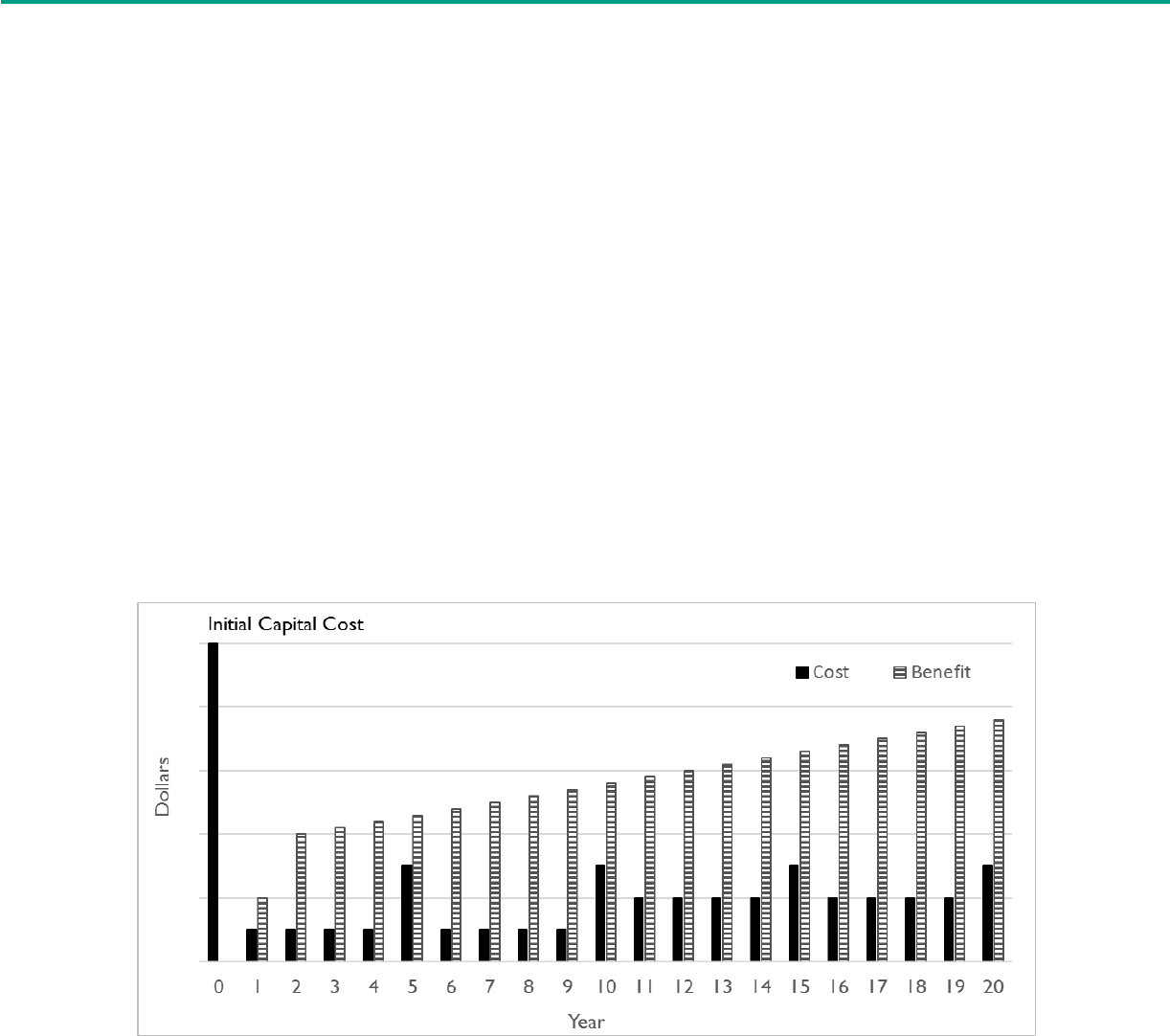
HIGHWAY SAFETY BENEFIT COST ANALYSIS GUIDE CHAPTER 5
53
5.4 DISCOUNTING
The most basic economic questions that people face in their personal and business lives involve
the tradeoffs between dollars earned, spent, or invested today and those dollars they hope to
earn, spend, or invest in the future. Project lifecycle evaluation is important for transportation
projects as these activities can be long-lived and require initial and periodic capital investments,
as well as ongoing materials and maintenance expenditures.
Figure 8 shows an example distribution of project costs and benefits over time. These typically
include initial construction costs (year 0), annual maintenance costs (years 1 to 4, 6 to 9, 11 to
14, and 16 to 19), and periodic rehabilitation and reconstruction costs (years 5, 10, 15, and 20).
The periodic rehabilitation and reconstruction costs are necessary if the analysis period is
longer than the expected service life of the project. Benefits may grow rapidly in the first few
years after implementation and level out in later years as the public becomes accustomed to the
project. The assumption of increasing benefits, as shown in the figure, does not necessarily
apply to all projects, but depends on which strategy the agency implements. Some strategies,
such as pavement markings or enhanced surface friction, may have the greatest benefits in the
first few years after implementation, then lose effectiveness due to degradation over time.
Figure 8. Chart. Time series of costs and benefits (in constant dollars).
(8)
A dollar that an agency spends or earns in the future is almost always worth less to them today
than a dollar they spend or earn now. The BCA quantifies the changing value of the dollar to
enable meaningful comparisons of multiyear dollar streams. Two separate and distinct factors
account for why the value of a dollar, as seen from the present, diminishes over time. These
factors are inflation and the time value of resources, also referred to as “discounting.”

HIGHWAY SAFETY BENEFIT COST ANALYSIS GUIDE CHAPTER 5
54
Two separate and distinct factors account for why the present
value of a dollar diminishes over time: inflation and discounting.
5.4.1 Inflation
In the case of economic analysis of investments by a public agency, the suggested practice is to
forecast lifecycle costs and benefits of a project without inflation (i.e., in real or base year
dollars). Inflation is hard to predict, particularly in the long-term for a project meant to be in
service for decades. More importantly, if the BCA adds inflation to the calculation of benefits
and costs projected for future years, it will only have to be removed again before these benefits
and costs can be compared in the form of dollars in any given base year.
Inflation is generally not considered in BCA.
5.4.2 Discounting
The application of the discount rate to future sums to calculate their present value is known as
"discounting.” Through discounting, the BCA can objectively compare different investment
alternatives based on their respective present values, even though each has a different stream of
future benefits and costs.
Figure 9 and Figure 10 provide the formulas for discounting. For example, if the discount rate is
3.0 percent, the discount factor (from Figure 10) for 10 years in the future is 0.744
(1/(1.03^10)). If the estimated benefit is $1000 for 10 years in the future, then the present value
(from Figure 9) is $744 (0.744 * $1000).
Figure 9. Equation. Standard formula for discounting.
where:
PV = present value at time zero (the base year).
r = discount rate.
t = time (year).
A
t
= amount of benefit or cost in year t.
Figure 10. Equation. Discount factor.

HIGHWAY SAFETY BENEFIT COST ANALYSIS GUIDE CHAPTER 5
55
Most transportation projects generate costs and benefits over their entire lifecycle. The BCA
should discount the entire series of costs and benefits to the present by multiple applications of
the PV formula for each applicable year of the lifecycle. Figure 11 provides the formula for this
calculation. These discounted values are then summed together (as represented by ∑) for each
year of the lifecycle analysis period (N years) to yield an overall present value.
Figure 11. Equation. Summation of discounted values.
5.4.3 Selecting a Discount Rate
Economic analysis should include real terms (i.e., using dollars and discount rates that do not
include the effects of inflation). The BCA can estimate the real discount rate by removing the
rate of inflation as measured by a general price index such as the CPI from a market or nominal
interest rate for government borrowing. The CPI is developed and maintained by the US
Department of Labor, Bureau of Labor Statistics. The CPI represents changes in prices of all
goods and services purchased for consumption by urban households. User fees (such as water
and sewer service) and sales and excise taxes paid by the consumer are also included. Income
taxes and investment items (like stocks, bonds, and life insurance) are not included. The
selected market rate for government borrowing should be based on government bonds with
maturities comparable in length to the analysis period used for the economic analysis. Real
discount rates calculated in this manner have historically ranged from just below zero percent
to five percent, which are the rates most often used by States for discounting highway
investments.
The 2017 Benefit-Cost Analysis Guidance for TIGER and INFRA Applications notes that
applicants should discount future benefits and costs to present values using a real discount rate
(i.e., a discount rate that reflects the opportunity cost of money net of the rate of inflation) of
seven percent, following guidance provided by the OMB in Circular A-94. Grant applicants may
also provide an alternative analysis using a real discount rate of three percent, for example. In
conducting BCA, the analyst should review the current OMB or State guidance on the
appropriate discount rate to use at the time of the analysis as this value will change over time
and location. OMB provides an annual memorandum providing appropriate discount rates. The
2017 rate for long-lived projects (meaning 10 years or more) is seven percent. Agencies may
perform a sensitivity analysis to determine how the discount rate impacts the results and use a
lower discount rate (e.g., three percent) if it better suits their needs.
Typical discount rates range from 3 to 7 percent.

HIGHWAY SAFETY BENEFIT COST ANALYSIS GUIDE CHAPTER 5
56
5.5 CHALLENGES AND OPPORTUNITIES
A BCA is a powerful, informative tool available to assist planners, engineers, and decision
makers. Nevertheless, public agencies may avoid or underutilize BCA due to misconceptions. In
some cases, agency personnel are skeptical about the accuracy of a BCA due to perceived
uncertainties in measuring or valuing costs and benefits. The analyst can often measure and
manage uncertainty where it exists, as described in section 5.3, Evaluating Uncertainty. It is
helpful to remember that sound economic analysis reduces uncertainty. Not performing the
analysis only serves to hide uncertainty from decision makers.
The following are opportunities related to BCA:
• Determine the cost-effectiveness of lifecycle costs, user benefits, and externalities.
• Provide documentation of decision-making and assumptions used in the analysis.
• Compare the economic effects of project alternatives.
• Make proactive decisions.
• Identify economically-efficient investments.
• Determine if a project or program should be undertaken and when.
• Determine which alternative and programs should be funded.
While there are several benefits related to BCA, transportation professionals should be aware
of challenges and limitations associated with BCA. Table 19 presents potential challenges and
opportunities to overcome those challenges in highway safety BCA.
Table 18. Frequently asked questions and answers for applying crash costs.
CHALLENGE
OPPORTUNITY
Data quality: A BCA can be data
intensive, and its accuracy and
precision depend on the quality of
the input data.
Analysts should take extra care in reviewing input data
to assure accuracy, and test the importance of
assumptions by running alternate scenarios and
performing sensitivity analysis.
Limited data capabilities: There
may be a lack of data capabilities to
estimate the long-term safety
performance of alternatives.
Efforts are underway to improve safety data
capabilities such as the availability of crash and traffic
volume data needed to estimate predicted and
expected crashes. Efforts are also underway in many
States to develop or calibrate SPFs.
Quantifying air emissions and
noise impacts: It may be difficult
to estimate air emissions and noise
impacts as these estimates can
The EIS or EA generally quantifies the project’s impact
to air quality, noise levels, and natural environment.
Analysts can use NEPA studies to quantify the impact
of externalities for use in a BCA. Analysts could also

HIGHWAY SAFETY BENEFIT COST ANALYSIS GUIDE CHAPTER 5
57
CHALLENGE
OPPORTUNITY
require field measurement and
specialized expertise.
use environmental impacts described in NEPA studies
to qualitatively evaluate and compare alternatives.
Uncertainty in assumed values:
When transportation professionals
collect data to support a BCA,
there may be uncertainty in
assigning engineering and economic
values to inputs and the resulting
outputs. The level of confidence in
the analytical results depends on the
relative certainty of the analysis
methods and underlying data.
Sensitivity analysis is an important part of economic
evaluation. Modern analysis tools give users the ability
to test several assumptions with little effort through
sensitivity analysis where key assumptions are
modified.
Ambiguous or inaccurate base
condition: If the analyst improperly
defines the base condition, then the
resulting comparison of alternatives
may be misleading.
The analyst can better define the base condition with
more detailed and reliable data. It is important to
define the base condition to represent the conditions
expected in the future if the project is not
implemented. Benefits accrue from the difference
expected from the implementation of a project
compared to the future conditions without the
project.
Accuracy in estimating
benefits: It is not always clear
whether prior research from other
locations or contexts is transferable
to a new project.
Benefit transfer is an economic analysis technique
utilized when local data are not available. As data
become available, the analyst can refine the inputs and
improve the accuracy of the results.
Transparency and
reproducibility: Analysis
techniques may lack transparency
and reproducibility in procedures
and results.
Modern analysis tools assist the analyst in producing
BCA results that are transparent, testable, and
reproducible.
Regulatory requirements: The
investment of Federal and some
State funds require agencies to
conduct a BCA prior to the
allocation of those funds. There may
be State regulatory requirements or
policies that force transportation
professionals to consider specific
criteria, costs, or benefits.
While the regulatory requirements may add to the
burden of the project development process, the BCA
results add value to the decision-making process.
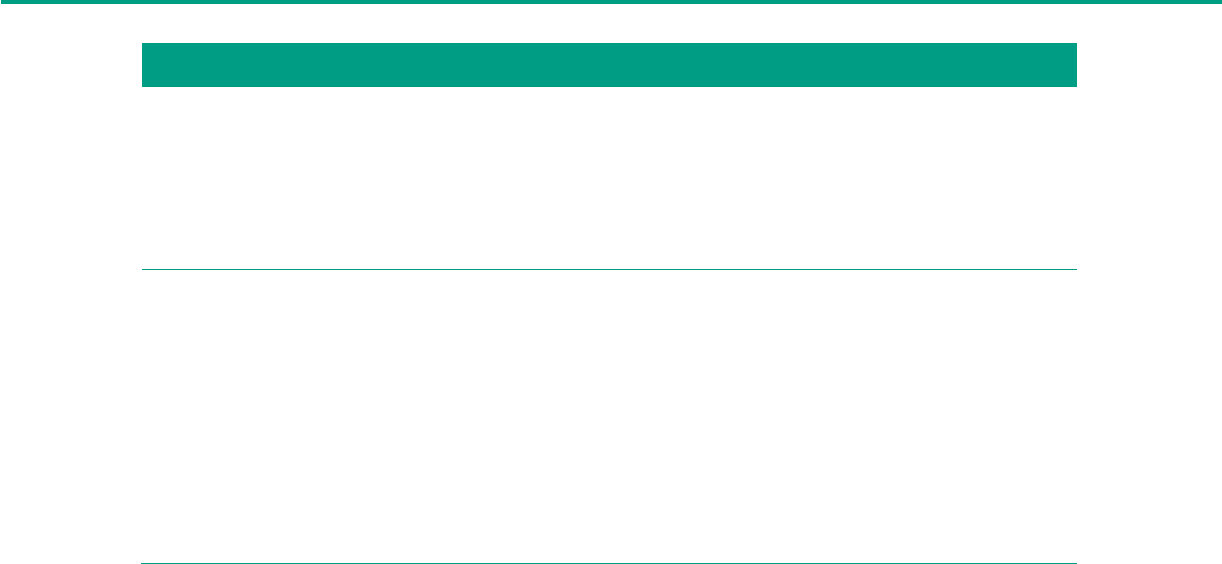
HIGHWAY SAFETY BENEFIT COST ANALYSIS GUIDE CHAPTER 5
58
CHALLENGE
OPPORTUNITY
Lack of expertise and support:
There may be a lack of technical
expertise or institutional support
within transportation agencies to
conduct BCA or to perform a
rigorous analysis.
Great strides have been made by transportation
agencies to understand and utilize BCA in decision
making. USDOT requires BCA in most grant
programs as a condition of funding and makes
resources like this Guide and Tool available to
agencies.
Concerns that the results of
BCA could conflict with
preferred or mandated
outcomes: Engineers,
transportation professionals, or the
agency may have a preferred
alternative prior to economic
analysis, which they may not want
to stray from regardless of the
economic benefits or impacts.
An objective and independent assessment of the
economic consequences of a project can contribute
valuable information to the decision process. There
may be an opportunity for the agency to establish
requirements or policies that force transportation
professionals to perform a BCA.
There are valid reasons why decision makers may choose to override or constrain economic
information. For example, if there are concerns that BCA results would disproportionately
favor projects in urban areas, policy makers can initially allocate funds between urban and rural
areas based on equity considerations. In this example, urban projects would then compete
based on their economic merits for the urban funds; rural projects would similarly compete for
the rural funds.
Another common hurdle involves the evaluation of a project that is a combination of two or
more independent, separable countermeasures. In such cases, the benefits of one may hide the
costs of the other. If building both maximizes their synergy, then considering each individually
may produce unfavorable results and lead to building neither.
As with any analysis method, BCA can, if misused, give erroneous results. Perhaps the first
cause of error in a BCA is the selection of an unrealistic base condition. Further, the
comparison of only one alternative to the base condition when other, potentially less costly,
alternatives exist, may bias the results. Poor data and analytical assumptions can also lead to
erroneous results, but this is handled by improving data collection methods, and carefully
documenting the process for calculating project costs and benefits.
Related to data inputs, it is important to include complete and properly-represented costs and
benefits in the analysis. First, the BCA should include all relevant user and non-user costs. The
analyst may overestimate benefits if they do not include the complete costs (or disbenefits)
associated with a project. This occurs most often when the analyst omits user costs or major
non-user costs. In some cases, an agency may focus only on local costs and benefits, failing to

HIGHWAY SAFETY BENEFIT COST ANALYSIS GUIDE CHAPTER 5
59
include those that accrue outside its immediate jurisdiction. Second, the analyst should take
care not to include benefits that are simply restatements of other benefits (or costs) measured
elsewhere in the BCA. This latter error, a form of double counting, can occur when the analyst
measures employment, business, or land use effects using an economic impact analysis, and then
adds the benefits of travel-time savings, safety improvements, and vehicle operating cost
reductions. For example, land uses and values can change due to transportation investments.
The land use changes stem, in part, from the reduced travel time. Counting both travel time
savings and land use impacts would be double counting. The differences between efficiency
improvements and impacts distinguish BCA from economic impact analysis.
It is important to include complete and properly-
represented costs and benefits in a BCA.
5.6 CHAPTER SUMMARY
Chapter 5 describes the key components and considerations in preparing for a BCA. It
describes the process for developing the base condition, setting an analysis period, evaluating
uncertainty in a BCA, and selecting an appropriate discount rate. It concludes with a discussion
of challenges encountered during BCA and opportunities to overcome those challenges.
Key Takeaways from Chapter 5:
• Accurately defining the base condition is critical to the success of BCA.
• The analyst should standardize the analysis period to ensure a fair comparison of
alternatives.
• One option for standardizing the analysis period is to use the least common multiple of
the service lives.
• Uncertainty is evaluated through sensitivity and probabilistic analysis.
• Two separate and distinct factors account for why the present value of a dollar
diminishes over time: inflation and discounting.
• Inflation is generally not considered in BCA.
• A BCA measures the time value of resources by an annual percentage factor known as
the discount rate. Typical discount rates range from three percent to seven percent,
which can change over time. Some grant programs specify the required discount rate
while each agency may establish its own discount rate for internal BCA.
• While there are several potential challenges to performing a BCA (e.g., data and analysis
capabilities, uncertainty in analysis parameters, and regulatory requirements), there are
at least as many opportunities to overcome those issues.

HIGHWAY SAFETY BENEFIT COST ANALYSIS GUIDE CHAPTER 5
60
THIS PAGE IS INTENTIONALLY LEFT BLANK

HIGHWAY SAFETY BENEFIT COST ANALYSIS GUIDE CHAPTER 6
61
6. CONDUCTING BCA FOR SAFETY
The BCA process is repeatable and defensible, given the use of quality data and reliable
methods to estimate project costs and benefits. This chapter describes methods to estimate
safety benefits (i.e., change in crash frequency by severity level) and the derivative operational
and environmental benefits (i.e., resulting impacts on travel time, travel time reliability, vehicle
operating costs, and emissions). Examples illustrate the methods to estimate the safety benefits
of single and multiple countermeasures at a given location. Refer to chapter 4 for default values
to quantify and monetize project benefits. Refer to chapter 7 for additional examples of BCA
for safety, including projects with a single countermeasure at a single location, projects with
multiple countermeasures at a single location, and projects with multiple locations.
Quality data and reliable methods are key to an
accurate BCA and defensible results.
Chapter 6 At-A-Glance
Chapter 6 is divided into six sections:
• Section 6.1 presents a method to estimate the change in safety performance.
• Section 6.2 presents a method to estimate the change in travel time related to safety.
• Section 6.3 presents a method to estimate the change in travel time reliability related to
safety.
• Section 6.4 presents a method to estimate the change in fuel use related to safety.
• Section 6.5 presents a method to estimate the change in emissions related to safety.
• Section 6.6 provides a summary of the chapter.
6.1 ESTIMATING SAFETY BENEFITS
Safety benefits are the expected change in crash frequency associated with a project alternative
relative to the base condition. In general, there is a need to estimate the safety performance of
the base condition, then estimate the safety performance of the alternative condition, and finally
take the difference to estimate the expected change in safety. One option for estimating the
change in safety is to apply CMFs to the long-term average safety performance for the base
condition. When relevant CMFs are not available, it may be appropriate to estimate the change
in safety performance by comparing the predicted crashes from one or more SPFs. For
example, CMFs do not exist for a project that would convert a rural, two-lane, undivided
highway to a rural, multilane, undivided highway; however, the Highway Safety Manual Part C

HIGHWAY SAFETY BENEFIT COST ANALYSIS GUIDE CHAPTER 6
62
Predictive Method provides SPFs and corresponding adjustment factors to estimate the safety
performance of these two conditions.
(7)
This Guide focuses on the use of CMFs to estimate the change in safety performance, assuming
the analyst has estimated the average annual crashes for the base condition. Refer to section 5.1
for developing the base condition. Refer to the Highway Safety Manual Part C Predictive
Method for further details on how to use SPFs and adjustment factors to estimate the safety
performance of the base condition and alternatives.
(7)
The Interactive Highway Safety Design
Model (IHSDM) and Highway Safety Manual spreadsheets are available to support the use of the
Highway Safety Manual Part C Predictive Method. State-specific SPFs may also be available for
such applications in estimating safety performance.
When possible, it is preferred to estimate the change in crashes by crash severity or crash type.
This allows for a more comprehensive analysis, considering the potential for different changes
by crash category. For example, if an agency is considering the installation of a cable median
barrier, this will likely reduce fatal and injury crashes, but may increase PDO crashes. This can
have an impact on the economic analysis because the average crash cost differs by crash
severity and crash type. When estimating the change in crashes by severity, the analyst can
apply crash costs by severity to reflect the difference in cost by severity. The analyst can then
aggregate the crash costs among the severity levels to estimate the net monetary benefit.
This Guide estimates the change in crashes by severity for reasons discussed in Table 8.
Further, the methods described in the following sections for estimating reductions in travel
time, vehicle operating costs, and emissions are based on changes in crash frequency by severity
level. This Guide uses the KABCO scale for injury severity as defined in section 4.1. To convert
combined severity levels (e.g., combined fatal and injury crashes) to the KABCO scale, it is
necessary to develop and apply a local crash severity distribution. Refer to section 6.1.2 below
for an example of how to convert combined severity levels to the KABCO scale. Refer to the
Highway Safety Manual for further information and additional guidance on developing estimates
of annual crashes by severity and developing local severity distributions.
(7)
This section describes two primary scenarios for applying CMFs: 1) estimating the safety effect
of a single countermeasure, and 2) estimating the safety effect of multiple countermeasures. It
then explains the process of applying average crash costs to estimate the monetary benefits
related to the expected change in crashes. Examples are provided to illustrate the application of
CMFs and crash costs. It concludes with a discussion of how to apply CMFs to estimate the
safety benefits associated with projects applied at multiple locations (e.g., systemic
countermeasures). This Guide assumes readers are familiar with the selection of applicable
CMFs. Refer to the CMF Clearinghouse for further guidance and resources on selecting and
applying CMFs to estimate safety benefits.

HIGHWAY SAFETY BENEFIT COST ANALYSIS GUIDE CHAPTER 6
63
CMFs are key to estimating the
expected change in crash frequency.
6.1.1 Estimating the Safety Benefit of a Single Countermeasure
Figure 12 shows the equation for estimating the crash frequency for the condition with the
treatment of interest. This is estimated as the crash frequency for the base condition multiplied
by the corresponding CMF, where the CMF represents the expected safety effect of the
treatment relative to the base condition. The safety benefit (or disbenefit) is the difference in
the estimated long-term crash frequency with and without treatment.
Figure 12. Equation. Estimating crashes for a single countermeasure.
This is a simple CMF application, using a CMF for total crashes to estimate the change in total
crashes. It is often more reliable to estimate the expected change in crashes by severity when
possible. This requires applicable CMFs by severity and estimates of crashes by severity for the
base condition. Further, it is important to apply crash costs by severity to the estimated change
in crashes by severity before aggregating to a net monetary benefit. The following example
illustrates the application of CMFs to estimate the change in crashes by severity.
It is often more reliable to estimate the
expected change in crashes by severity.
6.1.2 Example of Estimating the Safety Benefit of a Single Countermeasure
An agency is considering the installation of a cable median barrier and would like to estimate
the expected change in crashes by severity. The analyst identifies applicable CMFs from the
CMF Clearinghouse. The applicable CMF for fatal crashes is 0.57 (CMF ID 42), the applicable
CMF for injury crashes is 0.70 (CMF ID 43), and the applicable CMF for PDO crashes is 1.60
(note this CMF is an estimate based on local crash severity distributions and CMF IDs 42, 43,
and 44). This example assumes the CMF for injury crashes (i.e., all A-, B-, and C-level crashes
combined) applies to each individual injury severity. Table 19 shows the long-term average
crashes per year by severity under base conditions for the hypothetical scenario, the CMFs for
the respective crash severity levels, the estimated crash frequency with treatment, and the
expected change in crashes by severity. For example, the estimated annual K-level crashes
under base conditions is 0.1 crashes per year and the applicable CMF is 0.57. Applying the
equation in Figure 12 results in an estimate of 0.057 K-level crashes per year with treatment
(0.57 * 0.1). The difference is an estimated change (in this case a reduction) of 0.043 K-level
crashes per year.

HIGHWAY SAFETY BENEFIT COST ANALYSIS GUIDE CHAPTER 6
64
Table 19. Example application of CMFs by severity.
Crash
Severity
Estimated Annual
Crashes for Base
Conditions
Applicable
CMF
Estimated
Annual Crashes
With Treatment
Estimated
Annual
Reduction in
Crashes
K
0.1
0.57
0.057
0.043
A
1.2
0.70
0.84
0.36
B
2.4
0.70
1.68
0.72
C
4.0
0.70
2.80
1.20
O
10.0
1.60
16.00
-6.00
Total
17.7
--
21.377
-3.677
Note: -- indicates not applicable.
The net benefit is the sum of the estimated change in crashes by severity. In this case, the net
impact is an increase of 3.677 crashes per year (17.7 crashes under base conditions – 21.377
crashes with treatment). At first glance, it may appear that this alternative will not provide a
safety benefit; however, there is a reduction of 2.323 fatal and injury crashes. To estimate the
net monetary benefit, it is important to apply crash costs by severity to the estimated change in
crashes by severity before aggregating benefits across severity levels.
Table 20 shows the estimated annual change in crashes from Table 19 and the average crash
costs by severity from Table 9. The estimated annual monetary benefit is the product of the
estimated annual change in crashes and the average crash cost for the respective severity level.
For example, the estimated annual change in A-level crashes is 0.36 crashes per year and the
average cost of an A-level crash is $674,400. The result is a safety benefit of $242,784 per year
(0.36 A-level crashes per year * $674,400 per A-level crash). Aggregating the annual monetary
benefits across severity levels indicates the net monetary benefit. Now, it is apparent that the
installation of a median barrier is expected to provide a net safety benefit of $972,366 per year.

HIGHWAY SAFETY BENEFIT COST ANALYSIS GUIDE CHAPTER 6
65
Table 20. Example application of crash costs by severity.
Crash
Severity
Estimated Annual
Reduction in Crashes
Average Crash
Cost by Severity
Estimated Annual
Monetary Benefit
K
0.043
$11,637,900
$500,430
A
0.36
$674,400
$242,784
B
0.72
$204,100
$146,952
C
1.20
$129,000
$154,800
O
-6.00
$12,100
-$72,600
Total
-3.677
--
$972,366
Note: -- indicates not applicable.
While the application of CMFs and crash costs by severity is the preferred approach to
estimate net safety benefits, the approach is dependent on the availability of quality CMFs and
the ability to estimate the annual crashes for base conditions by crash severity. In some cases,
CMFs may only be available for total crashes or combinations of injury crashes (e.g., all KABC
crashes combined). As shown in the previous example, the CMF often varies by crash severity.
Until further research is completed to develop CMFs by individual severity level, one option is
to assume the CMF is the same for all crash severity levels included in the original CMF. For
example, if the original CMF is 0.8 and applies to total crashes, then the analyst could assume
the CMF is 0.8 for K, A, B, C, and O crashes. If two CMFs are available, one for KABC crashes
(i.e., all injury crashes combined) and one for PDO crashes, the analyst could assume the CMF
for KABC crashes is representative of K, A, B, and C crashes individually and the CMF for PDO
crashes represents O crashes individually. Again, it is important to recognize the limitations of
this assumption, which may lead to over- or underestimating changes in specific severity levels.
The preferred approach to estimate net safety benefits
is to apply CMFs and crash costs by severity.
When the estimated annual crashes for base conditions represent combined severity levels, it is
necessary to apply local crash severity distributions to develop estimates for the individual
categories of K, A, B, C, and O crashes. For example, consider a scenario in which the analyst
has an estimate of total annual crashes (i.e., all severity levels combined). The analyst would like
to develop individual estimates of annual K, A, B, C, and O crashes. To do so, there is a need to
develop and/or apply the local distribution of K, A, B, C, and O crashes. For example, if the
contemplated project is along a rural, two-lane road, then the analyst could develop the local
severity distribution by tabulating all crashes by severity level on rural, two-lane roads.

HIGHWAY SAFETY BENEFIT COST ANALYSIS GUIDE CHAPTER 6
66
Analysts can use local crash severity distributions to develop
estimates for individual crash severity levels (K, A, B, C, and O).
Table 21 shows an example for which the total crashes are tallied by severity. Of the 100
crashes along rural, two-lane roads in this jurisdiction, there are 2 K-level crashes, 5 A-level
crashes, 11 B-level crashes, 15 C-level crashes, and 67 PDO crashes. To estimate the individual
annual crashes by severity level, the analyst would apply the proportions in Table 21 to the
estimate of total annual crashes (i.e., all severity levels combined) at the specific location.
Table 21. Example of local severity distribution for total crashes.
Crash Severity
Crash Count by
Severity Level
Proportion of Crashes
by Severity Level
K
2
0.02
A
5
0.05
B
11
0.11
C
15
0.15
O
67
0.67
Total Crashes
100
1.00
As another example, consider a scenario in which the analyst has estimates of annual KABC
crashes (i.e., all injury crashes combined) as well as annual PDO crashes. The analyst already has
an individual estimate for PDO crashes, but there is a need to develop individual estimates of
annual K, A, B, and C crashes. In this case, the analyst would need to develop and apply the
severity distribution of K, A, B, and C crashes, as the proportion of all injury crashes. Using the
data presented in Table 21, the sum of all injury crashes is 33 (2 + 5 + 11 + 15). The proportion
of K, A, B, and C crashes, relative to all injury crashes, are 0.06, 0.15, 0.33, and 0.45,
respectively. To estimate the individual annual K, A, B, and C crashes, the analyst would apply
these proportions to the estimate of annual KABC crashes (i.e., all severity levels combined).
Refer to the Highway Safety Manual for further information and additional guidance on
developing estimates of annual crashes by severity and developing local severity distributions.
(7)
6.1.3 Estimating the Safety Benefit of Multiple Countermeasures
An agency may apply multiple countermeasures at a single location, such as signalizing a stop-
controlled intersection, adding turn lanes, and reducing the intersection skew. Each of these
countermeasures may have an associated CMF or a single CMF may represent the combined
effect of the countermeasures. The preferred approach to estimating the combined effect of

HIGHWAY SAFETY BENEFIT COST ANALYSIS GUIDE CHAPTER 6
67
multiple countermeasures is to use a single CMF that represents the combined effect of the
countermeasures. If a single CMF is available, the analyst would follow the process described in
section 6.1.1, Estimating the Safety Benefit of a Single Countermeasure, to estimate the safety
benefit. In the absence of such a CMF, the analyst may need to apply one or more CMFs to
estimate the combined safety effect.
The preferred approach to estimating the combined
effect of multiple countermeasures is to use a single
CMF that represents the combined effect.
In the absence of a CMF for the combined effect of multiple countermeasures, a single method
for estimating the combined effect is not appropriate in all scenarios. One consideration is the
applicability of the CMFs, as it is not appropriate to multiply two or more CMFs that apply to
different crash types and/or severities. Another consideration is the potential overlap among
individual countermeasures. Specifically, the effects of two or more countermeasures may
complement, overlap, or counteract each other. The analyst should apply judgment to
determine the likelihood and extent of overlapping effects among the contemplated
countermeasures, and select an appropriate method to estimate the combined safety benefit.
In general, the following guidance applies when the CMFs for two countermeasures apply to the
same crash types and severities:
• When there is complete overlap in countermeasure effects, the Dominant Effect
method generally performs well. The Dominant Effect method applies only the CMF for
the most effective countermeasure. In most cases, the Dominant Effect method provides
a conservative estimate of benefits and is appropriate for estimating the combined safety
effect of multiple countermeasures within a single project. The Dominant Effect method
may produce inconsistent estimates of the combined effect for different combinations of
countermeasures. As such, the analyst should be cautious in comparing the results from
the Dominant Effect method among projects.
• When multiple countermeasures are truly independent (i.e., zero overlap in crashes
impacted by the countermeasures), it is appropriate to assume the full effect of both
countermeasures using the Additive method. Figure 13 shows the equation for the
Additive method, which has an upper bound of 100 percent for the maximum effect of
multiple countermeasures (CMF
t
≥ 0).
Figure 13. Equation. Additive method for estimating the combined benefit of
multiple countermeasures.

HIGHWAY SAFETY BENEFIT COST ANALYSIS GUIDE CHAPTER 6
68
where:
CMF
t
= CMF for the combined countermeasures.
CMF
1
= CMF for the most effective countermeasure.
CMF
2
= CMF for the second most effective countermeasure.
• When both CMFs are less than 1.0, and there is some overlap in countermeasure effects
(i.e., second most effective countermeasure provides additional benefit, but the full
effect of the second most effective countermeasure is not realized due to overlap with
the most effective countermeasure), the Dominant Common Residuals method
generally performs well. Figure 14 shows the equation for the Dominant Common
Residuals method. In some cases, this method will produce a combined CMF that is
greater than the CMF for the most effective countermeasure. For example, if CMF
1
is
0.40 and CMF
2
is 0.80, then the combined effect (CMF
t
) using the equation in Figure 14
is 0.63. In cases where the Dominant Common Residuals method produces a combined
CMF that is greater than the CMF for the most effective countermeasure, the Dominant
Effect method is more appropriate, assuming the combination of countermeasures is as
effective as the most effective countermeasure.
Figure 14. Equation. Dominant common residuals method for estimating the
combined benefit of multiple countermeasures.
where: all terms as defined previously.
• When both CMFs are greater than 1.0 or there is a counteractive effect (i.e., second
countermeasure counteracts the effect of the first countermeasure), the Multiplicative
method generally performs well. Figure 15 shows the equation for the Multiplicative
method. This is a common scenario in the evaluation of design exceptions. For example,
a highway designer may consider installing advance curve warning signs to offset the
potential safety impacts of reducing the radius of curve due to topographical constraints.
Figure 15. Equation. Multiplicative method for estimating the combined benefit
of multiple countermeasures.
where: all terms as defined previously.
The prior guidance applies when the CMFs for two countermeasures apply to the same crash
types and severities. When the CMFs for two countermeasures apply to different crash types

HIGHWAY SAFETY BENEFIT COST ANALYSIS GUIDE CHAPTER 6
69
and/or severities, it is necessary to apply the CMFs individually to the respective crashes under
base conditions, and then aggregate, rather than combine the CMFs. The following four-step
process is generally applicable for estimating the combined effect of multiple countermeasures
when the individual CMFs apply to different crash types and/or severities:
1. Apply the CMF for the most effective countermeasure to the estimated crashes for the
applicable crash type/severity under base conditions.
2. Apply the CMF for the second most effective countermeasure to the estimated crashes
for the applicable crash type/severity under base conditions.
3. Sum the estimated change in crashes to calculate the net effect.
4. Check that the estimated change does not exceed 100 percent.
Using this four-step process, the analyst can apply the following guidance based on the potential
for overlapping countermeasure effects:
• When there is complete overlap in countermeasure effects, the Dominant Effect
method is appropriate. The Dominant Effect method applies only the CMF for the most
effective countermeasure. In this case, only step 1 is applicable, eliminating the need for
steps 2 – 4.
• When multiple countermeasures are truly independent (i.e., zero overlap in crashes
impacted by the countermeasures), it is appropriate to assume the full effect of both
countermeasures with an upper bound of 100 percent reduction (CMF
t
≥ 0). In this
case, all four steps are applicable.
• When there is some overlap in countermeasure effects, it is appropriate to expect the
full benefit of the most effective countermeasure and some additional benefit from the
second countermeasure. In this case, prior to performing step 2, consider removing any
crashes from the base condition that are already included in the base condition in step
1. Specifically, apply the CMF for the second countermeasure to only those base
condition crashes that are not already included in step 1.
Some methods perform better than this abbreviated guidance in specific scenarios. As such, a
more reliable approach for estimating the benefits of multiple countermeasures is to follow the
method selection process described in NCHRP Report 17-63, Guidance for the Development and
Application of Crash Modification Factors.
(35)
6.1.4 Example of Estimating the Safety Benefit of Multiple Countermeasures
An agency is considering the implementation of two countermeasures at an intersection along a
rural principal arterial and would like to estimate the expected change in crashes by severity.
The analyst identifies applicable CMFs from the CMF Clearinghouse and determines the CMFs
apply to the same crash type and severity levels. Further, the analyst determines there is likely

HIGHWAY SAFETY BENEFIT COST ANALYSIS GUIDE CHAPTER 6
70
some overlap in the countermeasure effects. For the first countermeasure, the applicable CMF
for fatal and injury crashes is 0.75 and the applicable CMF for PDO crashes is 1.10. For the
second countermeasure, the applicable CMF for fatal and injury crashes is 0.80 and the
applicable CMF for PDO crashes is 0.85. While it is preferred to use CMFs for the individual
categories of K, A, B, C, and O, CMFs do not always exist at this level of detail. In the absence
of such CMFs, one option is to assume the CMFs for fatal and injury crashes (i.e., all KABC
crashes combined) apply to each individual injury severity as described in section 6.1.2, Example
of Estimating the Safety Benefit of a Single Countermeasure.
Table 22 shows the CMFs by crash severity for both individual countermeasures, the selected
method for estimating the combined effect, and the estimated combined CMFs. The analyst
selects the Dominant Common Residuals method to estimate the combined effect on fatal and
injury crashes because both CMFs are less than 1.0 and there is some overlap expected in the
countermeasure effects. The analyst selects the Multiplicative method to estimate the combined
effect on PDO crashes because there is a counteractive effect (i.e., CMF
1
> 1.0 and CMF
2
<1.0).
Table 22. Example of combining CMFs.
Crash
Severity
Applicable CMF for
Countermeasure 1
Applicable CMF for
Countermeasure 2
Method to
Estimate
Combined
Effect
Estimated
Combined
CMF
K
0.75
0.80
DCR
0.68
A
0.75
0.80
DCR
0.68
B
0.75
0.80
DCR
0.68
C
0.75
0.80
DCR
0.68
O
1.10
0.85
Multiplicative
0.94
Note: DCR = Dominant Common Residuals.
Table 23 shows the long-term average crashes per year by severity under base conditions for
the hypothetical intersection, the estimated combined CMF by severity from Table 22, the
estimated crash frequency with treatment, and the expected change in crashes by severity. For
example, the estimated annual K-level crashes under base conditions is 0.1 crashes per year and
the combined CMF is 0.68. Applying the equation in Figure 12 results in an estimate of 0.068 K-
level crashes per year with treatment (0.68 * 0.1). The difference is an estimated change (in this
case a reduction) of 0.032 K-level crashes per year.

HIGHWAY SAFETY BENEFIT COST ANALYSIS GUIDE CHAPTER 6
71
Table 23. Example application of CMFs for multiple countermeasures.
Crash
Severity
Estimated Annual
Crashes for Base
Conditions
Estimated
Combined
CMF
Estimated
Annual Crashes
With Treatment
Estimated Annual
Reduction in
Crashes
K
0.1
0.68
0.068
0.032
A
1.2
0.68
0.816
0.384
B
2.4
0.68
1.632
0.768
C
4.0
0.68
2.72
1.28
O
10.0
0.94
9.4
0.6
Total
17.7
--
14.636
3.064
Note: -- indicates not applicable.
The net benefit is the sum of the estimated change in crashes by severity. In this case, the net
benefit is a reduction of 3.064 crashes per year (17.7 crashes under base conditions – 14.636
crashes with treatment). To estimate the net monetary benefits, it is important to apply crash
costs by severity to the estimated change in crashes by severity before aggregating to a net
monetary benefit.
6.2 ESTIMATING TRAVEL TIME BENEFITS
The NHTSA report, The Economic and Societal Impact of Motor Vehicle Crashes, provides a
methodology to estimate the average hours of delay per crash for five roadway facility types.
(11)
The NHTSA approach is particularly useful for monetizing the average delay hours per crash by
severity and roadway facility type. Table 24 provides the NHTSA values to estimate total
vehicle delay hours per crash by severity and roadway facility type. Refer to Table 10 for values
to monetize travel time or changes in travel time.
The estimated travel time benefit (delay reduction) is the product of the estimated reduction in
crashes and the vehicle delay factor (average delay per crash). Vehicle delay factors are based
on the total number of vehicles delayed, assuming one person per vehicle. Vehicle delay factors
represent the total person-hours of delay, not the average delay hours per person. As shown in
Table 24, vehicle delay factors vary based on the crash severity and facility type, ranging from
approximately ten hours per PDO crash to thousands of hours per fatal crash.

HIGHWAY SAFETY BENEFIT COST ANALYSIS GUIDE CHAPTER 6
72
Table 24. Vehicle delay hours by crash severity and roadway type (per crash).
(11)
Crash
Severity
Urban
Interstates/
Expressways
Urban
Arterials
Urban
Other
Rural Interstate/
Principal Arterials
Rural
Other
Fatal
5,147.70
1,258.26
207.88
1,780.31
104.82
Injury
345.29
68.56
15.40
207.68
13.86
PDO
215.00
49.94
10.32
146.25
10.33
Table 25 provides an example calculation for monetizing the travel time benefit that results
from a change in crashes. This example uses the estimated annual change in crashes from the
example in Table 23, the value of time from Table 10, and the delay hours per crash from Table
24, assuming the roadway facility is classified as a rural principal arterial. For example, for A-
injury crashes, the estimated delay reduction is 0.38 crashes per year * 207.68 hours per crash
(from Table 24) = 79.75 hours per year.
Table 25. Example monetization of travel time for a project on a rural principal
arterial (NHTSA methodology).
Crash Severity
Estimated Annual
Reduction in Crashes
(Table 23)
Vehicle Delay
per Crash
(Hours)
Delay
Reduction
(Hours)
K-Fatal
0.032
1780.31
56.97
A-Injury
0.38
207.68
79.75
B-Injury
0.77
207.68
159.50
C-Injury
1.28
207.68
265.83
O-PDO
0.60
146.25
87.75
Total Annual Delay
Reduction (Hours)
--
--
649.80
Unit Value of Time per
person-hour (Table 10)
--
--
$29.18
Total Annual Benefit
--
--
$18,961
Note: -- indicates not applicable.

HIGHWAY SAFETY BENEFIT COST ANALYSIS GUIDE CHAPTER 6
73
6.3 ESTIMATING TRAVEL TIME RELIABILITY BENEFITS
The SHRP2 C-11 Reliability Module provides a spreadsheet tool to assess travel time reliability.
The procedure is based on making estimates of recurring and nonrecurring congestion,
combining these estimates, and using predictive equations to develop reliability metrics. This
Guide and the Tool apply the SHRP2 C-11 procedures for estimating the time saved by more
reliable trips. These calculations are carried out using default values, user supplied inputs, and
internal calculations to estimate the change in buffer time.
The buffer time savings estimate involves minimal data development and model calibration,
which simplifies the analysis process, particularly for analysts who are not experts in traffic
engineering. To complete the estimation, the following data are required for the road segments
of interest:
• Roadway facility type (i.e., urban interstate/expressway, urban arterial, urban other,
rural interstate/principal arterial, or rural other).
• Analysis period (years).
• Length of construction period (years).
• Segment length (miles).
• Number of lanes (2 for two-lane roads; otherwise, number of lanes per direction).
• Free flow speed (mph).
• Traffic volume during peak period (total vehicles for all lanes = number of
vehicles/hour/lane * number of lanes * number of hours in peak period).
• Link capacity during peak period (passenger car equivalents for all lanes, or estimated by
the Highway Capacity Manual methods).
• Hours of peak traffic per day (e.g., number of hours in am and/or pm peak).
• Days of analysis per year (e.g., 365 for analysis of all days or 260 for analysis of weekday
travel time reliability).
• Annual discount rate (percent).
• Percent of trucks in the flow (percent).
• Personal value of time ($ per hour).
• Freight value of time ($ per hour).
• Reliability ratio personal (unitless).
• Reliability ratio freight (unitless).
• Percent reduction in crash frequency for each alternative (based on CMFs).

HIGHWAY SAFETY BENEFIT COST ANALYSIS GUIDE CHAPTER 6
74
The NHTSA approach defines safety-related benefits for five roadway facility types.
(11)
The
SHRP2 methods use five slightly different facility types from the Highway Capacity Manual
(HCM) to estimate capacity and the related reliability benefits. In general, these align with the
Highway Performance Monitoring System (HPMS) functional classification categories, where the
urban and rural ‘other’ categories include major and minor collector and local roads. The user
should select one of the NHTSA roadway facility types as being most representative of the
HCM facility of interest. The HCM categories are linked to the NHTSA categories as follows:
• HCM Urban Freeway = NHTSA Urban Interstate/Expressway.
• HCM Principal Arterial = NHTSA Urban Arterial.
• HCM Urban Other = NHTSA Urban Other.
• HCM Rural Freeway = NHTSA Rural Interstate/Principal Arterial.
• HCM Rural Other = NHTSA Rural Other.
Reliability is a concept related to trip time planning. A less reliable trip requires additional travel
time, referred to as buffer time, to assure an acceptable level of on-time arrival certainty. Thus,
the user should define a segment over which to estimate the change in buffer time from a
project. Segments can be of any length, but it is recommended that they not be so long that the
characteristics change dramatically along the segment, or too short that input is burdensome.
The following are examples of reasonable segment lengths:
• Restricted access roadways (e.g., freeways and interstates): define the analysis section
between two or more interchanges.
• Signalized arterial corridors: define the analysis section between two or more signals.
• Rural highways (non-freeways): define the analysis section in 2- to 5-mile segments.
The companion Highway Safety BCA Tool provides default values for link capacity and free flow
speed once the user selects the facility type of interest. The analyst should determine if the
default values are representative of the facility under review and adjust them as necessary. Since
facilities classified as ‘urban other’ or ‘rural other’ typically have low traffic volumes relative to
the capacity, the Tool does not estimate reliability benefits for these facilities.
Reliability is a concept normally associated with peak periods where the traffic flow is impacted
by incidents, including crashes. To determine the hours of buffer time saved per year, there is a
need to select the number of analysis days per year and the number of peak periods per day.
This Guide uses a default value of 260 analysis days per year (i.e., number of weekdays per
year). The peak period duration (i.e., hours of peak traffic per day) is required to estimate
roadway capacity, which is important for estimating buffer time. Typical peak period durations
range from one to three hours, and this Guide assumes two hours of peak traffic per day as the
default. If morning and evening peak periods have different characters (e.g., traffic volume and
free flow speed), then it may be necessary to evaluate each period separately.

HIGHWAY SAFETY BENEFIT COST ANALYSIS GUIDE CHAPTER 6
75
In addition, there is a need to determine if the value of time previously described for travel time
benefits is also appropriate for buffer time benefits. The SHRP2 C-11 documents discuss the
use of the reliability ratio. The reliability ratio is applied to the value of time to determine the
value of an hour of buffer time saved. The SHRP2 C-11 report indicates this value may be
different for personal and commercial buffer time benefits, and is generally set between 0.8 and
1.2. This Guide uses a default reliability ratio of 1.0 for personal trips and 1.2 for commercial
trips. The value of 1.0 assumes the value of reliability in travel time is equal to the value in travel
time for personal trips. The value of 1.2 assumes the value of reliability in travel time is 20
percent greater than the value in travel time for commercial trips.
For additional information on measuring reliability, refer to TRB’s SHRP2 report, Development
of Tools for Assessing Wider Economic Benefits of Transportation.
(36)
This report describes
spreadsheet-based tools designed to help calculate a transportation project's impact on travel
time reliability, market access, and intermodal connectivity. Chapter 7 provides examples that
include estimates of travel time reliability using the methods included in the SHRP2 C-11
Reliability Module.
6.4 ESTIMATING VEHICLE OPERATING COST BENEFITS
The NHTSA report, The Economic and Societal Impact Of Motor Vehicle Crashes, provides a
methodology for estimating fuel-related vehicle operating cost per crash for five roadway facility
types.
(11)
The NHTSA approach is particularly useful for monetizing fuel-related vehicle
operating cost per crash by crash severity and roadway facility type. Table 26 through Table 28
provide the NHTSA fuel-related vehicle operating cost in terms of gallons of fuel per crash and
total value of fuel per crash (assuming the average cost of fuel is approximately $2.76 per
gallon). Monetary values were updated using the CPI developed by the Bureau of Labor
Statistics. The cost of fuel per injury crash is the same for any injury level (A-, B-, or C-level
injury).
Table 26. Net increase in and cost of fuel consumption per fatal crash.
(11)
Facility Type
Fuel (Gallons)
Value (2017 Dollars)
Urban Interstate/Expressway
1951
$5,394
Urban Arterial
504
$1,392
Urban Other
39
$107
Rural Interstate/Principal Arterials
294
$811
Rural Other
36
$101
Average All Roadway Types
376
$1,040

HIGHWAY SAFETY BENEFIT COST ANALYSIS GUIDE CHAPTER 6
76
Table 27. Net increase in and cost of fuel consumption per injury crash.
(11)
Facility Type
Fuel (Gallons)
Value (2017 Dollars)
Urban Interstate/Expressway
412
$1,140
Urban Arterial
112
$309
Urban Other
17
$47
Rural Interstate/Principal Arterials
54
$149
Rural Other
9
$26
Average All Roadway Types
81
$224
Table 28. Net increase in and cost of fuel consumption per PDO crash.
(11)
Facility Type
Fuel (Gallons)
Value (2017 Dollars)
Urban Interstate/Expressway
351
$969
Urban Arterial
68
$187
Urban Other
10
$28
Rural Interstate/Principal Arterials
55
$153
Rural Other
8
$21
Average All Roadway Types
64
$176
Table 29 provides an example calculation for monetizing the change in fuel use that results from
a change in crashes. This example uses the estimated annual change in crashes from the
example in Table 23 and the fuel consumption per crash from Table 26 through Table 28. The
example assumes the roadway facility is classified as a rural principal arterial and the average
cost of fuel is $2.50 per gallon. For example, the fuel reduction associated with the reduction in
fatal crashes is 0.032 crashes per year * 294 gallons per crash (from Table 26) = 9.41 gallons
per year. For injury crashes, the relevant value is 54 gallons per crash for rural
interstate/principal arterial. For PDO crashes, the relevant value is 55 gallons per crash for rural
interstate/principal arterial.

HIGHWAY SAFETY BENEFIT COST ANALYSIS GUIDE CHAPTER 6
77
Table 29. Example monetization of fuel-related vehicle operating cost for a project
on a rural principal arterial (NHTSA methodology).
Crash Severity
Estimated Annual
Reduction in Crashes
(Table 23)
Gallons
per Crash
Fuel
Reduction
(gallons)
K-Fatal
0.032
294
9.41
A-Injury
0.38
54
20.74
B-Injury
0.77
54
41.47
C-Injury
1.28
54
69.12
O-PDO
0.60
55
33.00
Total Annual Fuel Reduction
(gallons)
--
--
173.74
Unit Value of Fuel (2017$/gallon)
--
--
$2.50
Total Annual Benefit
--
--
$434
Note: -- indicates not applicable.
6.5 ESTIMATING EMISSIONS BENEFITS
The NHTSA report, The Economic and Societal Impact of Motor Vehicle Crashes, provides a
methodology to estimate emissions reductions for five roadway facility types based on
reductions in crash frequency and severity.
(11)
Compared to other methods, the NHTSA
approach is useful for estimating air emissions by crash severity and roadway facility type. Refer
to Table 14 through Table 16 for the NHTSA monetized values of emissions per crash.
Table 30 provides an example calculation for monetizing the emissions benefit that results from
a change in crashes. This example uses the estimated annual change in crashes from the
example in Table 23 and the value of total emissions per crash from Table 14 through Table 16.
The example assumes the roadway facility is classified as a rural principal arterial. For example,
the total emissions reduction associated with the reduction in fatal crashes is 0.032 crashes per
year * $379.50 per crash (from Table 14) = $12.14 per year. For injury crashes, the relevant
value is $70.13 per crash for a rural principal arterial. For PDO crashes, the relevant value is
$71.03 per crash for a rural principal arterial. This example uses the total emissions value to
monetize the benefit of emissions reductions. Should an agency choose to monetize select
emissions (e.g., only CO
2
and NO
X
), then it would be necessary to replace the values of total
emissions with the values of select emissions from Table 14 through Table 16.

HIGHWAY SAFETY BENEFIT COST ANALYSIS GUIDE CHAPTER 6
78
Table 30. Example monetization of emissions for a project on a rural principal
arterial (NHTSA methodology).
Crash Severity
Estimated Annual
Reduction in Crashes
(Table 23)
Value of
Emissions
per Crash
Emissions
Reduction
(Dollars)
K-Fatal
0.032
379.5
12.14
A-Injury
0.38
70.13
26.93
B-Injury
0.77
70.13
53.86
C-Injury
1.28
70.13
89.77
O-PDO
0.60
71.03
42.62
Total Annual Benefit
--
--
$225
Note: -- indicates not applicable.
6.6 CHAPTER SUMMARY
Chapter 6 describes how to estimate the direct and indirect safety benefits for a BCA. The
chapter begins with a description of how to estimate the safety performance of a project
alternative relative to the base condition (i.e., expected change in crash frequency by severity).
It then describes how to estimate the operational and environmental benefits that result from a
change in safety performance. Examples throughout the chapter illustrate the process of
estimating benefits and then applying values from Chapter 4 to monetize the change in crashes,
travel time, travel time reliability, vehicle operating costs, and emissions.
Key Takeaways from Chapter 6:
• Quality data and reliable methods are key to an accurate BCA and defensible results.
• The Highway Safety Manual provides reliable methods for estimating the expected
change in safety performance (i.e., expected change in crash frequency and severity).
• Changes in safety performance impact travel time, vehicle operating costs, and air
emissions. The NHTSA report, The Economic and Societal Impact of Motor Vehicle Crashes,
provides a method to quantify the impact of crashes on travel time, fuel-related vehicle
operating costs, and air emissions.
(11)
• Changes in safety performance also impact travel time reliability. The SHRP2 C-11
Reliability Module provides a method to quantify the impact of crashes on travel time
reliability.

HIGHWAY SAFETY BENEFIT COST ANALYSIS GUIDE CHAPTER 7
79
7. PROJECT APPLICATIONS
Chapter 7 applies the methodologies explained in this Guide to various project examples. The
examples illustrate a range of topics described in this Guide, including user-defined and default
values, varying types of benefits and costs, the use of the discount rate, and various measures
used to compare project alternatives. The examples in this chapter use hypothetical numbers.
The purpose is to describe how to complete the calculations. Readers should not imply the
numbers are indicative of any specific type of safety modification. The calculations are carried
out in the Highway Safety BCA Tool following the guidance described in the previous chapters.
The reader can download the tool and follow along with the calculations.
Chapter 7 At-A-Glance
Chapter 7 provides examples for the following scenarios:
• Section 7.1 provides an example BCA for a single countermeasure where two project
alternatives are evaluated and compared to a base condition.
• Section 7.2 provides an example BCA for multiple countermeasures where a project
with multiple improvements at the same location is evaluated and compared to a base
condition. In this example, a CMF is available for the combined countermeasures (i.e.,
the combined safety effect of the multiple improvements is known).
• Section 7.3 provides an example BCA for multiple countermeasures where a project
with multiple improvements at the same location is evaluated and compared to a base
condition. In this example, a CMF is not available for the combined countermeasures
(i.e., the combined safety effect of the multiple improvements should be estimated from
individual CMFs).
• Section 7.4 provides an example BCA for multiple sites where an agency is considering
similar projects at multiple locations (similar to a systemic improvement project). The
example demonstrates how to assess the cost-effectiveness of each potential project
location and prioritize locations within a fixed budget.
7.1 SINGLE COUNTERMEASURE EXAMPLE
7.1.1 Project Background
For this example, consider a scenario where an agency is considering the conversion of a two-
way stop-controlled intersection along an urban arterial to a signalized intersection or a single-
lane roundabout. This represents a project with a single countermeasure, but two alternatives,
compared to the base condition. Alternative 1 evaluates the potential installation of a traffic

HIGHWAY SAFETY BENEFIT COST ANALYSIS GUIDE CHAPTER 7
80
signal, while Alternative 2 evaluates the potential construction of a roundabout. The base
condition represents no change in existing conditions (i.e., maintaining the urban, two-lane,
two-way stop-controlled intersection). The facility type best matches the ‘urban arterial’
category as described in section 6.3.
In this example, the free flow speed is 45 mph, the traffic volume in the peak period is 1,600
vehicles per hour per lane, and the peak period is two hours per day. Multiplying the 1,600
vehicles per hour per lane by one lane in one direction and again by the two hours of peak
traffic per day, there is a total of 3,200 vehicles per direction during the peak period. As
described in section 6.3, the analyst should define a segment over which to estimate the change
in buffer time from a project. For signalized arterial corridors, it is reasonable to define the
segment length between two or more signals. In this case, the analysis section is 0.8 miles,
which includes the intersection of interest and the nearest adjacent signalized intersections.
The following sections provide further detail on the project location and facility conditions
based on typical user input or default values from the Highway Safety BCA Tool.
7.1.2 Project Cost
Table 31 presents the service life, construction period, and project costs, including initial
construction costs and annual maintenance costs, for the traffic signal and roundabout. The
analyst selects an analysis period of 20 years as the lowest common multiple of the service lives.
The construction period is entered in whole years, and it is assumed each alternative would be
constructed within one year. Alternative 1 would require reconstruction after the useful
service life, which would occur at the end of year 11 (10 years after construction). The
reconstruction cost and annual maintenance costs are converted to present values, using the
equation provided in Figure 9 (Chapter 5), a discount rate of 3.0 percent, and the expected
service life of the project. Figure 16 shows the equation to convert annual costs for a given year
to a present value. In this case, the equation shows the conversion of annual maintenance costs
for year 21 for alternative 1. [Note this is year 20 after construction plus the one-year
construction period.]

HIGHWAY SAFETY BENEFIT COST ANALYSIS GUIDE CHAPTER 7
81
Table 31. Project costs for single countermeasure example, 2017 present value $.
Project Costs
Alternative 1
Traffic Signal
Alternative 2
Roundabout
Service life
10 years
20 years
Construction period
1 year
1 year
Initial project cost
$300,000
$900,000
Annual maintenance cost
$8,000
$0
Present value of reconstruction,
rehabilitation, and maintenance costs
$320,356
$0
Total Present Value Cost
$620,356
$900,000
Figure 16. Equation. Example conversion of annual cost to present value cost for
year 21 (Alternative 1).
Table 32 provides an amortization table to illustrate the calculation of present value costs from
the annual maintenance costs for both alternatives. [Note the value of t for the equation in
Figure 9, for this case, is the years after construction plus one to account for the one-year
construction period of either alternative.]

HIGHWAY SAFETY BENEFIT COST ANALYSIS GUIDE CHAPTER 7
82
Table 32. Amortization table for maintenance costs.
Years After
Construction
Alternative 1
Alternative 2
1
$7,541
$0
2
$7,321
$0
3
$7,108
$0
4
$6,901
$0
5
$6,700
$0
6
$6,505
$0
7
$6,315
$0
8
$6,131
$0
9
$5,953
$0
10
$5,779
$0
11
$210,414
$0
12
$5,448
$0
13
$5,289
$0
14
$5,135
$0
15
$4,985
$0
16
$4,840
$0
17
$4,699
$0
18
$4,562
$0
19
$4,429
$0
20
$4,300
$0
Present Value
$320,356
$0
7.1.3 Estimated Annual Change in Crashes
Table 33 and Table 34 show the process to estimate the change in crashes between the base
condition and build alternatives. All calculations are rounded to three decimals. In general, it is
desirable to estimate the change in crashes and associated costs by severity. As such, the
estimates are developed using the KABCO injury scale.
The estimated annual crashes under base conditions (column 2) represent the expected crashes
using the EB method. In this case, the EB method combines the predicted crashes from an
applicable, calibrated SPF (i.e., SPF for urban, two-lane, two-way stop-controlled intersection)
and the observed crash history for the existing two-way stop-controlled intersection. While the

HIGHWAY SAFETY BENEFIT COST ANALYSIS GUIDE CHAPTER 7
83
average observed crash history is one option to estimate the long-term average safety
performance under base conditions, the EB method provides a more reliable estimate,
accounting for changes in traffic volume and regression-to-the-mean.
The third column shows the applicable, high-quality CMFs from the CMF Clearinghouse. For
alternative 1, CMF ID 322 is selected to represent the safety effects of installing a traffic signal
at an urban, two-way stop-controlled intersection. For alternative 2, CMF ID 233 is selected to
represent the safety effects of constructing a roundabout at an urban, two-way stop-controlled
intersection. Both CMFs are applicable to all crash types and all crash severities. While it is
preferable to use CMFs that apply to the individual severity levels, this is limited by the
availability of quality CMFs. As described in section 6.1, Estimating Safety Benefits, it may be
necessary to assume the CMF for all crashes applies to K, A, B, C, and O crashes individually.
This is the assumption in this example, recognizing the limitations (i.e., assuming the CMF is the
same for each crash severity level may lead to over- or underestimating changes in specific
severity levels).
The fourth column shows the estimated annual crashes with the given alternative. This is the
product of the estimated annual crashes for base conditions (column 2) and the CMF (column
3). As an example, the estimated annual fatal crashes with alternative 1 is calculated as the
product of the estimated annual fatal crashes under base conditions and the traffic signal CMF
for fatal crashes (0.05 crashes per year * 0.95 = 0.048 crashes per year). The final column
shows the estimated annual reduction in crashes, which is the difference between the estimated
annual crashes under based conditions (column 2) and the estimated annual crashes with the
alternative (column 4).
Table 33. Estimated change in crashes by severity for alternative 1 (traffic signal).
Crash
Severity
Estimated Annual
Crashes for Base
Condition
CMF*
Estimated Annual
Crashes with
Alternative 1
Estimated Annual
Reduction in
Crashes
K-Fatal
0.050
0.950
0.048
0.003
A-Injury
0.670
0.950
0.637
0.034
B-Injury
0.790
0.950
0.751
0.040
C-Injury
3.670
0.950
3.487
0.184
O-PDO
8.670
0.950
8.237
0.434
* Assumes CMF is the same for all crash severity levels, which may over- or underestimate changes in specific crash severity levels.

HIGHWAY SAFETY BENEFIT COST ANALYSIS GUIDE CHAPTER 7
84
Table 34. Estimated change in crashes by severity for alternative 2 (roundabout).
Crash
Severity
Estimated Annual
Crashes for Base
Condition
CMF*
Estimated Annual
Crashes with
Alternative 2
Estimated Annual
Reduction in
Crashes
K-Fatal
0.050
0.610
0.031
0.020
A-Injury
0.670
0.610
0.409
0.261
B-Injury
0.790
0.610
0.482
0.308
C-Injury
3.670
0.610
2.239
1.431
O-PDO
8.670
0.610
5.289
3.381
* Assumes CMF is the same for all crash severity levels, which may over- or underestimate changes in specific crash severity levels.
7.1.4 Project Benefits
Project benefits are monetized using the estimated reductions in crashes by severity (Table 33
and Table 34). The NHTSA methods, described in Chapter 6, are used to calculate reductions
in travel time delay, vehicle operating costs, and emissions. The SHRP2 Reliability Module
adapted for use in the Tool is used to estimate travel time reliability benefits associated with a
change in crashes. The sections below provide the detailed calculations for each of these
benefits. In this example, the project location is along an urban arterial, which corresponds to
the ‘urban arterial’ category in the NHTSA method.
7.1.4.1 Safety
Table 35 and Table 36 show the process to estimate the monetary project benefit based on the
change in crashes from the base condition to the build alternative. This example uses the
default monetary values of crashes by severity from Table 9 in section 4.1.1, Value of Crashes.
The estimated annual safety benefit (column 4) is the product of the estimated annual change in
crashes (column 2) and the crash value (column 3). As an example, the monetary benefit for the
change in fatal crashes for alternative 1 is the product of the estimated annual change in fatal
crashes and the default fatal crash value (0.003 crashes per year * $11,637,947 per crash =
$29,095 per year). The total annual safety benefit related to the reduction in crashes is $88,670
for alternative 1 (traffic signal) and $691,625 for alternative 2 (roundabout).

HIGHWAY SAFETY BENEFIT COST ANALYSIS GUIDE CHAPTER 7
85
Table 35. Monetary safety benefit for alternative 1 (traffic signal).
Crash Severity
Estimated Annual
Reduction in
Crashes
Crash Value
(2017 Dollars)
Estimated Annual
Safety Benefit
K-Fatal
0.003
$11,637,947
$29,095
A-Injury
0.034
$674,353
$22,591
B-Injury
0.040
$204,143
$8,064
C-Injury
0.184
$129,001
$23,672
O-PDO
0.434
$12,108
$5,249
TOTAL ANNUAL BENEFIT
--
--
$88,670
Note: -- indicates not applicable.
Table 36. Monetary safety benefit for alternative 2 (roundabout).
Crash Severity
Estimated Annual
Reduction in
Crashes
Crash Value
(2017 Dollars)
Estimated Annual
Safety Benefit
K-Fatal
0.020
$11,637,947
$226,940
A-Injury
0.261
$674,353
$176,208
B-Injury
0.308
$204,143
$62,896
C-Injury
1.431
$129,001
$184,639
O-PDO
3.381
$12,108
$40,941
TOTAL ANNUAL BENEFIT
--
--
$691,625
Note: -- indicates not applicable.
7.1.4.2 Travel Time
Table 37 and Table 38 show the process to estimate the monetary project benefit for travel
time reductions due to the change in crashes from the base condition to the build alternative.
This example uses the NHTSA delay factors from Table 24 and the NHTSA monetary value of
time for ‘urban arterial’ from Table 10. The estimated annual delay reduction (column 4) is the
product of the estimated annual change in crashes (column 2) and the NHTSA delay factor
(column 3). As an example, the estimated annual delay reduction for A-injury crashes for
alternative 1 is the product of the estimated annual change in A-injury crashes and the NHTSA
delay factor for injury crashes (0.034 crashes per year * 68.56 hours per crash = 2.30 hours per
year). The total annual travel time benefit related to the reduction in crashes is $1,127 for
alternative 1 (traffic signal) and $8,794 for alternative 2 (roundabout).

HIGHWAY SAFETY BENEFIT COST ANALYSIS GUIDE CHAPTER 7
86
Table 37. Monetary travel time benefit for alternative 1 (traffic signal).
Crash Severity
Estimated Annual
Reduction in
Crashes
NHTSA
Delay Factor
(Hours per Crash)
Estimated Annual
Delay Reduction
(Hours)
K-Fatal
0.003
1258.26
3.15
A-Injury
0.034
68.56
2.30
B-Injury
0.040
68.56
2.71
C-Injury
0.184
68.56
12.58
O-PDO
0.434
49.94
21.65
Annual Delay
Reduction (Hours)
--
--
42.38
Value of Time
(Dollars per Hour)
--
--
$26.60
TOTAL ANNUAL
BENEFIT (DOLLARS)
--
--
$1,127.48
Note: -- indicates not applicable.
Table 38. Monetary travel time benefit for alternative 2 (roundabout).
Crash Severity
Estimated Annual
Reduction in
Crashes
NHTSA
Delay Factor
(Hours per Crash)
Estimated Annual
Delay Reduction
(Hours)
K-Fatal
0.020
1258.26
24.54
A-Injury
0.261
68.56
17.91
B-Injury
0.308
68.56
21.12
C-Injury
1.431
68.56
98.13
O-PDO
3.381
49.94
168.86
Annual Delay
Reduction (Hours)
--
--
330.57
Value of Time
(Dollars per Hour)
--
--
$26.60
TOTAL ANNUAL
BENEFIT (DOLLARS)
--
--
$8,794.36
Note: -- indicates not applicable.

HIGHWAY SAFETY BENEFIT COST ANALYSIS GUIDE CHAPTER 7
87
7.1.4.3 Travel Time Reliability
As discussed in Chapter 6, travel time reliability benefits associated with a change in crashes are
estimated using the procedures developed for the SHRP2 Reliability Module spreadsheet tool.
Table 39 summarizes the input values for the proposed alternatives, including user inputs and
defaults from this Guide. Note the inputs for travel time reliability are the same for both
alternatives. Using the Highway Safety BCA Tool, the reduction in annual weekday buffer time
for alternative 1 is 49 hours, which equates to an annual value of $1,575 for travel time
reliability benefits. The reduction in annual weekday buffer time for alternative 2 is 383 hours,
which equates to an annual value of $12,238 for travel time reliability benefits.
Table 39. Travel time reliability inputs for single countermeasure example.
Variable
Value
Analysis Period (years)
20
Length of Construction Period (years)
1
Total Time Period (analysis period plus construction period)
21
Segment Length (miles)
0.8
Number of Lanes (2 for 2-lane roads; otherwise, number of
lanes in one direction)
1
Free Flow Speed (mph)
45
Traffic Volume (total vehicles during peak period)
3,200
Link Capacity (total vehicles during peak period)
3,600
Hours of Peak Traffic per Day
2
Days of Analysis per Year
260
Annual Discount Rate (percent)
3%
Percent of Trucks in the Flow (percent)
5%
Fuel Cost (dollars/gallon)
$2.50
Personal Value of Time ($/hr.)
$26.06
Freight Value of Time ($/hr.)
$36.90
Calculated Combined Value of Time ($/hr.)
$26.60
Reliability Ratio Passenger
1
Reliability Ratio Freight
1.2

HIGHWAY SAFETY BENEFIT COST ANALYSIS GUIDE CHAPTER 7
88
7.1.4.4 Vehicle Operating Cost
Table 40 and Table 41 show the process to estimate the monetary project benefit for changes
in fuel use due to the change in crashes from the base condition to the build alternative. This
example uses the NHTSA fuel factors from Table 26 through Table 28 for ‘urban arterial,’
assuming an average fuel cost of $2.50 per gallon. The estimated annual fuel reduction (column
4) is the product of the estimated annual change in crashes (column 2) and the NHTSA fuel
factor (column 3). As an example, the estimated annual fuel reduction for PDO crashes for
alternative 1 is the product of the estimated annual change in PDO crashes and the NHTSA fuel
factor for PDO crashes (0.434 crashes per year * 68.00 gallons per crash = 29.48 gallons per
year). The total annual fuel benefit related to the reduction in crashes is $149 for alternative 1
(traffic signal) and $1160 for alternative 2 (roundabout).
Table 40. Monetary fuel-related benefit for alternative 1 (traffic signal).
Crash Severity
Estimated Annual
Reduction in
Crashes
NHTSA Fuel
Factor (Gallons
per Crash)
Estimated Annual
Fuel Reduction
(Gallons)
K-Fatal
0.003
504.00
1.26
A-Injury
0.034
112.00
3.75
B-Injury
0.040
112.00
4.42
C-Injury
0.184
112.00
20.55
O-PDO
0.434
68.00
29.48
Annual Fuel
Reduction (Gallons)
--
--
59.47
Value of Fuel
(Dollars per Gallon)
--
--
$2.50
Total Annual
Benefit (Dollars)
--
--
$148.67
Note: -- indicates not applicable.

HIGHWAY SAFETY BENEFIT COST ANALYSIS GUIDE CHAPTER 7
89
Table 41. Monetary fuel-related benefit for alternative 2 (roundabout).
Crash Severity
Estimated Annual
Reduction in
Crashes
NHTSA Fuel
Factor (Gallons
per Crash)
Estimated Annual
Fuel Reduction
(Gallons)
K-Fatal
0.020
504.00
9.83
A-Injury
0.261
112.00
29.27
B-Injury
0.308
112.00
34.51
C-Injury
1.431
112.00
160.31
O-PDO
3.381
68.00
229.93
Annual Fuel
Reduction (Gallons)
--
--
463.83
Value of Fuel
(Dollars per Gallon)
--
--
$2.50
Total Annual
Benefit (Dollars)
--
--
$1,159.59
Note: -- indicates not applicable.
7.1.4.5 Emissions
Table 42 and Table 43 show the process to estimate the monetary project benefit for emissions
reductions due to the change in crashes from the base condition to the build alternative. This
example uses the NHTSA values of total emissions from Table 14 through Table 16 for ‘urban
arterial.’ The estimated annual emissions benefit (column 4) is the product of the estimated
annual change in crashes (column 2) and the NHTSA values of total emissions (column 3). As an
example, the estimated annual emissions benefit for PDO crashes for alternative 1 is the
product of the estimated annual change in PDO crashes and the NHTSA value of total
emissions for PDO crashes (0.434 crashes per year * $56.75 per crash = $24.60 per year). The
total annual emissions benefit related to the reduction in crashes is $49 for alternative 1 (traffic
signal) and $384 for alternative 2 (roundabout).

HIGHWAY SAFETY BENEFIT COST ANALYSIS GUIDE CHAPTER 7
90
Table 42. Monetary emissions benefit for alternative 1 (traffic signal).
Crash Severity
Estimated Annual
Reduction in
Crashes
NHTSA Value
of Emissions
(Dollars per Crash)
Estimated Annual
Emissions Benefit
(Dollars)
K-Fatal
0.003
$419.84
$1.05
A-Injury
0.034
$92.57
$3.07
B-Injury
0.040
$92.57
$3.62
C-Injury
0.184
$92.57
$16.83
O-PDO
0.434
$56.75
$24.60
Total Annual
Benefit (Dollars)
--
--
$49.17
Note: -- indicates not applicable.
Table 43. Monetary emissions benefit for alternative 2 (roundabout).
Crash Severity
Estimated Annual
Reduction in
Crashes
NHTSA Value
of Emissions
(Dollars per Crash)
Estimated Annual
Emissions Benefit
(Dollars)
K-Fatal
0.020
$419.84
$8.19
A-Injury
0.261
$92.57
$23.96
B-Injury
0.308
$92.57
$28.25
C-Injury
1.431
$92.57
$131.24
O-PDO
3.381
$56.75
$191.90
Total Annual
Benefit (Dollars)
--
--
$383.54
Note: -- indicates not applicable.
7.1.5 BCA Result
Table 44 presents the results of the BCA. Table 45 and Table 46 provide the present value of
project benefits for each category over the analysis period, using the equation provided in
Figure 9 (Chapter 5), a discount rate of 3.0 percent, and the expected service life of the
project. In this case, the value of t for the equation in Figure 9, is the years after construction
plus one to account for the one-year period to construct either alternative. The service life of
the traffic signal is 10 years and the service life of the roundabout is 20 years. Thus, to calculate
the full net present value of the traffic signal over the same analysis period as the roundabout
(i.e., 20 years), a replacement signal would be necessary in year 11. Table 45 shows how the
benefits would continue to accrue in this period. Figure 17 shows the conversion of the annual

HIGHWAY SAFETY BENEFIT COST ANALYSIS GUIDE CHAPTER 7
91
safety benefit to a present value benefit for year 21 for alternative 1, using the equation from
Figure 9. [Note this is year 20 after construction plus the one-year construction period.]
Figure 17. Equation. Example conversion of annual safety benefit to present value
benefit for year 21 (alternative 1).
In this example, the benefits exceed the costs for alternative 1, with a net present value of
$702,556 ($1,322,912 – $620,356). The net present value of alternative 2 is $9,418,036
($10,318,036 – $900,000). Both alternatives provide positive net benefits and BCR greater than
1.0. As such, both alternatives are economically-justified. Alternative 2 costs more to deploy
over the 20-year analysis period, but offers nearly eight times the amount of benefits as
alternative 1. Thus, the BCR for alternative 2 is greater than the BCR for alternative 1 (11.46
compared to 2.13). A budget-constrained agency might find the higher efficiency of alternative
2, $11.46 returned for each dollar spent, more desirable that alternative 1.
Table 44. BCA results for single countermeasure example.
Project Costs and Benefits
Present Value
Alternative 1
(Traffic Signal)
Present Value
Alternative 2
(Roundabout)
Initial Cost
$300,000
$900,000
Present Value of Reconstruction,
Rehabilitation, and Annual Maintenance Costs
$320,356
$0
Present Value of Costs (Dollars)
$620,356
$900,000
Present Value of Safety Benefit
$1,280,761
$9,989,932
Present Value of Travel Time Benefit
$16,286
$127,027
Present Value of Reliability Benefit
$23,475
$182,431
Present Value of Fuel Use Benefit
$2,147
$16,749
Present Value of Emissions Benefit
$243
$1,896
Present Value of Benefits (Dollars)
$1,322,912
$10,318,036
Net Present Value
$702,556
$9,418,036
Benefit-Cost Ratio
2.13
11.46

HIGHWAY SAFETY BENEFIT COST ANALYSIS GUIDE CHAPTER 7
92
Table 45. Amortization table of project benefits for alternative 1 (traffic signal).
Years After
Construction
Safety
Travel Time
Reliability
Fuel Use
Emissions
1
$83,580
$1,063
$1,575
$140
$16
2
$81,145
$1,032
$1,484
$136
$15
3
$78,782
$1,002
$1,441
$132
$15
4
$76,487
$973
$1,399
$128
$15
5
$74,260
$944
$1,358
$125
$14
6
$72,097
$917
$1,319
$121
$14
7
$69,997
$890
$1,280
$117
$13
8
$67,958
$864
$1,243
$114
$13
9
$65,979
$839
$1,207
$111
$13
10
$64,057
$815
$1,172
$107
$12
11
$62,191
$791
$1,138
$104
$12
12
$60,380
$768
$1,105
$101
$11
13
$58,621
$745
$1,072
$98
$11
14
$56,914
$724
$1,041
$95
$11
15
$55,256
$703
$1,011
$93
$10
16
$53,647
$682
$981
$90
$10
17
$52,084
$662
$953
$87
$10
18
$50,567
$643
$925
$85
$10
19
$49,094
$624
$898
$82
$9
20
$47,664
$606
$872
$80
$9
Present Value
$1,280,761
$16,286
$23,475
$2,147
$243

HIGHWAY SAFETY BENEFIT COST ANALYSIS GUIDE CHAPTER 7
93
Table 46. Amortization table of project benefits for alternative 2 (roundabout).
Years After
Construction
Safety
Travel Time
Reliability
Fuel Use
Emissions
1
$651,923
$8,290
$12,238
$1,093
$124
2
$632,935
$8,048
$11,536
$1,061
$120
3
$614,500
$7,814
$11,200
$1,030
$117
4
$596,602
$7,586
$10,874
$1,000
$113
5
$579,225
$7,365
$10,557
$971
$110
6
$562,354
$7,151
$10,249
$943
$107
7
$545,975
$6,942
$9,951
$915
$104
8
$530,073
$6,740
$9,661
$889
$101
9
$514,634
$6,544
$9,380
$863
$98
10
$499,644
$6,353
$9,106
$838
$95
11
$485,092
$6,168
$8,841
$813
$92
12
$470,963
$5,989
$8,584
$790
$89
13
$457,245
$5,814
$8,334
$767
$87
14
$443,928
$5,645
$8,091
$744
$84
15
$430,998
$5,480
$7,855
$723
$82
16
$418,444
$5,321
$7,627
$702
$79
17
$406,257
$5,166
$7,404
$681
$77
18
$394,424
$5,015
$7,189
$661
$75
19
$382,936
$4,869
$6,979
$642
$73
20
$371,782
$4,727
$6,776
$623
$71
Present Value
$9,989,932
$127,027
$182,431
$16,749
$1,896

HIGHWAY SAFETY BENEFIT COST ANALYSIS GUIDE CHAPTER 7
94
7.2 MULTIPLE COUNTERMEASURE EXAMPLE #1
7.2.1 Project Background
For this example, consider a scenario where an agency is considering two countermeasures,
paved shoulder widening (from 4-ft to 6-ft shoulders) and the installation of shoulder rumble
strips, to address safety concerns related to run-off-road crashes along a rural, four-lane
principal arterial. This represents a project with multiple countermeasures as part of one
alternative compared to the base condition. The base condition represents no change in
existing conditions (i.e., maintaining the rural, multilane road without shoulder widening or
rumble strips). In this example, the free flow speed is 60 mph, the traffic volume in the peak
period is 1,750 vehicles per hour per lane, and the peak period is two hours per day.
Multiplying the 1,750 vehicles per hour per lane by two lanes in one direction and again by the
two hours of peak traffic per day, there is a total of 7,000 vehicles per direction during the peak
period. The improvements would extend for 9 miles, from milepost 1.0 to milepost 10.0. The
facility type best matches the ‘rural interstate / principal arterial’ category as described in
section 6.3. The following sections provide further detail on the project location and facility
conditions based on typical user input or default values from the Highway Safety BCA Tool.
7.2.2 Project Cost
Table 47 presents the service life and project costs for the two countermeasures. The
estimated initial construction cost is $100,000 per mile to widen the outside paved shoulder
from 4 feet to 6 feet in both directions. The annual maintenance cost is negligible for the
additional paved shoulder width. The estimated initial construction cost is $3,000 per mile to
install rumble strips on the outside paved shoulder in both directions. The annual maintenance
cost is negligible for the shoulder rumble strips.
Table 47. Project costs for multiple countermeasure example #1, 2017 present
value $.
Project Costs
Countermeasure 1
Widen Shoulder
Countermeasure 2
Rumble Strips
Service life
7 years
7 years
Construction period
1 year
1 year
Initial project cost
$900,000
$27,000
Annual maintenance cost
$0
$0
Present value of maintenance costs
$0
$0
Total Present Value Cost
$900,000
$27,000

HIGHWAY SAFETY BENEFIT COST ANALYSIS GUIDE CHAPTER 7
95
7.2.3 Estimated Annual Change in Crashes
Table 48 shows the process to estimate the change in crashes between the base condition and
build alternative. All calculations are rounded to three decimals. In general, it is desirable to
estimate the change in crashes and associated costs by severity. As such, the estimates are
developed using the KABCO injury scale.
The estimated annual crashes under base conditions (column 2) represent the expected crashes
using the EB method. The EB method combines predicted crashes from an applicable, calibrated
SPF (i.e., SPF for rural, multilane roads) and the observed crash history for the existing rural,
multilane road. While the average observed crash history is one option to estimate the long-
term average safety performance under base conditions, the EB method provides a more
reliable estimate, accounting for changes in traffic volume and regression-to-the-mean.
The third column shows the applicable, high-quality CMF from the CMF Clearinghouse. It is
desirable to use a single CMF that represents the combined effect rather than using multiple
CMFs to estimate the combined effect of two or more countermeasures. In this case, the CMF
Clearinghouse provides a CMF for the combined countermeasure “install shoulder rumble
strips and widen shoulder” (CMF ID 6669). This CMF applies to all crash types and all crash
severities on rural, multilane roads. While it is preferable to use CMFs that apply to the
individual severity levels, this is limited by the availability of quality CMFs. As described in
section 6.1, Estimating Safety Benefits, it may be necessary to assume the CMF for all crashes
applies to K, A, B, C, and O crashes individually. This is the assumption in this example,
recognizing the limitations (i.e., assuming the CMF is the same for each crash severity level may
lead to over- or underestimating changes in specific severity levels). Refer to 7.3, Multiple
Countermeasure Example #2, for an example application of two CMFs to estimate the combined
effect of multiple countermeasures.
The fourth column shows the estimated annual crashes with the given alternative. This is the
product of the estimated annual crashes for base conditions (column 2) and the CMF (column
3). As an example, the estimated annual fatal crashes with both countermeasures is calculated
as the product of the estimated annual fatal crashes under base conditions and the CMF for
fatal crashes (0.100 crashes per year * 0.35 = 0.035 crashes per year). The final column shows
the estimated annual reduction in crashes, which is the difference between the estimated annual
crashes under base conditions (column 2) and the estimated annual crashes with both
countermeasures (column 4).

HIGHWAY SAFETY BENEFIT COST ANALYSIS GUIDE CHAPTER 7
96
Table 48. Estimated change in crashes by severity for multiple countermeasure
example #1 (shoulder widening and shoulder rumble strips).
Crash
Severity
Estimated Annual
Crashes for Base
Condition
CMF*
Estimated Annual
Crashes with Both
Countermeasures
Estimated Annual
Reduction in
Crashes
K-Fatal
0.100
0.350
0.035
0.065
A-Injury
0.500
0.350
0.175
0.325
B-Injury
0.800
0.350
0.280
0.520
C-Injury
1.400
0.350
0.490
0.910
O-PDO
2.200
0.350
0.770
1.430
* Assumes CMF is the same for all crash severity levels, which may over- or underestimate changes in specific crash severity levels.
7.2.4 Project Benefits
Project benefits are monetized using the estimated reductions in crashes by severity (Table 48).
The NHTSA methods, described in Chapter 6, are used to calculate reductions in travel time
delay, vehicle operating costs, and emissions. The SHRP2 Reliability Module adapted for use in
the Tool is used to estimate travel time reliability benefits associated with a change in crashes.
The sections below provide the detailed calculations for each of these benefits. In this example,
the project location is a rural multilane road, which corresponds to the ‘rural interstate /
principal arterial’ category in the NHTSA method.
7.2.4.1 Safety
Table 49 shows the process to estimate the monetary project benefit based on the change in
crashes from the base condition to the build alternative. This example uses the default
monetary values of crashes by severity from Table 9 in section 4.1.1, Value of Crashes. The
estimated annual safety benefit (column 4) is the product of the estimated annual change in
crashes (column 2) and the crash value (column 3). As an example, the monetary benefit for the
change in fatal crashes for both countermeasures is the product of the estimated annual change
in fatal crashes and the default fatal crash value (0.065 crashes per year * $11,637,947 per crash
= $756,467 per year). The total annual safety benefit related to the reduction in crashes is
$1,216,491 for both countermeasures.

HIGHWAY SAFETY BENEFIT COST ANALYSIS GUIDE CHAPTER 7
97
Table 49. Monetary safety benefit for multiple countermeasure example #1
(shoulder widening and shoulder rumble strips).
Crash Severity
Estimated Annual
Reduction in
Crashes
Crash Value
(2017 Dollars)
Estimated Annual
Safety Benefit
K-Fatal
0.065
$11,637,947
$756,467
A-Injury
0.325
$674,353
$219,165
B-Injury
0.520
$204,143
$106,154
C-Injury
0.910
$129,001
$117,391
O-PDO
1.430
$12,108
$17,314
TOTAL ANNUAL BENEFIT
--
--
$1,216,491
Note: -- indicates not applicable.
7.2.4.2 Travel Time
Table 50 shows the process to estimate the monetary project benefit for travel time reductions
due to the change in crashes from the base condition to the build alternative. This example uses
the NHTSA delay factors from Table 24 and the NHTSA monetary value of time for ‘rural
interstate / principal arterial’ from Table 10. The estimated annual delay reduction (column 4) is
the product of the estimated annual change in crashes (column 2) and the NHTSA delay factor
(column 3). As an example, the estimated annual delay reduction for A-injury crashes for both
countermeasures is the product of the estimated annual change in A-injury crashes and the
NHTSA delay factor for injury crashes (0.325 crashes per year * 207.68 hours per crash =
67.50 hours per year). The total annual travel time benefit related to the reduction in crashes is
$19,978 for both countermeasures.

HIGHWAY SAFETY BENEFIT COST ANALYSIS GUIDE CHAPTER 7
98
Table 50. Monetary travel time benefit for multiple countermeasure example #1
(shoulder widening and shoulder rumble strips).
Crash Severity
Estimated Annual
Reduction in
Crashes
NHTSA
Delay Factor
(Hours per Crash)
Estimated Annual
Delay Reduction
(Hours)
K-Fatal
0.065
1780.31
115.72
A-Injury
0.325
207.68
67.50
B-Injury
0.520
207.68
107.99
C-Injury
0.910
207.68
188.99
O-PDO
1.430
146.25
209.14
Annual Delay
Reduction (Hours)
--
--
689.34
Value of Time
(Dollars per Hour)
--
--
$28.98
TOTAL ANNUAL
BENEFIT (DOLLARS)
--
--
$19,977.87
Note: -- indicates not applicable.
7.2.4.3 Travel Time Reliability
As discussed in Chapter 6, travel time reliability benefits associated with a change in crashes are
estimated using the procedures developed for the SHRP2 Reliability Module spreadsheet tool.
Table 51 summarizes the input values for the proposed project, including user inputs and
defaults from this Guide. Using the Highway Safety BCA Tool, the reduction in annual weekday
buffer time for the project is 718 hours. This equates to an annual value of $24,962 for travel
time reliability benefits.

HIGHWAY SAFETY BENEFIT COST ANALYSIS GUIDE CHAPTER 7
99
Table 51. Travel time reliability inputs for multiple countermeasure example #1
(shoulder widening and shoulder rumble strips).
Variable
Value
Analysis Period (years)
7
Length of Construction Period (years)
1
Total Time Period (analysis period plus construction period)
8
Segment Length (miles)
9
Number of Lanes (2 for 2-lane roads; otherwise, number of
lanes in one direction)
2
Free Flow Speed (mph)
60
Traffic Volume (total vehicles during peak period)
7,000
Link Capacity (total vehicles during peak period)
8,800
Hours of Peak Traffic per Day
2
Days of Analysis per Year
260
Annual Discount Rate (percent)
3%
Percent of Trucks in the Flow (percent)
20%
Fuel Cost (dollars/gallon)
$2.50
Personal Value of Time ($/hr.)
$26.25
Freight Value of Time ($/hr.)
$39.90
Calculated Combined Value of Time ($/hr.)
$28.98
Reliability Ratio Passenger
1
Reliability Ratio Freight
1.2
7.2.4.4 Vehicle Operating Cost
Table 52 shows the process to estimate the monetary project benefit for the change in fuel use
due to the change in crashes from the base condition to the build alternative. This example uses
the NHTSA fuel factors from Table 26 through Table 28 for ‘rural interstate / principal arterial,’
assuming an average fuel cost of $2.50 per gallon. The estimated annual fuel reduction (column
4) is the product of the estimated annual change in crashes (column 2) and the NHTSA fuel
factor (column 3). As an example, the estimated annual fuel reduction for PDO crashes for
both countermeasures is the product of the estimated annual change in PDO crashes and the

HIGHWAY SAFETY BENEFIT COST ANALYSIS GUIDE CHAPTER 7
100
NHTSA fuel factor for PDO crashes (1.430 crashes per year * 55 gallons per crash = 78.65
gallons per year). The total annual fuel benefit related to the reduction in crashes is $481 for
both countermeasures.
Table 52. Monetary fuel-related benefit for multiple countermeasure example #1
(shoulder widening and shoulder rumble strips).
Crash Severity
Estimated Annual
Reduction in
Crashes
NHTSA Fuel
Factor (Gallons
per Crash)
Estimated Annual
Fuel Reduction
(Gallons)
K-Fatal
0.065
294.00
19.11
A-Injury
0.325
54.00
17.55
B-Injury
0.520
54.00
28.08
C-Injury
0.910
54.00
49.14
O-PDO
1.430
55.00
78.65
Annual Fuel
Reduction (Gallons)
--
--
192.53
Value of Fuel
(Dollars per Gallon)
--
--
$2.50
Total Annual
Benefit (Dollars)
--
--
$481.33
Note: -- indicates not applicable.
7.2.4.5 Emissions
Table 53 shows the process to estimate the monetary project benefit for emissions reductions
due to the change in crashes from the base condition to the build alternative. This example uses
the NHTSA values of total emissions from Table 14 through Table 16 for ‘rural interstate /
principal arterial.’ The estimated annual emissions benefit (column 4) is the product of the
estimated annual change in crashes (column 2) and the NHTSA values of total emissions
(column 3). As an example, the estimated annual emissions benefit for PDO crashes for both
countermeasures is the product of the estimated annual change in PDO crashes and the
NHTSA value of total emissions for PDO crashes (1.430 crashes per year * $70.34 per crash =
$100.59 per year). The total annual emissions benefit related to the reduction in crashes is
$246 for both countermeasures.

HIGHWAY SAFETY BENEFIT COST ANALYSIS GUIDE CHAPTER 7
101
Table 53. Monetary emissions benefit for multiple countermeasure example #1
(shoulder widening and shoulder rumble strips).
Crash Severity
Estimated Annual
Reduction in
Crashes
NHTSA Value
of Emissions
(Dollars per Crash)
Estimated Annual
Emissions Benefit
(Dollars)
K-Fatal
0.065
$375.79
$24.43
A-Injury
0.325
$69.43
$22.42
B-Injury
0.520
$69.43
$35.87
C-Injury
0.910
$69.43
$62.77
O-PDO
1.430
$70.34
$100.59
Total Annual
Benefit (Dollars)
--
--
$246.08
Note: -- indicates not applicable.
7.2.5 BCA Result
Table 54 presents the results of the BCA. Table 55 provides the present value of project
benefits for each category over the analysis period, using the equation provided in Figure 9
(Chapter 5), a discount rate of 3.0 percent, and the expected service life of the project. In this
case, the value of t for the equation in Figure 9 is the years after construction plus one to
account for the one-year period to construct the project. The service life of the combined
countermeasure is 7 years. Figure 18 shows the conversion of the annual safety benefit to a
present value benefit for year 8, using the equation from Figure 9. [Note this is year 7 after
construction plus the one-year construction period.]
Figure 18. Equation. Example conversion of annual safety benefit to present value
benefit for year 8 (multiple countermeasure example #1).
In this example, the benefits exceed the costs, with a net present value of $6,711,717
($7,638,717 – $927,000) and a BCR of 8.24 ($7,638,717 / $927,000). The combination of
shoulder widening and installing shoulder rumble strips provides positive net benefits and BCR
greater than 1.0. As such, the proposed project is economically-justified. The BCR indicates a
return of $8.24 for each dollar spent.

HIGHWAY SAFETY BENEFIT COST ANALYSIS GUIDE CHAPTER 7
102
Table 54. BCA results for multiple countermeasure example #1.
Project Costs and Benefits
Present Value
Initial Cost
$927,000
Present Value of Annual Maintenance Costs
$0
Present Value of Costs (Dollars)
$927,000
Present Value of Safety Benefit
$7,358,333
Present Value of Travel Time Benefit
$120,842
Present Value of Reliability Benefit
$156,250
Present Value of Fuel Use Benefit
$2,911
Present Value of Emissions Benefit
$380
Present Value of Benefits (Dollars)
$7,638,717
Net Present Value
$6,711,717
Benefit-Cost Ratio
8.24
Table 55. Amortization table of project benefits for multiple countermeasure
example #1 (shoulder widening and shoulder rumble strips).
Years After
Construction
Safety
Travel Time
Reliability
Fuel Use
Emissions
1
$1,146,659
$18,831
$24,962
$454
$59
2
$1,113,262
$18,283
$23,530
$440
$57
3
$1,080,836
$17,750
$22,844
$428
$56
4
$1,049,356
$17,233
$22,179
$415
$54
5
$1,018,792
$16,731
$21,533
$403
$53
6
$989,118
$16,244
$20,906
$391
$51
7
$960,309
$15,771
$20,297
$380
$50
Present Value
$7,358,333
$120,842
$156,250
$2,911
$380

HIGHWAY SAFETY BENEFIT COST ANALYSIS GUIDE CHAPTER 7
103
7.3 MULTIPLE COUNTERMEASURE EXAMPLE #2
7.3.1 Project Background
For this example, consider a scenario where an agency is considering two countermeasures,
paved shoulder widening (from 1-ft to 4-ft shoulders) and implementation of a safety edge, to
address safety concerns related to run-off-road crashes along a rural, two-lane minor arterial.
This represents a project with multiple countermeasures as part of one alternative compared
to the base condition. The base condition represents no change in existing conditions (i.e.,
maintaining the rural, two-lane road without shoulder widening or safety edge). The facility type
best matches the ‘rural other’ category as described in section 6.3. The following sections
provide further detail on the project location and facility conditions based on typical user input
or default values from the Highway Safety BCA Tool.
7.3.2 Project Cost
Table 56 presents the service life and project costs for the combined countermeasure. The
estimated initial construction cost is $150,000 per mile to widen the paved shoulder from 1
foot to 4 feet and implement the safety edge in both directions. The improvements would
extend for 5 miles, from milepost 1.0 to milepost 6.0. The annual maintenance cost is negligible
for the additional paved shoulder width and safety edge.
Table 56. Project costs for multiple countermeasure example #2 (shoulder
widening and safety edge), 2017 present value $.
Project Costs
Combined Countermeasure
Service life
7 years
Construction period
1 year
Initial project cost
$750,000
Annual maintenance cost
$0
Present value of maintenance costs
$0
Total Present Value Cost
$750,000
7.3.3 Estimated Annual Change in Crashes
In general, it is desirable to estimate the change in crashes and associated costs by severity. As
such, the estimates are developed using the KABCO injury scale. Further, it is desirable to use
a single CMF that represents the combined effect rather than using multiple CMFs to estimate
the combined effect of two or more countermeasures. In this case, the CMF Clearinghouse
does not provide a single CMF for the combined countermeasure (shoulder widening and safety

HIGHWAY SAFETY BENEFIT COST ANALYSIS GUIDE CHAPTER 7
104
edge). Instead, there is a need to estimate the combined countermeasure effect using multiple
CMFs and the method described in section 6.1.3, Estimating the Safety Benefit of Multiple
Countermeasures.
Table 57 shows the applicable CMFs from the CMF Clearinghouse for the two individual
countermeasures. For shoulder widening, CMF ID 4821 and CMF ID 4822 are selected to
represent the safety effects of widening the shoulder on a rural, two-lane, minor arterial. CMF
ID 4821 applies to all crash types and PDO crashes. CMF ID 4822 applies to all crash types and
KABC crash severity levels. For implementing the safety edge, CMF ID 4335 and CMF ID 4323
are selected to represent the safety effects of implementing the safety edge on rural, two-lane
roads. CMF ID 4335 is applicable to all crash types and PDO crashes. CMF ID 4323 is applicable
to all crash types and KABC crash severity levels. While it is preferable to use CMFs that apply
to the individual severity levels, this is limited by the availability of quality CMFs. As described in
section 6.1, Estimating Safety Benefits, it may be necessary to assume the CMF for injury crashes
applies to K, A, B, and C crashes individually. This is the assumption in this example, recognizing
the limitations (i.e., assuming the CMF is the same for each crash severity level may lead to
over- or underestimating changes in specific severity levels).
Table 57. Estimated combined CMF by severity for multiple countermeasure
example #2 (shoulder widening and safety edge).
Crash
Severity
Applicable CMF for
Shoulder Widening*
Applicable CMF for
Safety Edge*
Method to
Estimate
Combined
Effect
Estimated
Combined
CMF
K
0.86
0.84
Dominant
Common
Residuals
0.76
A
0.86
0.84
Dominant
Common
Residuals
0.76
B
0.86
0.84
Dominant
Common
Residuals
0.76
C
0.86
0.84
Dominant
Common
Residuals
0.76
O
0.91
0.96
Dominant
Common
Residuals
0.88
* Assumes CMF is the same for all crash severity levels, which may over- or underestimate changes in specific crash severity levels.

HIGHWAY SAFETY BENEFIT COST ANALYSIS GUIDE CHAPTER 7
105
In this example, the CMFs by severity apply to the same crash types and are less than 1.0. The
agency assumes some overlap in the effect of the two countermeasures (i.e., safety edge
provides additional benefit, but the full effect of the safety edge is not realized due to overlap
with shoulder widening). Given these assumptions, the Dominant Common Residuals method is
appropriate to estimate the combined effect unless the Dominant Effect method produces a
greater benefit, in which case the Dominant Effect method would be most appropriate.
Figure 19 shows the application of the Dominant Common Residuals method to estimate the
combined effect of shoulder widening and safety edge on fatal and injury crashes (K, A, B, and C
severity levels) for this example. Figure 20 shows the application of the Dominant Common
Residuals method to estimate the combined effect of shoulder widening and safety edge on
PDO crashes for this example. Since the Dominant Common Residuals method produces a
greater benefit than the Dominant Effect method for both severity levels, these are the
combined CMFs used in the example as shown in Table 58. Refer to section 6.1.3, Estimating the
Safety Benefit of Multiple Countermeasures, for further details on estimating the combined effect
of multiple countermeasures.
Figure 19. Equation. Dominant common residuals method for estimating the
combined effect of shoulder widening and safety edge on KABC crashes.
Figure 20. Equation. Dominant common residuals method for estimating the
combined effect of shoulder widening and safety edge on PDO crashes.
Table 58 shows the process to estimate the change in crashes between the base condition and
build alternative. All calculations are rounded to three decimals. The estimated annual crashes
under base conditions (column 2) represent the expected crashes using the EB method. In this
case, the EB method combines the predicted crashes from an applicable, calibrated SPF (i.e., SPF
for rural, two-lane roads) and the observed crash history for the existing rural, two-lane road.
While the average observed crash history is one option to estimate the long-term average
safety performance under base conditions, the EB method provides a more reliable estimate,
accounting for changes in traffic volume and regression-to-the-mean.
The third column shows the estimated combined CMFs by severity from Table 57. The fourth
column shows the estimated annual crashes with both countermeasures. This is the product of
the estimated annual crashes for base conditions (column 2) and the CMF for the combined
countermeasure (column 3). As an example, the estimated annual fatal crashes with both
countermeasures is calculated as the product of the estimated annual fatal crashes under base
conditions and the CMF for fatal crashes (0.050 crashes per year * 0.761 = 0.038 crashes per

HIGHWAY SAFETY BENEFIT COST ANALYSIS GUIDE CHAPTER 7
106
year). The final column shows the estimated annual reduction in crashes, which is the difference
between the estimated annual crashes under base conditions (column 2) and the estimated
annual crashes with both countermeasures (column 4).
Table 58. Estimated change in crashes by severity for multiple countermeasure
example #2 (shoulder widening and safety edge).
Crash
Severity
Estimated Annual
Crashes for Base
Condition
CMF
Estimated Annual
Crashes with Both
Countermeasures
Estimated Annual
Reduction in
Crashes
K-Fatal
0.050
0.761
0.038
0.012
A-Injury
0.150
0.761
0.114
0.036
B-Injury
0.200
0.761
0.152
0.048
C-Injury
0.300
0.761
0.228
0.072
O-PDO
1.300
0.884
1.150
0.150
7.3.4 Project Benefits
Project benefits are monetized using the estimated reductions in crashes by severity (Table 58).
The NHTSA methods, described in Chapter 6, are used to calculate reductions in travel time
delay, vehicle operating costs, and emissions. The sections below provide the detailed
calculations for each of these benefits. In this example, the project location is a rural, two-lane,
minor arterial, which corresponds to the ‘rural other’ category in the NHTSA method. The
Reliability Module is not intended for facilities classified as ‘urban other’ or ‘rural other.’ As
such, the reliability benefits are $0 in this example.
7.3.4.1 Safety
Table 59 shows the process to estimate the monetary project benefit based on the change in
crashes from the base condition to the build alternative. This example uses the default
monetary values of crashes by severity from Table 9 in section 4.1.1, Value of Crashes. The
estimated annual safety benefit (column 4) is the product of the estimated annual change in
crashes (column 2) and the crash value (column 3). As an example, the monetary benefit for the
change in fatal crashes for both countermeasures is the product of the estimated annual change
in fatal crashes and the default fatal crash value (0.012 crashes per year * $11,637,947 per crash
= $139,085 per year). The total annual safety benefit related to the reduction in crashes is
$184,093 for both countermeasures.

HIGHWAY SAFETY BENEFIT COST ANALYSIS GUIDE CHAPTER 7
107
Table 59. Monetary safety benefit for multiple countermeasure example #2
(shoulder widening and safety edge).
Crash Severity
Estimated Annual
Reduction in
Crashes
Crash Value
(2017 Dollars)
Estimated Annual
Safety Benefit
K-Fatal
0.012
$11,637,947
$139,085
A-Injury
0.036
$674,353
$24,178
B-Injury
0.048
$204,143
$9,759
C-Injury
0.072
$129,001
$9,250
O-PDO
0.150
$12,108
$1,821
TOTAL ANNUAL BENEFIT
--
--
$184,093
Note: -- indicates not applicable.
7.3.4.2 Travel Time
Table 60 shows the process to estimate the monetary project benefit for travel time reductions
due to the change in crashes from the base condition to the build alternative. This example uses
the NHTSA delay factors from Table 24 and the NHTSA monetary value of time for roads
classified as ‘rural other’ from Table 10. The estimated annual delay reduction (column 4) is the
product of the estimated annual change in crashes (column 2) and the NHTSA delay factor
(column 3). As an example, the estimated annual delay reduction for A-injury crashes for both
countermeasures is the product of the estimated annual change in A-injury crashes and the
NHTSA delay factor for injury crashes (0.04 crashes per year * 13.86 hours per crash = 0.55
hours per year). The total annual travel time benefit related to the reduction in crashes is $135
for both countermeasures.

HIGHWAY SAFETY BENEFIT COST ANALYSIS GUIDE CHAPTER 7
108
Table 60. Monetary travel time benefit for multiple countermeasure example #2
(shoulder widening and safety edge).
Crash Severity
Estimated Annual
Reduction in
Crashes
NHTSA
Delay Factor
(Hours per Crash)
Estimated Annual
Delay Reduction
(Hours)
K-Fatal
0.012
104.82
1.25
A-Injury
0.036
13.86
0.50
B-Injury
0.048
13.86
0.66
C-Injury
0.072
13.86
0.99
O-PDO
0.150
10.33
1.55
Annual Delay
Reduction (Hours)
--
--
4.96
Value of Time
(Dollars per Hour)
--
--
$27.57
TOTAL ANNUAL
BENEFIT (DOLLARS)
--
--
$136.72
Note: -- indicates not applicable.
7.3.4.3 Travel Time Reliability
As discussed in Chapter 6, travel time reliability benefits associated with a change in crashes are
estimated using the procedures developed for the SHRP2 Reliability Module spreadsheet tool.
The SHRP2 Reliability Module is not intended for facilities classified as ‘urban other’ or ‘rural
other’ because these facilities typically have low traffic volumes relative to the capacity and the
reliability benefits are negligible. In this example, the reliability benefits are $0 because the
facility type is classified as ‘rural other.’
7.3.4.4 Vehicle Operating Cost
Table 61 shows the process to estimate the monetary project benefit for the change in fuel use
due to the change in crashes from the base condition to the build alternative. This example uses
the NHTSA fuel factors for roads classified as ‘rural other’ from Table 26 through Table 28,
assuming an average fuel cost of $2.50 per gallon. The estimated annual fuel reduction (column
4) is the product of the estimated annual change in crashes (column 2) and the NHTSA fuel
factor (column 3). As an example, the estimated annual fuel reduction for PDO crashes for
both countermeasures is the product of the estimated annual change in PDO crashes and the
NHTSA fuel factor for PDO crashes (0.150 crashes per year * 8 gallons per crash = 1.20 gallons
per year). The total annual fuel benefit related to the reduction in crashes is $8 for both
countermeasures.

HIGHWAY SAFETY BENEFIT COST ANALYSIS GUIDE CHAPTER 7
109
Table 61. Monetary fuel-related benefit for multiple countermeasure example #2
(shoulder widening and safety edge).
Crash Severity
Estimated Annual
Reduction in
Crashes
NHTSA Fuel
Factor (Gallons
per Crash)
Estimated Annual
Fuel Reduction
(Gallons)
K-Fatal
0.012
36.00
0.43
A-Injury
0.036
9.00
0.32
B-Injury
0.048
9.00
0.43
C-Injury
0.072
9.00
0.65
O-PDO
0.150
8.00
1.20
Annual Fuel
Reduction (Gallons)
--
--
3.03
Value of Fuel
(Dollars per Gallon)
--
--
$2.50
Total Annual
Benefit (Dollars)
--
--
$7.58
Note: -- indicates not applicable.
7.3.4.5 Emissions
Table 62 shows the process to estimate the monetary project benefit for emissions reductions
due to the change in crashes from the base condition to the build alternative. This example uses
the NHTSA values of total emissions for roads classified as ‘rural other’ from Table 14 through
Table 16. The estimated annual emissions benefit (column 4) is the product of the estimated
annual change in crashes (column 2) and the NHTSA values of total emissions (column 3). As an
example, the estimated annual emissions benefit for PDO crashes for both countermeasures is
the product of the estimated annual change in PDO crashes and the NHTSA value of total
emissions for PDO crashes (0.16 crashes per year * $8.55 per crash = $1.37 per year). The
total annual emissions benefit related to the reduction in crashes is $3 for both
countermeasures.

HIGHWAY SAFETY BENEFIT COST ANALYSIS GUIDE CHAPTER 7
110
Table 62. Monetary emissions benefit for multiple countermeasure example #2
(shoulder widening and safety edge).
Crash Severity
Estimated Annual
Reduction in
Crashes
NHTSA Value
of Emissions
(Dollars per Crash)
Estimated Annual
Emissions Benefit
(Dollars)
K-Fatal
0.012
$40.84
$0.49
A-Injury
0.036
$10.29
$0.37
B-Injury
0.048
$10.29
$0.49
C-Injury
0.072
$10.29
$0.73
O-PDO
0.150
$8.55
$1.29
Total Annual
Benefit (Dollars)
--
--
$3.36
Note: -- indicates not applicable.
7.3.5 BCA Result
Table 63 presents the results of the BCA. Table 64 provides the present value of project
benefits for each category over the analysis period, using the equation provided in Figure 9
(Chapter 5), a discount rate of 3.0 percent, and the expected service life of the project. In this
case, the value of t for the equation in Figure 9 is the years after construction plus one to
account for the one-year period to construct the project. The service life of the combined
countermeasure is 7 years. Figure 21 shows the conversion of the annual safety benefit to a
present value benefit for year 8, using the equation from Figure 9. [Note this is year 7 after
construction plus the one-year construction period.]
Figure 21. Equation. Example conversion of annual safety benefit to present value
benefit for year 7 (multiple countermeasure example #2).
In this example, the benefits exceed the costs, with a net present value of $364,422 $1,114,422
– $750,000) and a BCR of 1.49 ($1,114,422 / $750,000). The combination of shoulder widening
and safety edge provides positive net benefits and BCR greater than 1.0. As such, the proposed
project is economically-justified. The BCR indicates a return of $1.49 for each dollar spent.

HIGHWAY SAFETY BENEFIT COST ANALYSIS GUIDE CHAPTER 7
111
Table 63. BCA results for multiple countermeasure example #2.
Project Costs and Benefits
Present Value
Initial Cost
$750,000
Present Value of Annual Maintenance Costs
$0
Present Value of Costs (Dollars)
$750,000
Present Value of Safety Benefit
$1,113,545
Present Value of Travel Time Benefit
$827
Present Value of Reliability Benefit
$0
Present Value of Fuel Use Benefit
$46
Present Value of Emissions Benefit
$4
Present Value of Benefits (Dollars)
$1,114,422
Net Present Value
$364,422
Benefit-Cost Ratio
1.49
Table 64. Amortization table of project benefits for multiple countermeasure
example #2 (shoulder widening and safety edge).
Years After
Construction
Safety
Travel Time
Reliability
Fuel Use
Emissions
1
$173,525
$129
$0
$7
$0.67
2
$168,471
$125
$0
$7
$0.65
3
$163,564
$121
$0
$7
$0.63
4
$158,800
$118
$0
$7
$0.61
5
$154,175
$115
$0
$6
$0.59
6
$149,684
$111
$0
$6
$0.58
7
$145,325
$108
$0
$6
$0.56
Present Value
$1,113,545
$827
$0
$46
$4

HIGHWAY SAFETY BENEFIT COST ANALYSIS GUIDE CHAPTER 7
112
7.4 MULTIPLE SITES (SYSTEMIC) EXAMPLE
7.4.1 Project Background
For this example, consider a scenario where an agency is considering a systemic approach to
address curve-related crashes along rural, two-lane roads. Specifically, the agency identified
curve-related fatal and serious injury crashes as the focus crash type, and rural, two-lane local
roads as the focus facility type based on cross-tabulations when developing their Strategic
Highway Safety Plan. Further analysis of these crashes reveals that small curve radius (i.e., curve
radius less than or equal to 500 feet) is a primary indicator of the potential for future fatal and
serious injury crashes on rural, two-lane curves. Based on the analysis, the agency selects a low-
cost signing improvement to warn drivers of the sharp curves. The package includes a
combination of advance horizontal alignment and advisory speed signs. This represents a
project with multiple potential sites.
The agency has allocated $5,000 for the curve signing project and would like to identify the
most effective use of funds. To select the optimal list of sites for the systemic sign project, the
agency should estimate the BCR for each curve and then rank the sites by BCR from high to
low. The sites with the highest BCR values will receive the sign package until funds are
exhausted. There are 10 potential sites in this example and the base condition represents no
change in existing conditions (i.e., maintaining the rural, two-lane curve without signing). The
facility type best matches the ‘rural other’ category as described in section 6.3. Table 65 shows
the annual average daily traffic (AADT), length, and radius of each curve. The following sections
provide further detail on the project location and facility conditions based on typical user input
or default values from the Highway Safety BCA Tool.
Table 65. Summary of curves for multiple sites example.
Curve
AADT (vehicles per day)
Length of Curve (miles)
Radius of Curve (feet)
1
6500
0.07
350
2
7500
0.1
500
3
5000
0.06
450
4
7000
0.11
500
5
5500
0.06
250
6
7500
0.19
450
7
10000
0.23
500
8
6000
0.07
250
9
8500
0.17
400
10
9500
0.21
500

HIGHWAY SAFETY BENEFIT COST ANALYSIS GUIDE CHAPTER 7
113
7.4.2 Project Cost
Table 66 presents the service life and project costs for the systemic sign package. The sign
package would be the same for each curve, consisting of one advance horizontal alignment sign
and one advisory speed sign in each direction. The estimated initial construction cost is $1000
per curve. The annual maintenance cost is negligible, the service life is 5 years, and the
construction period is 0 years.
Table 66. Project cost for multiple sites example, 2017 present value $.
Project Costs
Systemic Sign Package
Service life
5 years
Construction period
0 years
Initial project cost (per curve)
$1,000
Annual maintenance cost
$0
Present value of maintenance costs
$0
Total Present Value Cost (per curve)
$1,000
7.4.3 Estimated Annual Change in Crashes
Given the random location of fatal and serious injury crashes on horizontal curves, the agency
decided the observed crash history was not a good representation of the long-term average
crashes for any given curve. Instead, the agency employed the Highway Safety Manual Part C
Predictive Method to estimate the safety performance of each curve under base conditions.
Figure 22 shows the SPF to predict crashes for a rural, two-lane road segment under base
conditions. For example, if the AADT is 7,500 vehicles per day, and the segment length is 0.1
miles, then the equation predicts 0.2004 crashes per year.
Figure 22. Equation. SPF for rural, two-lane base segments.
Where:
N
SPF Base
= annual predicted crashes under base conditions.
AADT = traffic volume (vehicles per day).
L = segment length (miles).
The base condition is a tangent section, while the segments of interest are all curves. As such, it
is necessary to apply a CMF to adjust the base SPF prediction according to the site-specific

HIGHWAY SAFETY BENEFIT COST ANALYSIS GUIDE CHAPTER 7
114
conditions. Figure 23 shows the equation to estimate the CMF for horizontal curves based on
the length and radius of curve. For example, if the curve length is 0.1 miles, the radius is 500
feet, and there is no spiral transition, then the equation produces a CMF of 2.03, indicating this
curve is expected to experience 203 percent more crashes than a similar tangent section.
Figure 23. Equation. CMF for horizontal curve on rural, two-lane road.
Where:
CMF
curve
= CMF for the specific horizontal curve geometry.
L
c
= length of curve (miles).
R = radius of curve (feet).
S = presence of spiral transition (1 if yes; 0 otherwise).
Table 67 shows the predicted total crashes for the 10 potential curves included in this example.
The fifth column presents the SPF prediction for the base condition, assuming a tangent section,
based on the equation from Figure 22. The sixth column presents the CMF for each specific
curve based on the curve geometry and the equation from Figure 23. The last column is the
product of the base SPF prediction and the CMF, representing the predicted total crashes for
each curve.
Table 67. Estimated long-term average crashes for multiple sites example.
Curve
AADT
(vehicles
per day)
Curve
Length
(miles)
Curve
Radius
(feet)
Base SPF
Prediction
(Total Crashes)
CMF
Predicted
Total
Crashes
1
6500
0.07
350
0.1216
3.11
0.3784
2
7500
0.1
500
0.2004
2.03
0.4078
3
5000
0.06
450
0.0802
2.92
0.2339
4
7000
0.11
500
0.2057
1.94
0.3992
5
5500
0.06
250
0.0882
4.45
0.3924
6
7500
0.19
450
0.3807
1.61
0.6111
7
10000
0.23
500
0.6145
1.45
0.8910
8
6000
0.07
250
0.1122
3.96
0.4439
9
8500
0.17
400
0.3861
1.76
0.6799
10
9500
0.21
500
0.5330
1.49
0.7957

HIGHWAY SAFETY BENEFIT COST ANALYSIS GUIDE CHAPTER 7
115
The next step is to estimate the number of crashes by severity level so the agency can apply the
crash costs and NHTSA method presented in chapter 4 and chapter 6. To do so, the agency
applies crash severity proportions to the predicted total crashes as shown in the Highway
Safety Manual.
(7)
The crash severity proportions for similar rural, two-lane roads are 1.3 percent
fatal crashes, 5.4 percent A-injury crashes, 10.9 percent B-injury crashes, 14.5 percent C-injury
crashes, and 67.9 percent PDO crashes. Table 68 shows the estimated crashes by severity after
applying the crash severity proportions to the predicted total crashes.
Table 68. Estimated crashes by severity for multiple sites example.
Curve
Adjusted SPF Prediction
(Total Crashes)
K
(1.3%)
A
(5.4%)
B
(10.9%)
C
(14.5%)
O
(67.9%)
1
0.3784
0.0049
0.0204
0.0412
0.0549
0.2569
2
0.4078
0.0053
0.0220
0.0445
0.0591
0.2769
3
0.2339
0.0030
0.0126
0.0255
0.0339
0.1588
4
0.3992
0.0052
0.0216
0.0435
0.0579
0.2711
5
0.3924
0.0051
0.0212
0.0428
0.0569
0.2664
6
0.6111
0.0079
0.0330
0.0666
0.0886
0.4149
7
0.8910
0.0116
0.0481
0.0971
0.1292
0.6050
8
0.4439
0.0058
0.0240
0.0484
0.0644
0.3014
9
0.6799
0.0088
0.0367
0.0741
0.0986
0.4617
10
0.7957
0.0103
0.0430
0.0867
0.1154
0.5403
Table 69 shows the process to estimate the change in crashes between the condition with and
without the systemic sign package. All calculations are rounded to four decimals because of the
small values. In general, it is desirable to estimate the change in crashes and associated costs by
severity. As such, the estimates are developed using the KABCO injury scale.
The estimated annual crashes under base conditions (column 3) represent the predicted
crashes using the Highway Safety Manual Part C Method as explained previously. The fourth
column shows the applicable CMF from the CMF Clearinghouse. It is desirable to use a single
CMF that represents the combined effect rather than using multiple CMFs to estimate the
combined effect of two or more countermeasures. In this case, the CMF Clearinghouse
provides CMFs for the combined countermeasure “install combination horizontal alignment /
advisory speed signs” (CMF ID 73 and CMF ID 74). Both CMFs are applicable to curves on
rural, two-lane roads. CMF ID 73 applies to all crash types and KABC crash severity levels.
CMF ID 74 applies to all crash types and PDO crashes. While it is preferable to use CMFs that
apply to the individual severity levels, this is limited by the availability of quality CMFs. As
described in section 6.1, Estimating Safety Benefits, it may be necessary to assume the CMF for

HIGHWAY SAFETY BENEFIT COST ANALYSIS GUIDE CHAPTER 7
116
injury crashes applies to K, A, B, and C crashes individually. This is the assumption in this
example, recognizing the limitations (i.e., assuming the CMF is the same for each crash severity
level may lead to over- or underestimating changes in specific severity levels).
The sixth column shows the estimated annual crashes with the systemic sign package. This is
the product of the estimated annual crashes for base conditions (column 3) and the CMF
(column 4). As an example, the estimated annual fatal crashes for curve 1 with the systemic sign
package is calculated as the product of the estimated annual fatal crashes under base conditions
and the CMF for fatal crashes (0.0049 crashes per year * 0.87 = 0.0043 crashes per year). The
final column shows the estimated annual reduction in crashes, which is the difference between
the estimated annual crashes under base conditions (column 3) and the estimated annual
crashes with the systemic sign package (column 6). This approach assumes the predicted safety
performance of the base condition, estimated using the Highway Safety Manual Part C Method,
represents the condition without the systemic sign package. Analysts should exercise caution in
applying CMFs from the Clearinghouse to the predicted or expected crashes from the Highway
Safety Manual Part C Method because SPFs are developed for a specific base condition.
Table 69. Estimated change in crashes by severity for multiple sites example.
Curve
Crash
Severity
Estimated Annual
Crashes for Base
Condition
CMF*
CMF
ID
Estimated Annual
Crashes With
Countermeasure
Estimated Annual
Reduction in
Crashes
1
K
0.0049
0.87
73
0.0043
0.0006
1
A
0.0204
0.87
73
0.0177
0.0027
1
B
0.0412
0.87
73
0.0358
0.0054
1
C
0.0549
0.87
73
0.0478
0.0071
1
O
0.2569
0.71
74
0.1824
0.0745
2
K
0.0053
0.87
73
0.0046
0.0007
2
A
0.0220
0.87
73
0.0191
0.0029
2
B
0.0445
0.87
73
0.0387
0.0058
2
C
0.0591
0.87
73
0.0514
0.0077
2
O
0.2769
0.71
74
0.1966
0.0803
3
K
0.0030
0.87
73
0.0026
0.0004
3
A
0.0126
0.87
73
0.0110
0.0016
3
B
0.0255
0.87
73
0.0222
0.0033
3
C
0.0339
0.87
73
0.0295
0.0044
3
O
0.1588
0.71
74
0.1127
0.0461
4
K
0.0052
0.87
73
0.0045
0.0007
4
A
0.0216
0.87
73
0.0188
0.0028
4
B
0.0435
0.87
73
0.0378
0.0057
4
C
0.0579
0.87
73
0.0504
0.0075
4
O
0.2711
0.71
74
0.1925
0.0786
5
K
0.0051
0.87
73
0.0044
0.0007
5
A
0.0212
0.87
73
0.0184
0.0028
5
B
0.0428
0.87
73
0.0372
0.0056
5
C
0.0569
0.87
73
0.0495
0.0074
5
O
0.2664
0.71
74
0.1891
0.0773

HIGHWAY SAFETY BENEFIT COST ANALYSIS GUIDE CHAPTER 7
117
Curve
Crash
Severity
Estimated Annual
Crashes for Base
Condition
CMF*
CMF
ID
Estimated Annual
Crashes With
Countermeasure
Estimated Annual
Reduction in
Crashes
6
K
0.0079
0.87
73
0.0069
0.0010
6
A
0.0330
0.87
73
0.0287
0.0043
6
B
0.0666
0.87
73
0.0579
0.0087
6
C
0.0886
0.87
73
0.0771
0.0115
6
O
0.4149
0.71
74
0.2946
0.1203
7
K
0.0116
0.87
73
0.0101
0.0015
7
A
0.0481
0.87
73
0.0418
0.0063
7
B
0.0971
0.87
73
0.0845
0.0126
7
C
0.1292
0.87
73
0.1124
0.0168
7
O
0.6050
0.71
74
0.4296
0.1754
8
K
0.0058
0.87
73
0.0050
0.0008
8
A
0.0240
0.87
73
0.0209
0.0031
8
B
0.0484
0.87
73
0.0421
0.0063
8
C
0.0644
0.87
73
0.0560
0.0084
8
O
0.3014
0.71
74
0.2140
0.0874
9
K
0.0088
0.87
73
0.0077
0.0011
9
A
0.0367
0.87
73
0.0319
0.0048
9
B
0.0741
0.87
73
0.0645
0.0096
9
C
0.0986
0.87
73
0.0858
0.0128
9
O
0.4617
0.71
74
0.3278
0.1339
10
K
0.0103
0.87
73
0.0090
0.0013
10
A
0.0430
0.87
73
0.0374
0.0056
10
B
0.0867
0.87
73
0.0754
0.0113
10
C
0.1154
0.87
73
0.1004
0.0150
10
O
0.5403
0.71
74
0.3836
0.1567
* Assumes CMF is the same for all crash severity levels, which may over- or underestimate changes in specific crash severity levels.
7.4.4 Project Benefits
Project benefits are monetized using the estimated reductions in crashes by severity (Table 69).
The NHTSA methods, described in Chapter 6, are used to calculate reductions in travel time
delay, vehicle operating costs, and emissions. The sections below provide the detailed
calculations for each of these benefits. In this example, the potential project locations are all
curves on rural, two-lane collectors, which correspond to the ‘rural other’ category in the
NHTSA method. The Reliability Module is not intended for facilities classified as ‘urban other’
or ‘rural other.’ As such, the reliability benefits are $0 in this example.
7.4.4.1 Safety
Table 70 shows the process to estimate the monetary project benefit based on the change in
crashes from the base condition to the condition with the systemic sign package. This example
uses the default monetary values of crashes by severity from Table 9 in section 4.1.1, Value of
Crashes. The estimated annual safety benefit (column 5) is the product of the estimated annual
change in crashes (column 3) and the crash value (column 4). As an example, the monetary

HIGHWAY SAFETY BENEFIT COST ANALYSIS GUIDE CHAPTER 7
118
benefit for the change in PDO crashes for curve 1 is the product of the estimated annual
change in PDO crashes and the default PDO crash value (0.0745 crashes per year * $12,108
per crash = $902 per year). The total annual safety benefit related to the reduction in crashes is
the sum of the annual benefit across the five severity levels for each curve. For curve 1, the
total annual benefit is $11,724 ($6,983 + $1,821 + $1,102 + $916 + $902).
Table 70. Monetary safety benefit for multiple sites example.
Curve
Crash
Severity
Estimated Annual
Reduction in Crashes
Crash Value
(2017 Dollars)
Estimated Annual Safety
Benefit (Dollars)
1
K
0.0006
$11,637,947
$6,983
1
A
0.0027
$674,353
$1,821
1
B
0.0054
$204,143
$1,102
1
C
0.0071
$129,001
$916
1
O
0.0745
$12,108
$902
Curve 1 Total
--
0.0903
--
$11,724
2
K
0.0007
$11,637,947
$8,147
2
A
0.0029
$674,353
$1,956
2
B
0.0058
$204,143
$1,184
2
C
0.0077
$129,001
$993
2
O
0.0803
$12,108
$972
Curve 2 Total
--
0.0974
--
$13,252
3
K
0.0004
$11,637,947
$4,655
3
A
0.0016
$674,353
$1,079
3
B
0.0033
$204,143
$674
3
C
0.0044
$129,001
$568
3
O
0.0461
$12,108
$558
Curve 3 Total
--
0.0558
--
$7,534
4
K
0.0007
$11,637,947
$8,147
4
A
0.0028
$674,353
$1,888
4
B
0.0057
$204,143
$1,164
4
C
0.0075
$129,001
$968
4
O
0.0786
$12,108
$952
Curve 4 Total
--
0.0953
--
$13,118
5
K
0.0007
$11,637,947
$8,147
5
A
0.0028
$674,353
$1,888
5
B
0.0056
$204,143
$1,143
5
C
0.0074
$129,001
$955
5
O
0.0773
$12,108
$936
Curve 5 Total
--
0.0938
--
$13,069
6
K
0.0010
$11,637,947
$11,638
6
A
0.0043
$674,353
$2,900
6
B
0.0087
$204,143
$1,776
6
C
0.0115
$129,001
$1,484
6
O
0.1203
$12,108
$1,457
Curve 6 Total
--
0.1458
--
$19,254

HIGHWAY SAFETY BENEFIT COST ANALYSIS GUIDE CHAPTER 7
119
Curve
Crash
Severity
Estimated Annual
Reduction in Crashes
Crash Value
(2017 Dollars)
Estimated Annual Safety
Benefit (Dollars)
7
K
0.0015
$11,637,947
$17,457
7
A
0.0063
$674,353
$4,248
7
B
0.0126
$204,143
$2,572
7
C
0.0168
$129,001
$2,167
7
O
0.1754
$12,108
$2,124
Curve 7 Total
--
0.2126
--
$28,569
8
K
0.0008
$11,637,947
$9,310
8
A
0.0031
$674,353
$2,090
8
B
0.0063
$204,143
$1,286
8
C
0.0084
$129,001
$1,084
8
O
0.0874
$12,108
$1,058
Curve 8 Total
--
0.1060
--
$14,829
9
K
0.0011
$11,637,947
$12,802
9
A
0.0048
$674,353
$3,237
9
B
0.0096
$204,143
$1,960
9
C
0.0128
$129,001
$1,651
9
O
0.1339
$12,108
$1,621
Curve 9 Total
--
0.1622
--
$21,271
10
K
0.0013
$11,637,947
$15,129
10
A
0.0056
$674,353
$3,776
10
B
0.0113
$204,143
$2,307
10
C
0.0150
$129,001
$1,935
10
O
0.1567
$12,108
$1,897
Curve 10 Total
--
0.1899
--
$25,045
Note: -- indicates not applicable.
7.4.4.2 Travel Time
Table 71 shows the process to estimate the monetary project benefit for travel time reductions
due to the change in crashes from the base condition to the condition with the systemic sign
package. This example uses the NHTSA delay factors from Table 24 and the NHTSA monetary
value of time ($27.57 per hour) for roads classified as ‘rural other’ from Table 10. The
estimated annual delay reduction (column 5) is the product of the estimated annual change in
crashes (column 3) and the NHTSA delay factor (column 4). As an example, the estimated
annual delay reduction for B-injury crashes for curve 1 is the product of the estimated annual
change in B-injury crashes and the NHTSA delay factor for injury crashes (0.0054 crashes per
year * 13.86 hours per crash = 0.0748 hours per year).
The estimated annual travel time benefit (column 6) is the product of the estimated annual
delay reduction (column 5) and the value of time ($27.57 per hour) for roads classified as ‘rural
other’ from Table 10. As an example, the estimated annual travel time benefit for B-injury
crashes for curve 1 is the product of the estimated annual delay reduction for B-injury crashes

HIGHWAY SAFETY BENEFIT COST ANALYSIS GUIDE CHAPTER 7
120
and the value of time (0.0748 hours per year * $27.57 per hour = $2.06 per year). The total
annual travel time benefit related to the reduction in crashes is the sum of the annual benefit
across the five severity levels for each curve. For curve 1, the total annual travel time benefit is
$28.76 ($1.73 + $1.03 + $2.06 + $2.71 + $21.22).
Table 71. Monetary travel time benefit for multiple sites example.
Curve
Crash
Severity
Estimated
Annual
Reduction
in Crashes
NHTSA Delay
Factor (Hours
per Crash)
Estimated
Annual Delay
Reduction
(Hours)
Estimated
Annual Travel
Time Benefit
(Dollars)
1
K
0.0006
104.82
0.0629
$1.73
1
A
0.0027
13.86
0.0374
$1.03
1
B
0.0054
13.86
0.0748
$2.06
1
C
0.0071
13.86
0.0984
$2.71
1
O
0.0745
10.33
0.7696
$21.22
Curve 1 Total
--
0.0903
--
1.0431
$28.76
2
K
0.0007
104.82
0.0734
$2.02
2
A
0.0029
13.86
0.0402
$1.11
2
B
0.0058
13.86
0.0804
$2.22
2
C
0.0077
13.86
0.1067
$2.94
2
O
0.0803
10.33
0.8295
$22.87
Curve 2 Total
--
0.0974
--
1.1302
$31.16
3
K
0.0004
104.82
0.0419
$1.16
3
A
0.0016
13.86
0.0222
$0.61
3
B
0.0033
13.86
0.0457
$1.26
3
C
0.0044
13.86
0.0610
$1.68
3
O
0.0461
10.33
0.4762
$13.13
Curve 3 Total
--
0.0558
--
0.6470
$17.84
4
K
0.0007
104.82
0.0734
$2.02
4
A
0.0028
13.86
0.0388
$1.07
4
B
0.0057
13.86
0.0790
$2.18
4
C
0.0075
13.86
0.1040
$2.87
4
O
0.0786
10.33
0.8119
$22.39
Curve 4 Total
--
0.0953
--
1.1071
$30.52
5
K
0.0007
104.82
0.0734
$2.02
5
A
0.0028
13.86
0.0388
$1.07
5
B
0.0056
13.86
0.0776
$2.14
5
C
0.0074
13.86
0.1026
$2.83
5
O
0.0773
10.33
0.7985
$22.01
Curve 5 Total
--
0.0938
--
1.0909
$30.08
6
K
0.001
104.82
0.1048
$2.89
6
A
0.0043
13.86
0.0596
$1.64
6
B
0.0087
13.86
0.1206
$3.32
6
C
0.0115
13.86
0.1594
$4.39
6
O
0.1203
10.33
1.2427
$34.26
Curve 6 Total
--
0.1458
--
1.6871
$46.51

HIGHWAY SAFETY BENEFIT COST ANALYSIS GUIDE CHAPTER 7
121
Curve
Crash
Severity
Estimated
Annual
Reduction
in Crashes
NHTSA Delay
Factor (Hours
per Crash)
Estimated
Annual Delay
Reduction
(Hours)
Estimated
Annual Travel
Time Benefit
(Dollars)
7
K
0.0015
104.82
0.1572
$4.33
7
A
0.0063
13.86
0.0873
$2.41
7
B
0.0126
13.86
0.1746
$4.81
7
C
0.0168
13.86
0.2328
$6.42
7
O
0.1754
10.33
1.8119
$49.95
Curve 7 Total
--
0.2126
--
2.4639
$67.93
8
K
0.0008
104.82
0.0839
$2.31
8
A
0.0031
13.86
0.0430
$1.18
8
B
0.0063
13.86
0.0873
$2.41
8
C
0.0084
13.86
0.1164
$3.21
8
O
0.0874
10.33
0.9028
$24.89
Curve 8 Total
--
0.106
--
1.2334
$34.01
9
K
0.0011
104.82
0.1153
$3.18
9
A
0.0048
13.86
0.0665
$1.83
9
B
0.0096
13.86
0.1331
$3.67
9
C
0.0128
13.86
0.1774
$4.89
9
O
0.1339
10.33
1.3832
$38.13
Curve 9 Total
--
0.1622
--
1.8755
$51.71
10
K
0.0013
104.82
0.1363
$3.76
10
A
0.0056
13.86
0.0776
$2.14
10
B
0.0113
13.86
0.1566
$4.32
10
C
0.015
13.86
0.2079
$5.73
10
O
0.1567
10.33
1.6187
$44.63
Curve 10 Total
--
0.1899
--
2.1971
$60.57
7.4.4.3 Travel Time Reliability
A reliable trip is one with little trip time variation. Travel on roads classified as ‘rural other,’
such as those in this example, is typically reliable because traffic volume is low relative to the
capacity, and travel time is predictable. Even during peak periods, trips along these routes are
predictable. Since the reliability benefits for these projects are minimal, these benefits are
excluded from the BCA.
7.4.4.4 Vehicle Operating Cost
Table 72 shows the process to estimate the monetary project benefit for the change in fuel use
due to the change in crashes from the base condition to the condition with the systemic sign
package. This example uses the NHTSA fuel factors for roads classified as ‘rural other’ from
Table 26 through Table 28, assuming an average fuel cost of $2.50 per gallon. The estimated
annual fuel reduction (column 5) is the product of the estimated annual change in crashes
(column 3) and the NHTSA fuel factor (column 4). As an example, the estimated annual fuel

HIGHWAY SAFETY BENEFIT COST ANALYSIS GUIDE CHAPTER 7
122
reduction for PDO crashes for curve 1 is the product of the estimated annual change in PDO
crashes for curve 1 and the NHTSA fuel factor for PDO crashes (0.0745 crashes per year * 8
gallons per crash = 0.5960 gallons per year).
The estimated annual fuel use benefit (column 6) is the product of the estimated annual fuel
reduction (column 5) and the value of fuel (assumed $2.50 per gallon for this example). As an
example, the estimated annual fuel use benefit for PDO crashes for curve 1 is the product of
the estimated annual fuel reduction for PDO crashes and the value of fuel (0.5960 gallons per
year * $2.50 per gallon = $1.49 per year). The total annual fuel use benefit related to the
reduction in crashes is the sum of the annual benefit across the five severity levels for each
curve. For curve 1, the total annual fuel use benefit is $1.89 ($0.05 + $0.06 + $0.12 + $0.16 +
$1.49).
Table 72. Monetary fuel-related benefit for multiple sites example.
Curve
Crash
Severity
Estimated Annual
Reduction in
Crashes
NHTSA Fuel
Factor (Gallons
per Crash)
Estimated
Annual Fuel
Reduction
(Gallons)
Estimated
Annual Fuel Use
Benefit (Dollars)
1
K
0.0006
36
0.0216
$0.05
1
A
0.0027
9
0.0243
$0.06
1
B
0.0054
9
0.0486
$0.12
1
C
0.0071
9
0.0639
$0.16
1
O
0.0745
8
0.5960
$1.49
Curve 1 Total
--
0.0903
--
0.7544
$1.89
2
K
0.0007
36
0.0252
$0.06
2
A
0.0029
9
0.0261
$0.07
2
B
0.0058
9
0.0522
$0.13
2
C
0.0077
9
0.0693
$0.17
2
O
0.0803
8
0.6424
$1.61
Curve 2 Total
--
0.0974
--
0.8152
$2.04
3
K
0.0004
36
0.0144
$0.04
3
A
0.0016
9
0.0144
$0.04
3
B
0.0033
9
0.0297
$0.07
3
C
0.0044
9
0.0396
$0.10
3
O
0.0461
8
0.3688
$0.92
Curve 3 Total
--
0.0558
--
0.4669
$1.17
4
K
0.0007
36
0.0252
$0.06
4
A
0.0028
9
0.0252
$0.06
4
B
0.0057
9
0.0513
$0.13
4
C
0.0075
9
0.0675
$0.17
4
O
0.0786
8
0.6288
$1.57
Curve 4 Total
--
0.0953
--
0.7980
$2.00

HIGHWAY SAFETY BENEFIT COST ANALYSIS GUIDE CHAPTER 7
123
Curve
Crash
Severity
Estimated Annual
Reduction in
Crashes
NHTSA Fuel
Factor (Gallons
per Crash)
Estimated
Annual Fuel
Reduction
(Gallons)
Estimated
Annual Fuel Use
Benefit (Dollars)
5
K
0.0007
36
0.0252
$0.06
5
A
0.0028
9
0.0252
$0.06
5
B
0.0056
9
0.0504
$0.13
5
C
0.0074
9
0.0666
$0.17
5
O
0.0773
8
0.6184
$1.55
Curve 5 Total
--
0.0938
--
0.7858
$1.96
6
K
0.001
36
0.0360
$0.09
6
A
0.0043
9
0.0387
$0.10
6
B
0.0087
9
0.0783
$0.20
6
C
0.0115
9
0.1035
$0.26
6
O
0.1203
8
0.9624
$2.41
Curve 6 Total
--
0.1458
--
1.2189
$3.05
7
K
0.0015
36
0.0540
$0.14
7
A
0.0063
9
0.0567
$0.14
7
B
0.0126
9
0.1134
$0.28
7
C
0.0168
9
0.1512
$0.38
7
O
0.1754
8
1.4032
$3.51
Curve 7 Total
--
0.2126
--
1.7785
$4.45
8
K
0.0008
36
0.0288
$0.07
8
A
0.0031
9
0.0279
$0.07
8
B
0.0063
9
0.0567
$0.14
8
C
0.0084
9
0.0756
$0.19
8
O
0.0874
8
0.6992
$1.75
Curve 8 Total
--
0.106
--
0.8882
$2.22
9
K
0.0011
36
0.0396
$0.10
9
A
0.0048
9
0.0432
$0.11
9
B
0.0096
9
0.0864
$0.22
9
C
0.0128
9
0.1152
$0.29
9
O
0.1339
8
1.0712
$2.68
Curve 9 Total
--
0.1622
--
1.3556
$3.39
10
K
0.0013
36
0.0468
$0.12
10
A
0.0056
9
0.0504
$0.13
10
B
0.0113
9
0.1017
$0.25
10
C
0.015
9
0.1350
$0.34
10
O
0.1567
8
1.2536
$3.13
Curve 10 Total
--
0.1899
--
1.5875
$3.97

HIGHWAY SAFETY BENEFIT COST ANALYSIS GUIDE CHAPTER 7
124
7.4.4.5 Emissions
Table 73 shows the process to estimate the monetary project benefit for emissions reductions
due to the change in crashes from the base condition to the condition with the systemic sign
package. This example uses the NHTSA values of total emissions for roads classified as ‘rural
other’ from Table 14 through Table 16. The estimated annual emissions benefit (column 5) is
the product of the estimated annual change in crashes (column 3) and the NHTSA values of
total emissions (column 4). As an example, the estimated annual emissions benefit for PDO
crashes for curve 1 is the product of the estimated annual change in PDO crashes for curve 1
and the NHTSA value of total emissions for PDO crashes (0.0745 crashes per year * $8.55 per
crash = $0.64 per year). The total annual emissions benefit related to the reduction in crashes
is the sum of the annual benefit across the five severity levels for each curve. For curve 1, the
total annual emissions benefit is $0.82 ($0.02 + $0.03 + $0.06 + $0.07 + $0.64).
Table 73. Monetary emissions benefit for multiple sites example.
Curve
Crash
Severity
Estimated Annual
Reduction in
Crashes
NHTSA Value
of Emissions
(Dollars per Crash)
Estimated Annual
Emissions Benefit
(Dollars)
1
K
0.0006
$40.84
$0.02
1
A
0.0027
$10.29
$0.03
1
B
0.0054
$10.29
$0.06
1
C
0.0071
$10.29
$0.07
1
O
0.0745
$8.55
$0.64
Curve 1 Total
--
0.0903
--
$0.82
2
K
0.0007
$40.84
$0.03
2
A
0.0029
$10.29
$0.03
2
B
0.0058
$10.29
$0.06
2
C
0.0077
$10.29
$0.08
2
O
0.0803
$8.55
$0.69
Curve 2 Total
--
0.0974
--
$0.88
3
K
0.0004
$40.84
$0.02
3
A
0.0016
$10.29
$0.02
3
B
0.0033
$10.29
$0.03
3
C
0.0044
$10.29
$0.05
3
O
0.0461
$8.55
$0.39
Curve 3 Total
--
0.0558
--
$0.51
4
K
0.0007
$40.84
$0.03
4
A
0.0028
$10.29
$0.03
4
B
0.0057
$10.29
$0.06
4
C
0.0075
$10.29
$0.08
4
O
0.0786
$8.55
$0.67
Curve 4 Total
--
0.0953
--
$0.87

HIGHWAY SAFETY BENEFIT COST ANALYSIS GUIDE CHAPTER 7
125
Curve
Crash
Severity
Estimated Annual
Reduction in
Crashes
NHTSA Value
of Emissions
(Dollars per Crash)
Estimated Annual
Emissions Benefit
(Dollars)
5
K
0.0007
$40.84
$0.03
5
A
0.0028
$10.29
$0.03
5
B
0.0056
$10.29
$0.06
5
C
0.0074
$10.29
$0.08
5
O
0.0773
$8.55
$0.66
Curve 5 Total
--
0.0938
--
$0.85
6
K
0.001
$40.84
$0.04
6
A
0.0043
$10.29
$0.04
6
B
0.0087
$10.29
$0.09
6
C
0.0115
$10.29
$0.12
6
O
0.1203
$8.55
$1.03
Curve 6 Total
--
0.1458
--
$1.32
7
K
0.0015
$40.84
$0.06
7
A
0.0063
$10.29
$0.06
7
B
0.0126
$10.29
$0.13
7
C
0.0168
$10.29
$0.17
7
O
0.1754
$8.55
$1.50
Curve 7 Total
--
0.2126
--
$1.93
8
K
0.0008
$40.84
$0.03
8
A
0.0031
$10.29
$0.03
8
B
0.0063
$10.29
$0.06
8
C
0.0084
$10.29
$0.09
8
O
0.0874
$8.55
$0.75
Curve 8 Total
--
0.106
--
$0.96
9
K
0.0011
$40.84
$0.04
9
A
0.0048
$10.29
$0.05
9
B
0.0096
$10.29
$0.10
9
C
0.0128
$10.29
$0.13
9
O
0.1339
$8.55
$1.14
Curve 9 Total
--
0.1622
--
$1.47
10
K
0.0013
$40.84
$0.05
10
A
0.0056
$10.29
$0.06
10
B
0.0113
$10.29
$0.12
10
C
0.015
$10.29
$0.15
10
O
0.1567
$8.55
$1.34
Curve 10 Total
--
0.1899
--
$1.72

HIGHWAY SAFETY BENEFIT COST ANALYSIS GUIDE CHAPTER 7
126
7.4.5 BCA Result
Table 74 presents a summary of the annual monetary benefits for each curve for the various
categories, including safety, travel time, reliability, vehicle operating cost, and emissions. These
values represent the sum of annual benefits across the five severity levels from the previous
tables in this section.
Table 74. Summary of annual monetary benefits for multiple sites example.
Curve
Safety
Travel Time
Reliability
Fuel Use
Emissions
1
$11,724
$29
--
$2
$0.82
2
$13,252
$31
--
$2
$0.88
3
$7,534
$18
--
$1
$0.51
4
$13,118
$31
--
$2
$0.87
5
$13,069
$30
--
$2
$0.85
6
$19,254
$47
--
$3
$1.32
7
$28,569
$68
--
$4
$1.93
8
$14,829
$34
--
$2
$0.96
9
$21,271
$52
--
$3
$1.47
10
$25,045
$61
--
$4
$1.72
Note: -- indicates reliability benefits are excluded from this example.
Table 75 presents the results of the BCA for each curve, indicating the present value benefit for
each category (i.e., safety, travel time, reliability, vehicle operating cost, and emissions), the total
present value benefit (all categories combined), and the benefit-cost ratio. While not shown in
the table, the present value cost is $1,000 for each candidate curve. Table 76 provides the
present value of project benefits for each category over the analysis period, using the equation
provided in Figure 9 (Chapter 5), a discount rate of 3.0 percent, and the expected service life of
the project. In this case, the value of t for the equation in Figure 9 is the years after
construction because the construction period is 0 years. The service life of the systemic sign
package is 5 years. Figure 24 shows the conversion of the annual safety benefit to a present
value benefit for curve 1 in year 5, using the equation from Figure 9. [Note this is year 5 after
construction because the construction period is 0 years.]
Figure 24. Equation. Example conversion of annual safety benefit to present value
benefit for curve 1 in year 5 (multiple sites example).

HIGHWAY SAFETY BENEFIT COST ANALYSIS GUIDE CHAPTER 7
127
In this example, the benefits exceed the costs for each curve as indicated by a BCR greater than
1.0. While the systemic sign package is economically-justified for each candidate curve, the
agency has allocated $5,000 for the systemic signing project. As such, the agency can apply the
sign package to five of the candidate curves. The most economically-efficient and effective list of
curves includes those with the five highest BCR values: curves 6, 7, 8, 9, and 10.
Table 75. BCA results for multiple sites example.
Curve
Safety
Travel
Time
Reliability
Fuel
Use
Emissions
Total Present
Value Benefit
Benefit-
Cost Ratio
1
$53,692
$132
--
$9
$4
$53,836
53.84
2
$60,689
$143
--
$9
$4
$60,845
60.85
3
$34,502
$82
--
$5
$2
$34,591
34.59
4
$60,075
$140
--
$9
$4
$60,227
60.23
5
$59,850
$138
--
$9
$4
$60,001
60.00
6
$88,177
$213
--
$14
$6
$88,410
88.41
7
$130,835
$311
--
$20
$9
$131,176
131.18
8
$67,912
$156
--
$10
$4
$68,082
68.08
9
$97,414
$237
--
$16
$7
$97,673
97.67
10
$114,698
$277
--
$18
$8
$115,002
115.00
Table 76. Amortization table of project benefits for multiple sites example.
Curve
Years After
Construction
Safety
Travel
Time
Reliability
Fuel Use
Emissions
1
1
$11,382
$28
--
$2
$0.79
1
2
$11,051
$27
--
$2
$0.77
1
3
$10,729
$26
--
$2
$0.75
1
4
$10,416
$26
--
$2
$0.73
1
5
$10,113
$25
--
$2
$0.71
2
1
$12,866
$30
--
$2
$0.86
2
2
$12,491
$29
--
$2
$0.83
2
3
$12,127
$29
--
$2
$0.81
2
4
$11,774
$28
--
$2
$0.79
2
5
$11,431
$27
--
$2
$0.76
3
1
$7,314
$17
--
$1
$0.49
3
2
$7,101
$17
--
$1
$0.48
3
3
$6,894
$16
--
$1
$0.46
3
4
$6,694
$16
--
$1
$0.45
3
5
$6,499
$15
--
$1
$0.44

HIGHWAY SAFETY BENEFIT COST ANALYSIS GUIDE CHAPTER 7
128
4
1
$12,735
$30
--
$2
$0.84
4
2
$12,365
$29
--
$2
$0.82
4
3
$12,004
$28
--
$2
$0.79
4
4
$11,655
$27
--
$2
$0.77
4
5
$11,315
$26
--
$2
$0.75
5
1
$12,688
$29
--
$2
$0.83
5
2
$12,318
$28
--
$2
$0.80
5
3
$11,960
$28
--
$2
$0.78
5
4
$11,611
$27
--
$2
$0.76
5
5
$11,273
$26
--
$2
$0.74
6
1
$18,693
$45
--
$3
$1.28
6
2
$18,149
$44
--
$3
$1.25
6
3
$17,620
$43
--
$3
$1.21
6
4
$17,107
$41
--
$3
$1.17
6
5
$16,609
$40
--
$3
$1.14
7
1
$27,736
$66
--
$4
$1.87
7
2
$26,929
$64
--
$4
$1.82
7
3
$26,144
$62
--
$4
$1.76
7
4
$25,383
$60
--
$4
$1.71
7
5
$24,643
$59
--
$4
$1.66
8
1
$14,397
$33
--
$2
$0.94
8
2
$13,978
$32
--
$2
$0.91
8
3
$13,570
$31
--
$2
$0.88
8
4
$13,175
$30
--
$2
$0.86
8
5
$12,791
$29
--
$2
$0.83
9
1
$20,651
$50
--
$3
$1.43
9
2
$20,050
$49
--
$3
$1.39
9
3
$19,466
$47
--
$3
$1.34
9
4
$18,899
$46
--
$3
$1.31
9
5
$18,348
$45
--
$3
$1.27
10
1
$24,315
$59
--
$4
$1.67
10
2
$23,607
$57
--
$4
$1.62
10
3
$22,920
$55
--
$4
$1.58
10
4
$22,252
$54
--
$4
$1.53
10
5
$21,604
$52
--
$3
$1.48

HIGHWAY SAFETY BENEFIT COST ANALYSIS GUIDE CHAPTER 8
129
8. COMMUNICATING BCA RESULTS
A thorough BCA quantifies the costs and benefits of project alternatives. Decision-makers can
use the BCA results, along with available budgets and other information, to determine if a
project is worth the investment and then decide which investment alternatives will move
forward. While BCA results can identify the most economically-efficient alternatives, the effort
is unproductive unless decision-makers use the results to inform decisions. As such, there is a
need to communicate BCA results to decision-makers and potentially other audiences. Further,
there is a need to present the technical information clearly and concisely.
The effort to conduct a BCA is unproductive unless
decision-makers use the results to inform decisions.
Chapter 8 At-A-Glance
Chapter 8 is divided into three sections:
• Section 8.1 identifies several considerations for presenting BCA results.
• Section 8.2 presents several examples for communicating BCA results.
• Section 8.3 provides a summary of the chapter.
8.1 CONSIDERATIONS FOR PRESENTING BCA RESULTS
In general, BCA results may include measures such as present value costs and benefits, BCR,
net present value, and return on investment. The following are factors to consider when
preparing to present this information and other relevant details to communicate the BCA
results to stakeholders:
• Target audience: determine the target audience and tailor the information
accordingly; non-technical audiences may require simplified versions and graphical
depictions of the results.
• Economic measures: determine the need to display and convey one or more
economic measures such as present value costs and benefits, BCR, net present value,
and return on investment.
• Project details: determine the need to include information about the project
alternatives such as the project objectives, project limits, and type of improvement(s).
• Analysis details: indicate the type of analysis (e.g., comparison of a single alternative
with the base condition, or comparison of multiple alternatives) and timeframe of
analysis (potential future project or a completed project).

HIGHWAY SAFETY BENEFIT COST ANALYSIS GUIDE CHAPTER 8
130
• Assumptions: determine the need to indicate analysis parameters and assumptions
such as the analysis period, discount rate, and itemized costs. For potential future
projects, the analysis may include several assumptions. For completed projects, there
are fewer assumptions because the project costs and benefits are known. In either case,
it is important to state the assumptions and sources of information.
• Preferred alternative: if there are multiple alternatives, then it may be appropriate to
identify, and possibly highlight, the preferred alternative (e.g., the most cost-effective or
cost-efficient alternative). Further, it may be appropriate to demonstrate how the
various alternatives compare to the preferred alternative.
• Display format: determine the need for tabular and/or graphical displays.
Depending on the target audience, and purpose of the BCA summary, there is an opportunity
to balance the simplicity of tabular information with creative graphical displays to present
multiple dimensions of the analysis. The next section presents several options for displaying
BCA results in tabular and graphical formats with various levels of supporting information.
Balance tabular information with graphical displays.
8.2 EXAMPLE SUMMARIES OF BCA RESULTS
There are numerous combinations and options to display and communicate BCA results.
Regardless of the selected content and format, it is important to help decision-makers
determine if a project alternative is worth the investment.
Figure 25 shows the “Results” sheet of the Highway Safety BCA Tool developed as a
companion to this Guide. This is a blended display of tabular and graphical results, including the
present value costs, present value benefits, net present value, and BCR. The upper right portion
of the figure also presents the itemized present value benefits for each of the factors included in
the analysis. The direct safety benefits relate to the change in crashes. The indirect safety
benefits include the change in travel time, vehicle operating costs, emissions, and travel time
reliability that result from a change in safety performance. The two charts within the figure
present the same information graphically, providing a quick visual comparison of the various
costs and benefits.
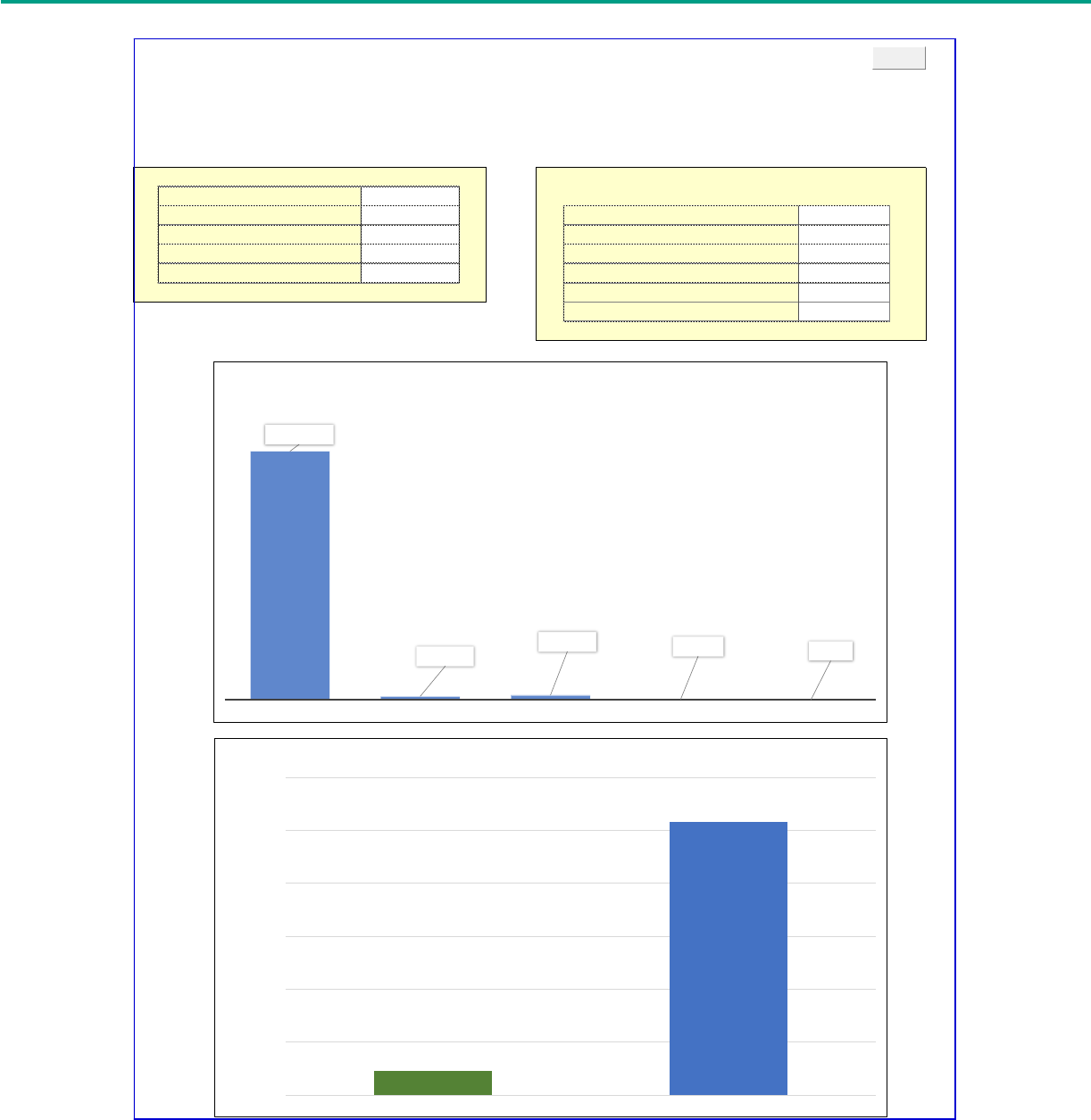
HIGHWAY SAFETY BENEFIT COST ANALYSIS GUIDE CHAPTER 8
131
Figure 25. Chart. Tabular and graphical BCA results from Highway Safety BCA
Tool.
AGENCY:
DOT
DATE
2/14/2018
Present
Present Value Costs ($ Dollars)
$900,000
ITEMIZED BENEFITS ($ Dollars) Value
Present Value Benefits ($ Dollars)
$10,318,036 $9,989,932
Net Present Value ($ Dollars) $9,418,036 $127,027
Benefit / Cost Ratio: 11.46 $182,431
Discount Rate 3.0% $16,749
$1,896
TOTAL BENEFITS $10,318,036
Emissions
Case 1, Alternative 2
Benefit-Cost Analysis Summary Results
Safety
Travel Time
Reliability
Vehicle Operating Cost
$9,989,932
$127,027
$182,431
$16,749
$1,896
SAFETY TRAVEL TIME RELIABILITY VEHICLE OPERATING COST EMISSIONS
Benefits Summary (Present Value, Dollars)
$900,000
$10,318,036
$0
$2,000,000
$4,000,000
$6,000,000
$8,000,000
$10,000,000
$12,000,000
1 2
Benefits vs. Costs (Present Value, Dollars)
Costs
Benefits
Print

HIGHWAY SAFETY BENEFIT COST ANALYSIS GUIDE CHAPTER 8
132
Figure 26 and Figure 27 present examples of tabular displays of BCA results from the FHWA
Tool for Operations Benefit-Cost Analysis (TOPS-BC) and the Clear Roads Cost-Benefit
Analysis Toolkit, respectively.
(37,38)
Similar to the Highway Safety BCA Tool, the TOPS-BC tool
presents the individual benefits for various categories such as travel time, travel time reliability,
energy, and safety; however, these costs and benefits represent annual values rather than net
present values. The Clear Roads tool includes a summary of the project parameters such as the
analysis period, discount rate, and itemized costs. The Clear Roads tool also separates agency
benefits, user (motorist) benefits, and society benefits.
Figure 26. Chart. Tabular BCA results from TOPS-BC tool.
(37)
Choose the active strategies: Benefit/Cost Summary
1 Link Based
Generic Link Analysis
1
1
Signal Coord.
Signal-Central
Signal Coordination: Central Control
2
1
Ramp Metering
RM-Preset
Ramp Metering: Preset Timing
3 Annual Benefits
1 TIM
TIM-FSP
Traffic Incident Management
4 Travel Time $
1
Dynamic Message Sign
ATIS-DMS
Dynamic Message Sign
5
Travel Time Reliability
$
1
Highway Advisory Radio
ATIS-HAR
Highway Advisory Radio
6 Energy $
1
Pre Trip Info
ATIS-511
Pre Trip Traveler Information
7 Safety $
1 HOT
ATDM-HOT
HOT Lanes
8 Other $
1
Hard Shoulder
ATDM-Shoulder
Hard Shoulder Running
9 User Entered $
1 Speed
ATDM-Speed
Speed Harmonization
10 Total Annual Benefits $
1
Weather Sys
Weather Mgmt
Road Weather Management
11
1
Work Zone
WorkZone
Work Zone Systems
12 Annual Costs $
1
Support-TMC
Support-TMC
Traffic Management Center
13
1
Support-Loops
Support-Loops
Loop Detection
14 Benefit/Cost Comparison
1
Support-CCTV
Support-CCTV
CCTV 15 Net Benefit $
Benefit Cost Ratio
Stream of Net Benefits
45,267
183,552
1.72
2.10
107,788
350,132
0
0
19,200
98,464
31,023
106,602
0
21,004
23,412
36,561
121,654
Generic Link
Analysis
Signal
Coordination:
Central Control
0
62,521
166,580
Generic Link Analysis
Signal Coordination: Central Control
Ramp Metering: Preset Timing
Traffic Incident Management
Dynamic Message Sign
Highway Advisory Radio
Pre Trip Traveler Information
HOT Lanes
Hard Shoulder Running
Speed Harmonization
Road Weather Management
Work Zone Systems
Traffic Management Center
Loop Detection
CCTV
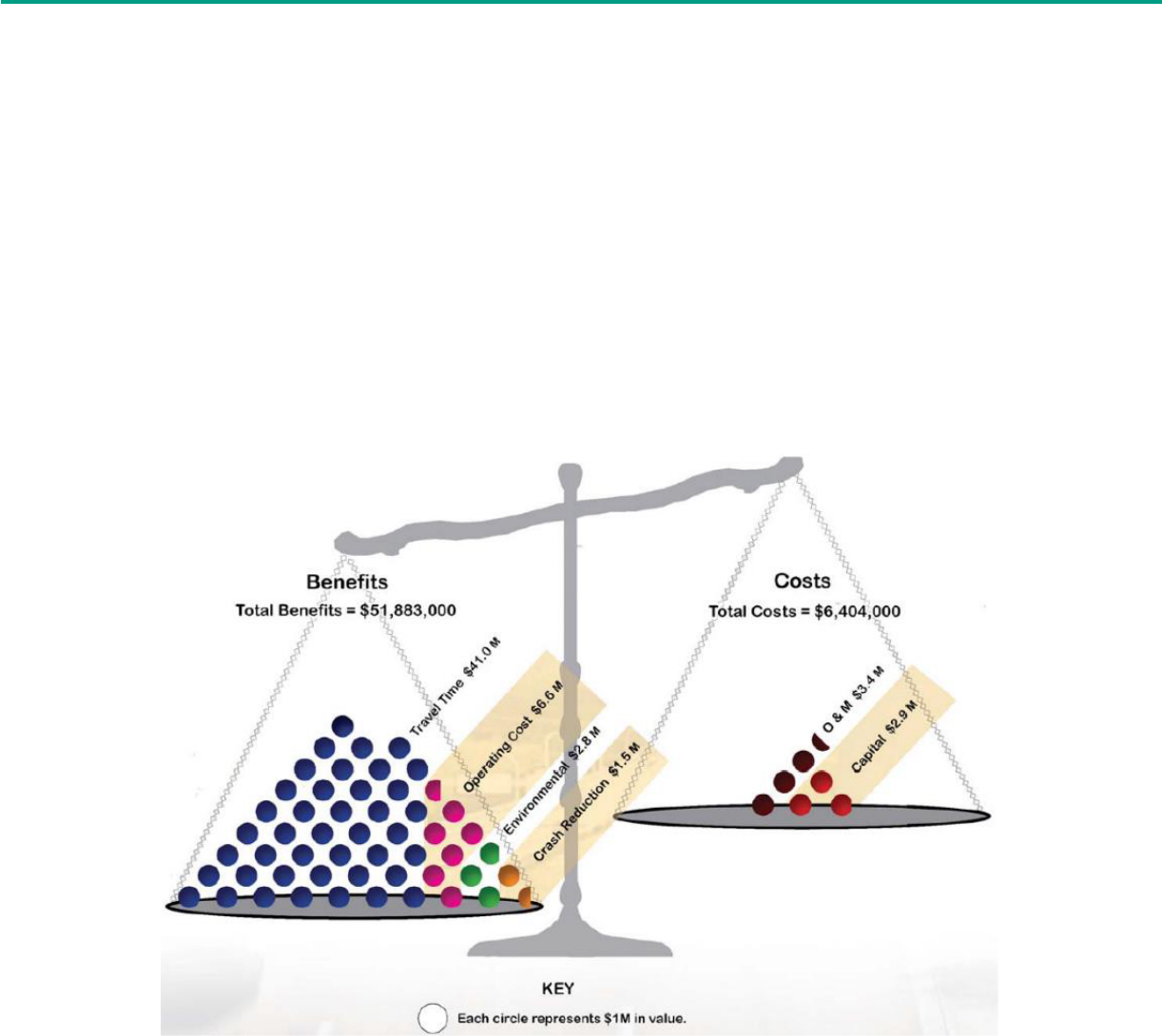
HIGHWAY SAFETY BENEFIT COST ANALYSIS GUIDE CHAPTER 8
134
This tabular output is often all that is needed by decision-makers; however, simple graphics can
enhance communication, providing a visually-informative display of results. Simple graphics can
aid in the understanding and interpretation of results, particularly for public officials and the
public. It may be difficult for a non-technical audience to comprehend and compare numbers in
a table, but a side-by-side graphical comparison, such as a bar chart, provides for much easier
comparison. Several such graphic displays are discussed and displayed below.
Simple graphics can enhance communication of BCA results.
Figure 28 is one example of a simple graphical display from a Kansas City SCOUT program
benefit-cost study. This graphic captures the essence of BCA, which is to provide a comparison
of the benefits received from an expenditure of costs. It also conveys the relative importance of
benefit and cost components to the overall benefit-cost ratio.
Figure 28. Chart. Graphical BCA results from Kansas City SCOUT.
(39)
As another example, the Southwestern Pennsylvania Regional Traffic Signal Program used a
“newsletter” approach to highlight the BCA results for a completed project. Figure 29 shows
the format of this BCA display technique, which includes detailed information about the
project., graphical displays of the first year of user benefits (number of stops and travel time),
the dollar value of total benefits, and the BCR.
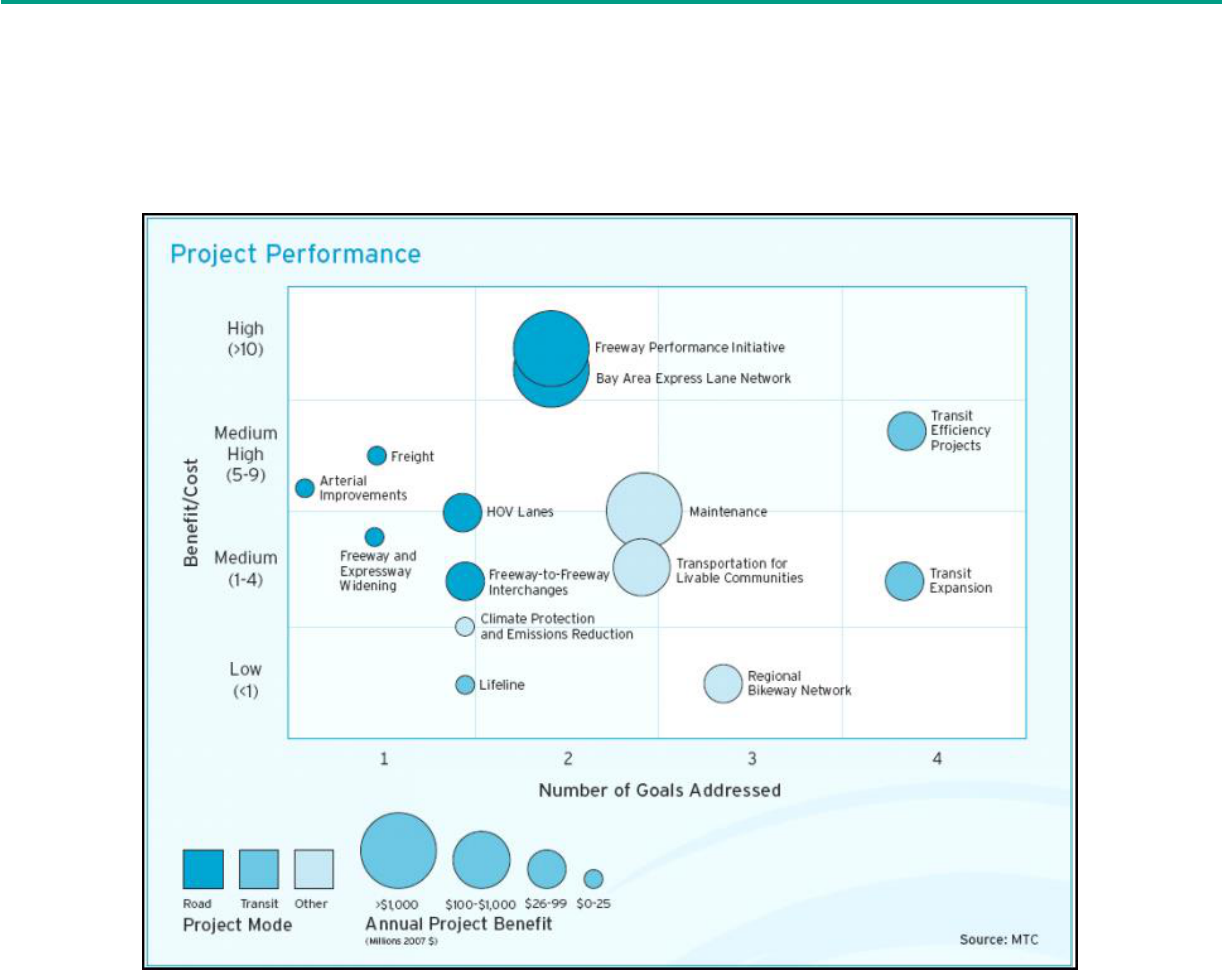
HIGHWAY SAFETY BENEFIT COST ANALYSIS GUIDE CHAPTER 8
136
Finally, graphical displays can seek to present a large amount of information in a single display.
The Metropolitan Transportation Commission (MTC) in the San Francisco Bay Area provided
multimodal BCA evaluation results, displaying the magnitude of the BCA results for each of the
various project performance measures concurrently (see Figure 30).
Figure 30. Chart. Multidimensional graphical BCA results from the Metropolitan
Transportation Commission.
(9)
In addition to communicating the BCA results to decision-makers, analysts can use tabular and
graphical summaries as part of a sensitivity analysis. These displays can help the analyst to
quickly compare the results among selected project assumptions. For example, Table 77
presents the results for the same alternative with two different assumptions for discount rate.
The results are notably different under the two assumptions.

HIGHWAY SAFETY BENEFIT COST ANALYSIS GUIDE CHAPTER 8
137
Analysts can use tabular and graphical
summaries to support sensitivity analysis.
Table 77. BCA results for multiple sites example.
Benefit Category
3% Discount Rate
7% Discount Rate
Crash Benefits
$10,690,130
$7,327,701
Travel Time Benefits
$28,933
$19,832
Vehicle Operating Cost Benefits
$1,858
$1,274
Emissions Benefits
$239
$164
Travel Time Reliability Benefits
$33,098
$23,668
Present Value Benefits ($ Dollars)
$10,754,258
$7,372,639
Present Value Costs ($ Dollars)
$620,356
$508,859
Net Present Value ($ Dollars)
$10,133,902
$6,863,780
Benefit-Cost Ratio
17.34
14.49
8.3 CHAPTER SUMMARY
Chapter 8 presents several considerations and options for communicating BCA results to
decision-makers and other potential audiences. The chapter begins with a discussion of several
considerations for communicating results. It then presents several examples, illustrating tabular
and graphical formats as well as different types of information that may be of interest in a
summary report.
Key Takeaways from Chapter 8:
• The effort to conduct a BCA is unproductive unless decision-makers use the results to
inform decisions.
• Balance tabular information with graphical displays.
• Simple graphics can enhance communication of BCA results.
• Analysts can use tabular and graphical summaries to support sensitivity analysis.

HIGHWAY SAFETY BENEFIT COST ANALYSIS GUIDE CHAPTER 8
138
THIS PAGE IS INTENTIONALLY LEFT BLANK

HIGHWAY SAFETY BENEFIT COST ANALYSIS GUIDE CHAPTER 9
139
9. SUMMARY
The purpose of this Guide is to assist transportation agencies in evaluating the economic
effectiveness and efficiency of projects and programs in support of consistent and sound
decision-making. This Guide introduces the BCA process and describes fundamental concepts
and factors to consider when preparing for BCA. It also describes some of the more complex
analytical concepts and the latest research to support more advanced BCA. Some of the more
advanced topics covered in this Guide include quantifying the long-term safety performance of
alternatives, estimating the safety impacts of multiple countermeasures, and capturing the
derivative safety benefits such as changes in travel time, reliability, delay, and air emissions that
result from fewer crashes.
The following are specific benefits to employing BCA in the roadway safety management and
project development processes:
• Documentation of Decision Process: The discipline of quantifying and valuing the
benefits and costs of highway projects also provides documentation to justify and
explain the decision process to legislatures and the public.
• Cost-Effective Design and Construction: Economic analysis can inform agencies as
to which of several project designs to implement at the lowest lifecycle cost to the
agency, lowest work zone delay cost to the traveler, highest safety benefit to highway
users, and the best affordable balance between these costs.
• Best Return on Investment: Economic analysis can help in planning, programming,
and implementing transportation programs with the best rate of return for any given
budget. It can also help to determine an optimal program budget.
• Understanding Complex Projects: In a time of growing public scrutiny of new and
costly road projects, transportation agencies and other decision makers need to
understand the comprehensive costs and benefits of these projects. A rigorous BCA can
help to quantify and compare the impacts of project alternatives on safety, mobility, the
environment, and regional economies.
A BCA attempts to capture all benefits to society from a project or course of action, and the
cost to achieve those benefits, regardless of which party realizes the benefits and costs, or the
form of these benefits and costs. A BCA should include project costs, user benefits, and non-
user benefits (externalities) to identify the preferred alternative. Ideally, the level of effort that
analysts allocate to quantifying benefits and costs in the BCA should be commensurate to the
expense, complexity, and controversy of the project. Transportation professionals can use BCA
to compare present value costs and benefits among alternatives. Used properly, BCA reveals
the most economically-efficient investment alternative (i.e., the one that maximizes the net
benefits to society relative to the allocation of resources).

HIGHWAY SAFETY BENEFIT COST ANALYSIS GUIDE CHAPTER 9
140
A BCA differentiates costs and benefits by project costs (or agency costs), project benefits (or
user benefits), and externalities (or non-user benefits). Project benefits and externalities include
costs avoided, but also include negative benefits (disbenefits) such as increased crashes or air
emissions. Analysts monetize project benefits by assigning dollar values to the different effects.
Project costs should include an accounting of all public-sector and private-sector costs, when
applicable. These costs represent:
• Initial capital costs of implementing the project, including planning, design,
construction/installation, and equipment costs.
• Continuing operations and maintenance costs necessary to keep the project operational,
including items such as power, communications, labor, and routine maintenance
(excludes replacement costs).
• Replacement cost of equipment that reaches the end of its useful life during the time
horizon of the analysis.
• “End of Project” costs necessary to close temporary projects or any residual or salvage
value of equipment at the end of the time horizon of the analysis.
Project benefits include reductions in crash frequency and severity, travel time and delay, and
vehicle operating costs. Externalities (or non-user benefits) include reductions in air emissions,
noise, and impacts to natural habitat and wetlands. These benefits and externalities may be a
direct benefit from the project or a residual benefit from a reduction in crashes.
Measuring the benefits of a safety project first requires estimates for the measures in the base
condition (e.g., the do-nothing alternative). The BCA estimates project benefits by calculating
changes between the base condition and project alternative(s). Where possible, the analyst
should estimate the safety benefits based on predicted or expected crash frequency rather than
observed crash frequency. A BCA uses the following measures to quantify project benefits and
disbenefits:
• Safety (frequency and severity of crashes).
• Mobility (travel time).
• Reliability (total delay).
• Vehicle operating cost (fuel and nonfuel use costs).
• Environment (emissions).
In BCA, the transportation professional applies a discount rate to the future annual benefits and
costs. The discount rate is the rate at which predicted cash expenditures (costs) or inflows
(benefits) decline in future years to reflect the time value of money. Once the analyst has
converted all benefits and costs to present values, there are several measures analysts can use
to compare alternatives in a BCA:

HIGHWAY SAFETY BENEFIT COST ANALYSIS GUIDE CHAPTER 9
141
• Benefit-cost ratio (BCR): The BCR is the ratio of present value benefits (including
negative benefits) to present value costs (initial and continuing costs over the project
lifecycle). In this context, the BCR is the same as the rate of return and return on
investment. A BCR greater than 1.0 indicates that benefits exceed costs, and the project
is economically justified. In general, a higher BCR is desirable. The BCR is most
appropriate for prioritizing project alternatives when funding restrictions apply (e.g.,
prioritizing locations or alternatives within a project with a fixed budget).
• Net present value (NPV): The NPV is the difference between present value benefits
and present value costs. NPV is also referred to as net benefits or net present worth. If
the NPV is greater than 0.0, then the benefits exceed the costs, and the project is
economically justified. In general, a higher NPV is desirable. An agency can use NPV to
determine the alternative with the highest net benefits for a given project.
• Cost-effectiveness index (CEI): The CEI is the average cost of a project to reduce
one crash. The CEI is calculated by dividing the present value cost (PVC) by the
expected crashes reduced over the service life of the project. In general, a low CEI is
desirable. The CEI is typically based on total crashes, but can be expressed in terms of a
specific crash type or severity level (e.g., cost to reduce one fatal and serious injury
crash). The CEI does not account for the magnitude of monetary benefits. As such, it is
not an appropriate measure to justify projects economically. It can, however, serve as a
measure when it is difficult to monetize benefits (e.g., the cost per new transit rider).
USDOT recommends analysts use the NPV or BCR for most economic evaluations. Both
measures used in combination, as well as standalone present value costs and benefits, will
provide better information to agencies. If benefits exceed costs, the NPV is positive and the
BCR is greater than 1.0, indicating the project is potentially economically justifiable. Where two
or more alternatives for a project exist, the one with the highest NPV over an equivalent
analysis period provides the most net benefits. Within a budget, maximizing BCR among
countermeasures or locations within a project provides the greatest economic efficiency. Policy
considerations, perceived risk, funding availability, and other influences may also affect the
selection of an alternative. Analysts may use other available BCA measures depending on the
technical problem or the agency policy or preference.
In summary, BCA is critical to understanding the potential return on investment from potential
projects. Highway safety BCA allows State and local agencies to quantify and assess safety
impacts alongside other decision factors such as operational efficiency, environmental impacts,
and pavement preservation. While BCA is a policy or procedure decision, this Guide and
related spreadsheet tool will assist agencies in justifying the need to perform BCA, identifying
appropriate inputs and parameters for analysis, and conducting sound highway safety BCA to
evaluate the economic effectiveness and efficiency of projects. A reliable BCA will help to
inform decisions and improve investments.

HIGHWAY SAFETY BENEFIT COST ANALYSIS GUIDE CHAPTER 9
142
THIS PAGE IS INTENTIONALLY LEFT BLANK

HIGHWAY SAFETY BENEFIT COST ANALYSIS GUIDE REFERENCES
143
REFERENCES
1. Sallman, D., E. Flanigan, K. Jeannotte, C. Hedden, and D. Morallos, Operations Benefit/Cost
Analysis Desk Reference, FHWA-HOP-12-028, Federal Highway Administration,
Washington, DC, 2012. Accessed February 2018 at:
http://ops.fhwa.dot.gov/publications/fhwahop12028/fhwahop12028.pdf.
2. Srinivasan, R., F. Gross, B. Lan, and G. Bahar. Reliability of Safety Management Methods:
Network Screening, FHWA-SA-16-037, Federal Highway Administration, Washington,
DC, 2016.
3. Srinivasan, R., G. Bahar, and F. Gross. Reliability of Safety Management Methods: Diagnosis,
Report No. FHWA-SA-16-038, Federal Highway Administration, Washington, D.C.,
November 2016.
4. Bahar, G., R. Srinivasan, and F. Gross. Reliability of Safety Management Methods:
Countermeasure Selection, Report No. FHWA-SA-16-039, Federal Highway
Administration, Washington, D.C., August 2016.
5. Code of Federal Regulations, Highway Safety Improvement Program, 23 CFR 924.3,
Accessed February 2018 at:
https://www.fhwa.dot.gov/legsregs/directives/fapg/cfr0924.htm.
6. Gross, F., T. Harmon, G. Bahar, and K. Peach. Reliability of Safety Management Methods:
Systemic Safety Programs, FHWA-SA-16-041, Federal Highway Administration,
Washington, DC, 2016.
7. American Association of State Highway and Transportation Officials (AASHTO),
Highway Safety Manual, 1
st
Edition, 2010.
8. US Department of Transportation, Economic Analysis Primer, FHWA-IF-03-032, Federal
Highway Administration, Washington, DC, 2003. Accessed February 2018 at:
http://www.webpages.uidaho.edu/~mlowry/Teaching/EngineeringEconomy/Supplemental/
USDOT_Economic_Analysis_Primer.pdf.
9. Lawrence, M., P. Nguyen, J. Skolnick, J. Symoun, J. Hunt, and R. Alfelor. Transportation
Systems Management and Operations Benefit-Cost Analysis Compendium, FHWA-HOP-14-
032, Federal Highway Administration, Washington, DC, 2015. Accessed February 2018
at: https://ops.fhwa.dot.gov/publications/fhwahop14032/index.htm.
10. Harmon, T., G. Bahar, and F. Gross. Crash Costs for Highway Safety Analysis, FHWA-SA-
17-071, Federal Highway Administration, Washington, DC, 2018. Accessed February
2018 at: https://safety.fhwa.dot.gov/hsip/planning.cfm.

HIGHWAY SAFETY BENEFIT COST ANALYSIS GUIDE REFERENCES
144
11. Blincoe, L.J., T.R. Miller, E. Zaloshnja, and B.A. Lawrence. The Economic and Societal
Impact Of Motor Vehicle Crashes, 2010 (Revised), DOT-HS-812-013, National Highway
Traffic Safety Administration, Washington, DC, 2015. Accessed February 2018 at:
https://crashstats.nhtsa.dot.gov/Api/Public/ViewPublication/812013.
12. US Department of Transportation, Life-Cycle Cost Analysis Primer, Federal Highway
Administration, Washington, DC, 2002. Accessed February 2018 at:
https://www.fhwa.dot.gov/asset/lcca/010621.pdf.
13. US Department of Transportation, Benefit-Cost Analysis Guidance for TIGER and INFRA
Applications, Office of the Secretary, Washington, DC, 2017. Accessed February 2018 at:
https://www.transportation.gov/office-policy/transportation-policy/benefit-cost-analysis-
guidance.
14. Herbel, S., L. Laing, and C. McGovern, Highway Safety Improvement Program Manual,
FHWA-SA-09-029, Federal Highway Administration, Washington, DC, 2010. Accessed
February 2018 at:
http://safety.fhwa.dot.gov/hsip/resources/fhwasa09029/fhwasa09029.pdf.
15. CMF Clearinghouse. Federal Highway Administration, Washington, DC. Accessed
February 2018 at: http://www.cmfclearinghouse.org.
16. Transportation Research Board. Determining Highway Maintenance Costs, Report 688,
National Cooperative Highway Research Program, Washington, DC, 2011. Accessed
February 2018 at: http://www.trb.org/Publications/Blurbs/165504.aspx.
17. Smith, S. and K. Signor. Synthesis of Countermeasure Cost User Guide, FHWA-SA-16-012,
Federal Highway Administration, Washington, DC, 2017. Accessed February 2018 at:
http://www.cmfclearinghouse.org/resources_synthesisofcountermeasurecosts.cfm.
18. US Department of Transportation, Service Life and Crash Cost User Guide, Federal
Highway Administration, Washington, DC, 2017. Accessed February 2018 at:
http://www.cmfclearinghouse.org/resources_servlifecrashcostguide.cfm.
19. Adams, T.M. Estimating Cost Per Lane Mile for Routine Highway Operations and
Maintenance, MRUTC 07-12, Wisconsin Department of Transportation, Madison, WI,
2011. Accessed February 2018 at: http://www.wistrans.org/mrutc/files/CPLM_Final.pdf.
20. US Department of Transportation. MMUCC Guideline—Model Minimum Uniform
Crash Criteria 5
th
Edition, DOT-HS-812-433, National Highway Traffic Safety
Administration, July 2017. Accessed February 2018 at:
https://crashstats.nhtsa.dot.gov/Api/Public/Publication/812433.

HIGHWAY SAFETY BENEFIT COST ANALYSIS GUIDE REFERENCES
145
21. Association for the Advancement of Automotive Medicine. Abbreviated Injury Scale, 2015.
Accessed February 2018 at: https://www.aaam.org/abbreviated-injury-scale-ais/.
22. Hagemann, G., K. Hymel, A. Klauber, D.B. Lee, G. Noel, D. Pace, and C. Taylor. Delay
and Environmental Costs of Truck Crashes. FMCSA-RRA-13-043, Federal Motor Carrier
Safety Administration, Washington, DC, 2013. Accessed February 2018 at:
https://rosap.ntl.bts.gov/view/dot/10074.
23. US Department of Transportation, Tiger Benefit-Cost Analysis (BCA) Resource Guide,
3/27/15, Accessed February 2018 at:
https://www.transportation.gov/sites/dot.gov/files/docs/Tiger_Benefit-
Cost_Analysis_%28BCA%29_Resource_Guide_1.pdf.
24. Memorandum to Secretarial Officers and Modal Administrators, “Revised Departmental
Guidance on Valuation of Travel Time in Economic Analysis” from Polly Trottenberg,
Assistant Secretary for Transportation Policy, Prepared by Peter Belenky, Economist,
September 29, 2011.
25. Victoria Transport Policy Institute, Transportation Cost and Benefit Analysis II – Travel Time
Costs, January 2017, Accessed February 2018 at: http://www.vtpi.org/tca/tca0502.pdf.
26. Mallett, W., C. Jones, J. Sedor, and J. Short. Freight Performance Measurement: Travel Time
in Freight-Significant Corridors, FHWA-HOP-07-071, Federal Highway Administration,
Washington, DC, 2006. Accessed February 2018 at:
http://ops.fhwa.dot.gov/freight/freight_analysis/perform_meas/fpmtraveltime/traveltimebr
ochure.pdf.
27. Transportation Research Board. Analytical Procedures for Determining the Impacts of
Reliability Mitigation Strategies, S2-L03-RR-1, Second Strategic Highway Research Program,
Washington, DC, 2013, Accessed February 2018 at:
http://www.trb.org/Publications/Blurbs/166935.aspx.
28. US Department of Transportation. Travel Time Reliability: Making it There on Time, All the
Time, FHWA-HOP-06-070, Federal Highway Administration, Washington, DC, 2006,
Accessed February 2018 at:
https://ops.fhwa.dot.gov/publications/tt_reliability/TTR_Report.htm.
29. US Energy Information Administration. Annual Energy Outlook, 2017 with projections to
2050, Washington, DC, January 5, 2017. Accessed February 2018 at: www.eia.gov/aeo.
30. US Energy Information Administration. Gasoline and Diesel Fuel Update, Washington, DC.
Accessed February 2017 at: https://www.eia.gov/petroleum/gasdiesel/.

HIGHWAY SAFETY BENEFIT COST ANALYSIS GUIDE REFERENCES
146
31. American Automobile Association, Your Driving Costs – 2016 Edition (2016), AAA
Association Communication, Heathrow, FL, 2016. Accessed February 2018 at:
http://exchange.aaa.com/automotive/driving-costs/#.WVZdF02oupp.
32. Torrey, W.F. and D. Murray. An Analysis of the Operational Costs of Trucking: 2016 Update
(2016), American Transportation Research Institute, Arlington, Virginia, September
2016. Accessed February 2018 at: http://atri-online.org/wp-
content/uploads/2016/10/ATRI-Operational-Costs-of-Trucking-2016-09-2016.pdf.
33. US Department of Labor. Archived Consumer Price Index Detailed Reports. Bureau of Labor
Statistics, August 2017. Accessed February 2018 at: https://www.bls.gov/cpi/detailed-
report.htm.
34. US Department of Transportation, Crash Modification Factors in Practice—Quantifying
Safety in the Roadway Safety Management Process, FHWA-SA-13-010, Federal Highway
Administration, Washington, DC, 2013. Accessed February 2018 at:
https://safety.fhwa.dot.gov/tools/crf/resources/cmfs/management.cfm.
35. Carter, D., R. Srinivasan, B. Persaud, C. Lyon, F. Gross, S. Himes, T. Le, J. Bonneson, and
E. Hauer. Guidance for the Development and Application of Crash Modification Factors. Final
Report, Project 17-63, National Cooperative Highway Research Program, Washington,
DC, March 2017.
36. Transportation Research Board, Development of Tools for Assessing Wider Economic
Benefits of Transportation, S2-C11-RW-1, Second Strategic Highway Research Program,
Washington, DC, 2014. Accessed February 2018 at:
http://www.trb.org/Publications/Blurbs/169524.aspx.
37. US Department of Transportation, Tool for Operations Benefit-Cost Analysis, Federal
Highway Administration, Washington, DC. Accessed February 2018 at:
https://ops.fhwa.dot.gov/plan4ops/topsbctool/index.htm.
38. Clear Roads Cost-Benefit Analysis Toolkit: Accessed February 2018 at:
http://clearroads.org/cba-toolkit/terms.html.
39. Kansas and Missouri Departments of Transportation, Kansas City Scout Annual Report,
2015. Accessed February 2018 at:
http://www.kcscout.net/downloads/Reports/Annual/AnnualReport2015.pdf.

HIGHWAY SAFETY BENEFIT COST ANALYSIS GUIDE APPENDIX A
147
APPENDIX A: GLOSSARY OF TERMS
TERM
DEFINITION
Benefit-Cost Analysis
A systematic process for calculating and comparing benefits
and costs of a project.
Benefit/Cost Ratio
Measure calculated by dividing the incremental monetized
benefits related to a project by the incremental costs of that
project. May either be expressed as a ratio (2:1) or a
resultant value (2). B/C ratios greater than one indicate that
a project is efficient (benefits exceed costs). B/C ratios less
than one indicate that a project is inefficient (costs exceed
benefits).
Countermeasure
Roadway-based strategy intended to reduce the crash
frequency or severity, or both at a site.
Crash Modification Factor
Multiplicative factor used to compute the expected number
of crashes after implementing a given countermeasure.
Crash Reduction Factor
The percentage crash reduction that might be expected after
implementing a given countermeasure.
Direct Benefits
Those measurable benefits that may be directly attributed to
the project investment.
Discount Rate
The rate at which predicted cash expenditures (costs) or
inflows (benefits) are reduced in future years to reflect the
time cost of money. The purpose of the discount rate is to
convert future values to present value.
Efficient
Projects determined to have benefits greater than their costs
and are economically justifiable (B/C ratio greater than one).
Externality
The uncompensated impact of one person's actions on the
well-being of a bystander. In the case of transportation
investments, "bystanders" are the nonusers of the project.
When the impact benefits the nonuser, this is called a
positive externality. When the impact is adverse, this is
called a negative externality.
Inefficient
Projects determined to have benefits less than their costs
and are economically unjustifiable (B/C ratio less than one).
Life-Cycle Costs
All costs accruing to highway agencies and to users of the
highway system as a result of agency construction and
maintenance activities. These costs include initial
construction, maintenance, rehabilitation and end-of-life

HIGHWAY SAFETY BENEFIT COST ANALYSIS GUIDE APPENDIX A
148
TERM
DEFINITION
costs, as well as user costs such as vehicle operating, travel
time and crash costs associated with work zones.
Measure of Effectiveness
Metric used to evaluate the level of impact of a project.
Net Benefit
The sum of a project benefits minus the sum of the project
costs.
Net Present Value
The sum of the discounted stream of expected benefits and
costs over a selected time horizon.
Operations and Maintenance
Costs
The continuing costs necessary to keep the project
performing as planned, including items, such as power,
communications, labor, and routine maintenance.
Replacement Costs
The cost of replacing equipment that reaches the end of its
useful life during the time horizon of the analysis.
Safety Performance Function
An equation used to predict the average number of crashes
per year at a location as a function of exposure and, in some
cases, roadway or intersection characteristics.
Time Cost of Money
The impact of time on the value of future benefits and costs.
Money spent or earned today is more valuable than the same
amount of money promised in a future year since the money
earned today can be invested and earn additional revenue in
the interim years. Therefore, benefits and costs accruing in
later years of an analysis are often valued at a discounted
rate.
Value of a Statistical Life
Additional cost that individuals would be willing to bear for
improvements in safety (that is, reductions in risks) that, in
the aggregate, reduce the expected number of fatalities by
one.

For More Information:
Visit https://safety.fhwa.dot.gov/
FHWA, Office of Safety
Karen Scurry
609-637-4207
FHWA-SA-18-001
